Our Archived Stories Are Here:
There are a lot of them: We've been doing this since 2005.
If you want the current news, please click here. Otherwise, have fun!
Land Auction in Bird City
August 15, 2019
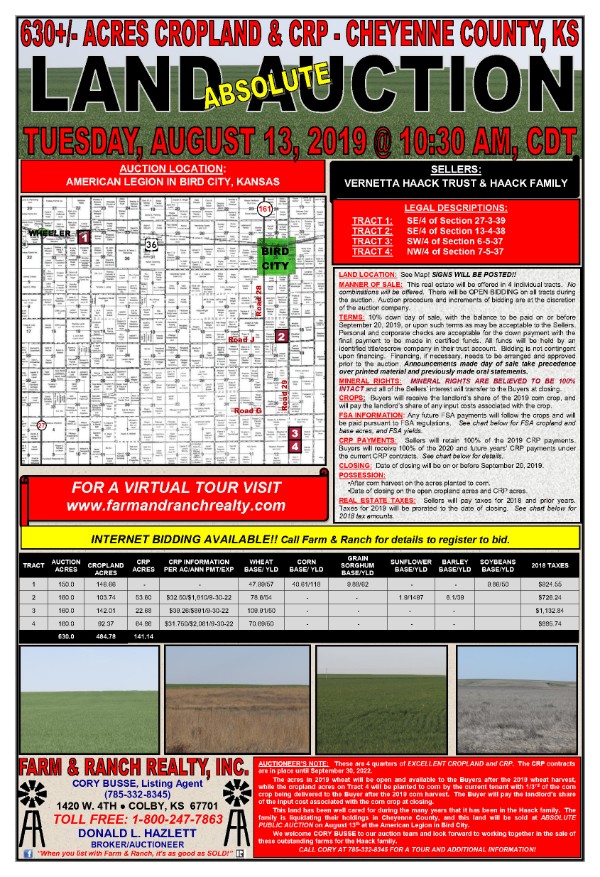
On August 13, 2019, a land auction in Bird sold 630 acres of crop land and CRP. The CRP totaled 141 acres, leaving 489 acres of farm ground.
We couldn't attend, because we were flying over corn crops, but we later talked with a knowledgeable attendee who thought that the sale was well attended with generally spirited bidding.
According to the Farm & Ranch Realty, Inc. website, the land sold in four tracts (see the image of the flyer), and the final prices were these: Tract 1: $1,650/ac, Tract 2: $1,125/ac, Tract 3: $1,300/ac, Tract 4: $1,275/ac. We did the math, and that is a average is $1,337 per acre.
For more information, please check out the Farm & Ranch Realty, Inc. website here.
Wheat Variety Test Results
August 9, 2019
We reported here on the June 12, 2019, K-State Wheat Variety Demonstration Plots sponsored by Sunny Crest Farm, Jeanne Falk-Jones, and Kansas State University.
The final results for 2019 are now published, and we are posting them here for easy reference. There are results for several counties, and both irrigated and dryland in some counties. Please click on the links below to see the PDF files for each result.
Click here: Cheyenne County, Sunny Crest Farm; <> Sherman County; <> Colby, KS, dryland; <> Colby, KS, irrigated; <> Burlington, Colorado; <> Tribune, Kansas; <> Wallace County.
Corn Insect Update
July 21, 2019
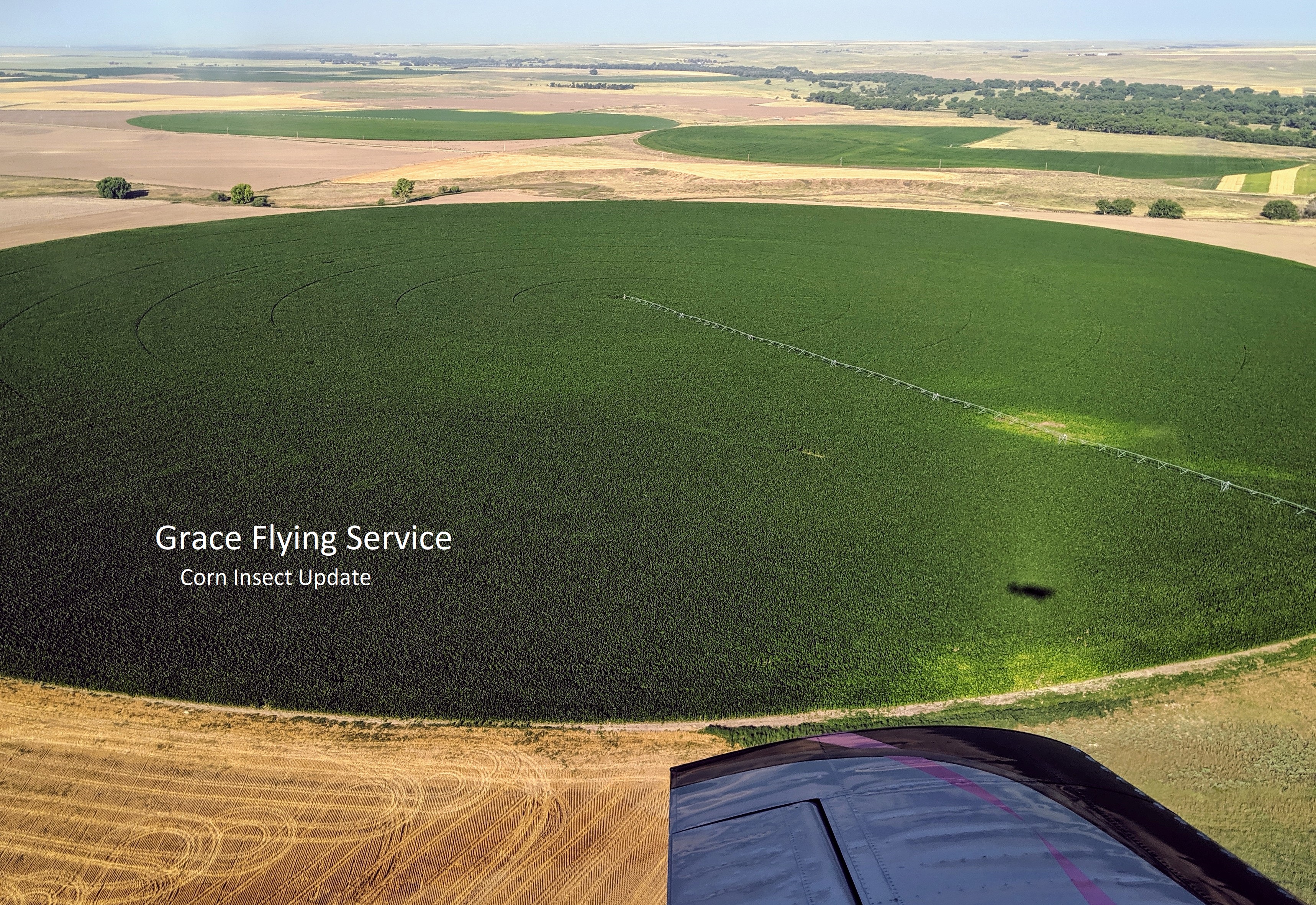
We recently mailed a corn insect postcard to our customers. The postcard notes that three common corn insects now are rootworm beetles, Western Bean Cutworm, and spider mites.
Beetle control will stop silk clipping, and reduce egg laying for rootworm control next spring. For beetles and WBC, the two main options are bifenthrin (generic Capture) and Steward. Steward is about $7/acre more, but it does not damage beneficial insects, which reduces mite flaring. Reduced mite pressure could save money in later mite control, and might decrease yield loss from mite pressure.
Spider mite options include Portal, Onager, and Comite. All three products control eggs via early application, and have good residual in the field, with Portal possibly having a slightly shorter control period.
New aggressive pricing of Onager makes it price competitive. Both Portal and Onager have a 12 hour REI. Comite is still a good product, but has a very long REI--13 days--which can negatively affect sprinkler repair options.
These applications can be tank mixed with both CoRoN and tebuconazole. The CoRoN is a foliar feed, valuable if you need a nitrogen boost.
Tebuconazole controls gray leaf spot (GLS) and various rusts, and may boost yield by slowing the ripening process. Tebuconazole is inexpensive--a little more than $3/acre--and can provide big benefits.
Wheat Harvest Winds Down
July 19, 2019
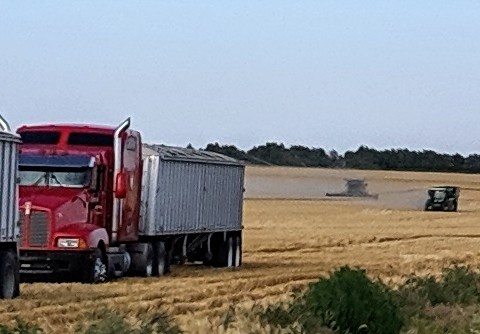
Wheat harvest in the tri-state area arrived late this year, but hot, dry weather during the harvest season allowed for a fast cutting period. Despite the late start, the harvest is nearly complete.
The growing season was nearly perfect for wheat, with a cool spring with adequate moisture, which allowed for a long, slow kernel filling period. In addition, there was minimal hail damage, which was a nice change from the last two seasons.
Accordingly, many of the yields were excellent, with several fields reported at over 100 bushels/acre. Years from now, wheat farmers will remember the 2019 season with admiration and longing.
Wheat Variety Test Plots 2019
June 18, 2019
The annual K-State Wheat Variety Demonstration Plots gathering was held June 12, 2019, at the traditional location, five miles south of Wheeler, Kansas. It was lovely weather, and there was a good turnout of perhaps 45 people. The event is sponsored by Sunny Crest Farm, Jeanne Falk-Jones, and Kansas State University. Attending again this year were two wheat specialists, Dr. Erick De Wolf and Dr. Lucas Haag.
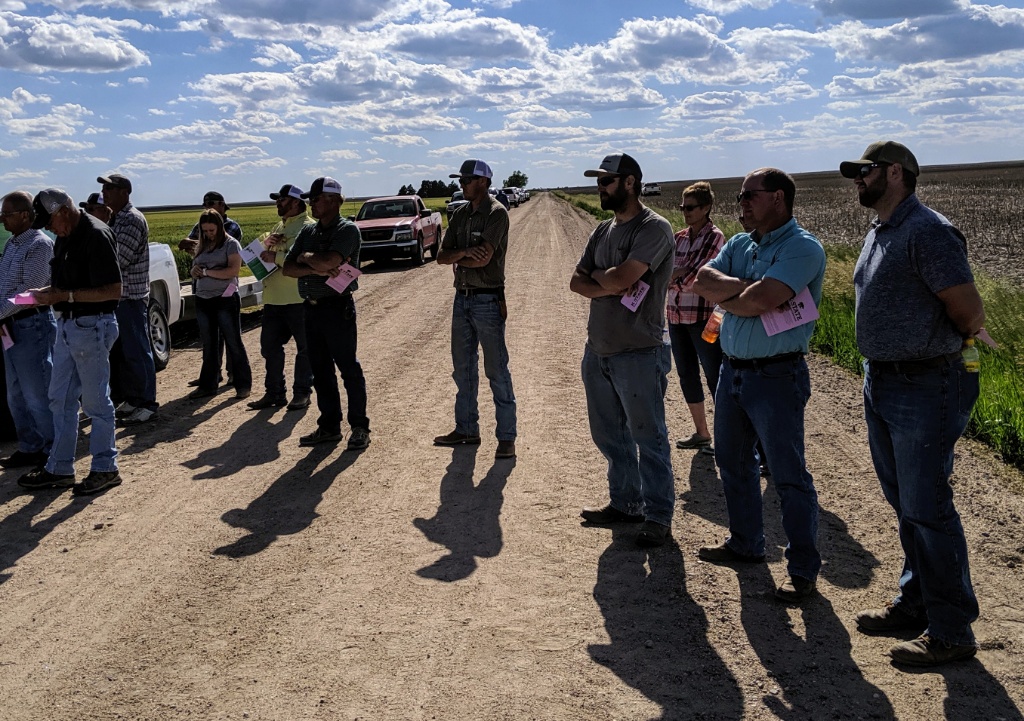
The wheat condition was excellent, and there were predictions of high yields, possibly better than those in eastern Kansas. It was agreed that the wheat harvest will be later than normal, and Dr. Haag said he thought it could be delayed by as much as ten days.
Dr. De Wolf talked about wheat rust, since much of the area wheat has been treated for that disease. De Wolf said that several varieties that were resistant last year are now more susceptible, and that K-State will update their disease ratings on wheat varieties later this year. He also said that while leaf and stripe rust are still the most likely manifestations, he is seeing more stem rust in the wheat.
Stem rust is worrisome, De Wolf added, because it comes at a different time in the season, which makes the timing of the fungicide application more difficult to determine. It is possible that fungicide will have to be applied slightly earlier if stem rust becomes an issue.
As always, there was a lot of information presented, including a detailed pamphlet with a lot of information on the plots. The 2018 results for Thomas county are here.
When the 2019 results are published, we will post them here on the website. Our thanks to Sunny Crest Farm, K-State and Jeanne for their combined efforts to provide a lot of valuable information about wheat varieties. It is a great program!
We've Got Help!
May 27, 2019
Wheat rust spraying is in full swing, and Paul Soulek, Ascend Ag Aviation, Spearfish, SD, has his fine Air Tractor 502 XP here to help us ensure a quick response for our customers. Paul arrived Sunday night after a difficult flight in turbulent spring weather, and he sprayed a lot of acres today. We appreciate his efforts!

We are flying every minute that the weather will allow us to do so. Our goal is get our customers treated as soon as possible. It has been a trying spring, because we are not only battling the wind, but also a lot of low-visibility foggy mornings. But when all three airplanes are in the air, we are covering acres quickly.
As this is written, the rust pressure is still light, but treatment early is the best course, both for protection from the disease and the possible yield boost from plant health effects.
The bottom line is that we are going full-speed ahead to get the acres covered.
Wheat Rust Postcard
May 16, 2019
We recently sent a customer postcard with the image shown.

As the photo shows, our area has suffered weather conditions conducive to both stripe and leaf rust in wheat. Additionally, KSU is reporting that several wheat varieties previously considered resistant are more susceptible than last year.
Worth noting, in Hamilton County, Kansas, the wheat has widespread rust and treatment operations are full speed ahead.
However, as this is written, there is no rust reported in our area, and the wheat is now in the early flag-leaf stage. Flag leaf is the ideal time to treat. As always, it is a complex situation.
Rust treatment with tebuconazole is effective and economical, despite the low wheat prices. If your disease pressure is light, you should target treatments to susceptible varieties and high yield potentials.
For most fields, we think that careful and continued scouting is the best course of action. The rust could still arrive, but in many cases treatment is not yet indicated.
Here are some links from K-State agronomy, if you'd like to read more:
For images of rust, and some scouting tips, please click here.
For a PDF from K-State listing the susceptible varieties from 2018, please click here.
To read Erick DeWolf's latest summary and which wheat varieties are more susceptible this year than in the past, please please click here.
Honor Students Recognized
May 7, 2019

Grace Flying Service is happy to announce the 2019 Honor Students from the Cheylin, Idalia, and Saint Francis High Schools.
A complete list of Honor Students--more than 400 names in all--beginning in 2005, are listed here or by clicking on the image.
Every May, we provide a letter of commendation and a small momento to the top five students in the Freshman, Sophomore, Junior, and Senior classes at the three local high schools: Cheylin, Idalia, and Saint Francis.
The Honor Student Program is free to the schools and is our way of saying "thank you!" to those students who strive for academic excellence. It's a great group of young adults: you can read more about the program here.
Wheat Rust? Well, Maybe...
May 1, 2019
Jeanne Falk-Jones, K-State Multi-County Agronomist, sent out an email update on wheat rust on April 23, 2019.
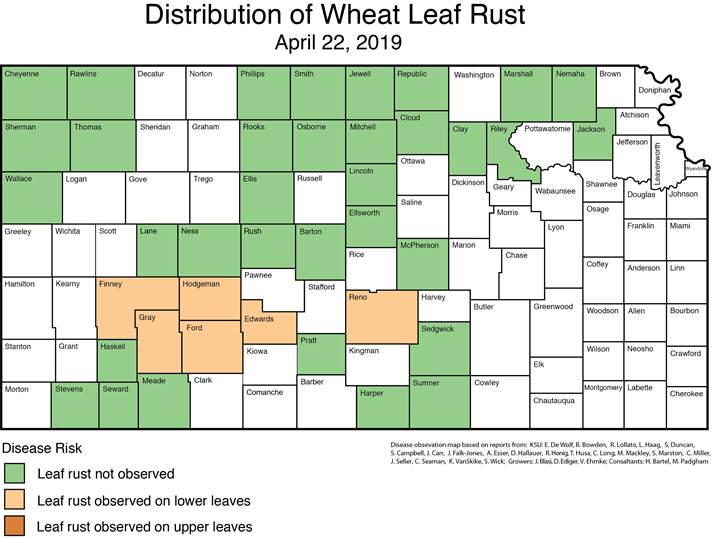
Jeanne says that reports from the south of us--in Texas and Oklahoma--are relevant because the spores move northward on the wind. She says that, "Leaf rust and stripe rust were found in low incidence last week in south-central Kansas by a UDSA plant pathologist and wheat breeder as they were checking research plots in Reno County... So far, it appears to be leaf rust that is most active but stripe rust is also present. The disease is still at low levels and restricted to the low and mid canopy."
Jeanne adds that rust diseases were only found in susceptible varieties, and generally at low incidences--less than 1%. Jeanne has been scouting for rust in our area, and has found no leaf or stripe rust. (See the rust map image.)
The reports from Texas were spotty, and in Oklahoma, the report from OSU said, "...rust (is) beginning to increase in severity in southwest Oklahoma. This is primarily leaf rust that is being reported and it is quickly approaching a time for the growers in southwest Oklahoma to make a decision about treating with a fungicide."
Jeanne concludes by saying, "For northwest Kansas, there is no need for you to make management decisions based on these reports right now. The timing for fungicide applications is when there are flag leaves emerging and rust present on leaves just below the flag leaf."
We agree: It is too early to predict the need for fungicides in wheat in our area.
Republican River Restoration Meeting
April 28, 2019
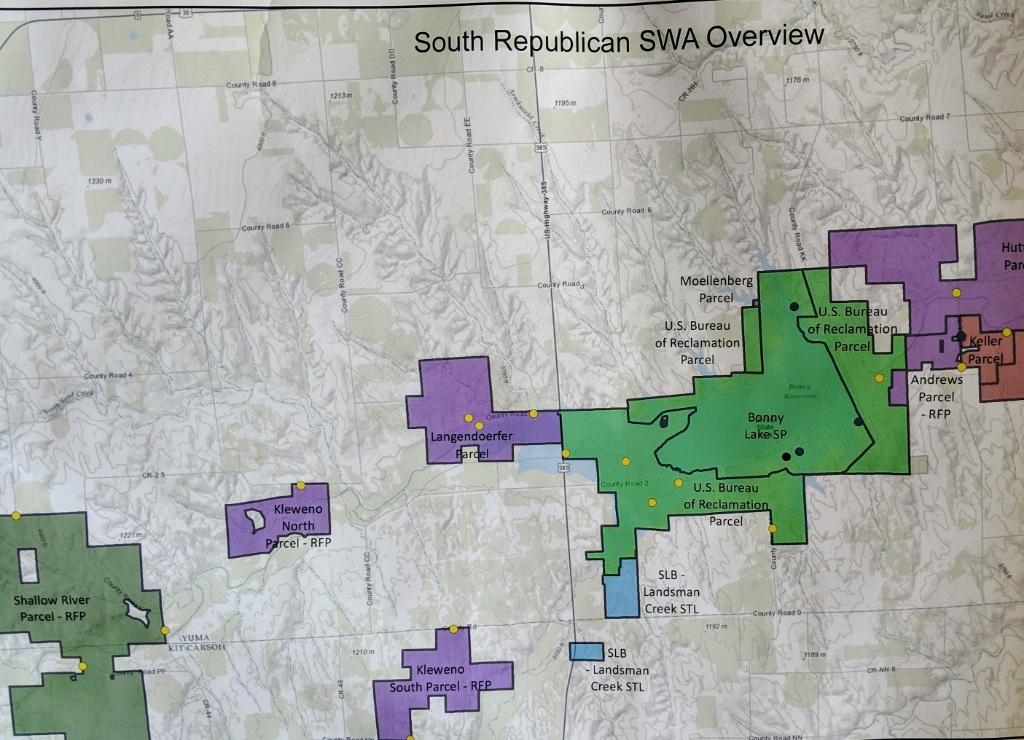
Back on March 20th, we attended the South Fork Republican River Restoration Coalition meeting that we announced here. The meeting was postponed a few days due to weather concerns. It's a complicated issue, but here is a brief summary:
The meeting was held in the Idalia school, a very nice building with an excellent meeting room. There were at least forty people in the room, with six people at the head table, and several large photos on the walls for inspection. This was the third meeting of the coalition, but our first attendance.
Robin Wiley, Yuma County Commissioner, acted as moderator. There were many constituencies represented, including the Nature Conservancy, the Colorado State Water Conservation Board, Colorado Agricultural Preservation Association, Colorado Parks and Wildlife, some irrigation interests, and a representative of state Senator Gardner.
The main thrust of the meeting was a technical discussion by an engineering firm who discussed the issues of competing interests, the history of the geography, including prior to the building of Bonny Dam, during its existence, and since it has been drained. These discussions included the topography, the vegetation patterns, hydrology, the riparian forest, and animal species and habitats affected. Since dam drainage, there has been an increase in undesirable plant species, including salt cedar, Russian Olive trees, cattail and kochia. The gradient of the river has changed, and is now too shallow, and the large amount of sandy sediment that has accrued is a major issue. The existing dam structure also impedes flow and causes problems.
Possible solutions include straightening the river channel, increasing the gradient with large-scale soil movement, or using underground piping to move the water past the existing dam. In addition, there may need to be much vegetative removal of (at least) non-native species, and some consideration is being given to creating small ponds for wild life benefits. The Water Compact--the agreement between the states of Colorado, Nebraska, and Kansas defining the sharing of the river's water--mandates moving the water downstream. This is a conflict because Colorado irrigators would prefer to utilize the water for crops, and those who represent wildlife inerests want to keep the water for that purpose, neither moving it downstream nor allowing irrigation. Finally, the hunting interests have a slightly different objective from all of the above groups.
Essentially, the only thing that everyone in the room actually agrees upon is that the present situation needs changed. But the desired outcome is seen very differently by the various groups. And even if all of the interests could agree on a final outcome, the project will certainly be very expensive, although no one seems to have exact cost estimates. And no one at the meeting mentioned any possible funding sources.
We wish them luck: we agree that improving the old Bonny Dam area would be a wonderful addition to the area.
If you'd like to read more, here is the website of the South Fork Republican Restoration Coalition.
Wheat Rust Outlook 2019
April 2, 2019

While most area farmers are likely more worried about treating mustard and other summer annual weeds in their wheat right now than about stripe rust (see our postcard article below), K-State is working on predicting the severity of stripe rust later in the season.
A recent K-State Extension Agronomy eUpdate article predicts a moderate risk of treatable stripe rust in Great Plains wheat this spring. Previous year's predictions using soil moisture data in Texas have proven reasonably reliable (see figure), but it is too early to be sure if local farmers will have to treat for rust.
The article says, "...weather conditions in Texas appear to play a critical role in the development of regional outbreaks of the disease. Stripe rust often survives the winter in southern Texas, and wet conditions in this region increase the risk of stripe rust problems throughout the Great Plains. Moreover, dry conditions in this region often suppress the risk of outbreaks. The research documents how the timing of this moisture is also important with moisture levels the preceding fall (primarily October to December) and early spring (February) being most influential. Maps of soil moisture conditions in November when the crop is being established throughout the southern Great Plains can help illustrate these findings. The map for 2019 indicates a moderate risk of severe stripe this season."
The article also says that "...observations from Dr. Amir Ibrahim and Dr. Clark Neely, researchers from Texas A&M University, who reported active stripe rust and leaf rust in Texas this year. The last report indicated that stripe rust was slowing some with lesions caused by the fungus “drying up” in research plots just west of San Antonio. They noted that leaf rust was still very active at this same location."
We will keep you posted as more information about this year's stripe rust becomes available.
Wheat Postcard Sent
March 31, 2019
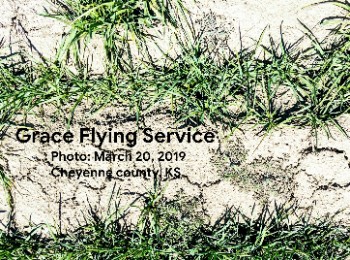
Grace Flying Service recently mailed its first customer postcard of 2019. The text is below:
After a late spring, wheat stands are greening up and appear to have good yield potential. It is time to consider herbicide and fertilizer options.
If you have mustard (see photo) or you simply want to keep your field cleaner during this growing season, treating now with Ally (metsulfuron), dicamba, and 2,4-D is still a good choice. Early treatment--before the kochia grows out of its dicamba-susceptible stage--is important.
If you prefer to wait and assess weed pressure, emerged kochia and other summer annuals can be treated with Colt+Salvo (Starane and 2,4-D) and Ally for about $3.50/acre more. Treat before flag leaf stage.
Because mineral-laden hard water can reduce pesticide effectiveness, we apply with soft water to ensure maximum performance. Remember, we do all the required paperwork for you, and keep it for three years.
We stock CoRoN, and we've converted to the new CoRoN Metra, which includes Helena's ENC plant health package. You can add CoRon to your applications for a foliar boost.
Contact us if you have questions.
Land Auction In Bird City
March 13, 2019

The Bird City Legion Hall hosted a small land sale on March 13, 2019. The heirs of Ada and Bob Connett sold 360 acres of property, of which 122 acres was dryland farm ground and the balance was pasture.
The weather was cloudy and threatening rain, with high winds in the immediate forecast.
The parcel is located 8 miles north and 2 west of Bird City, KS, and has one windmill and at least a mile of new fence which is co-owned with the neighboring land owner. The 2018 property taxes were $1,024.
There is an oil lease on the land, and the mineral rights went to the buyer. The legal description included portions in sections 21-2-38 and 22-2-38 in Cheyenne County.
There were about 30-35 people in the room, and probably less bidders locally than the reported six "internet bidders". An intitial bid of $425 started the sale, and the price soon went to $675, when the auctioneers--Farm and Ranch Realty--took a short break.
After the break, the selling price reached $725 per acre and the land was sold.
Bonny Dam Restoration Meeting Scheduled
March 8, 2019
The Coyote Gulch blog reports that a public meeting will be held concerning the partial restoration of Bonny Dam on March 14, 2019, at the Idalia, Colorado, school at 5 PM MT. This meeting is the latest in an ongoing series of meetings.
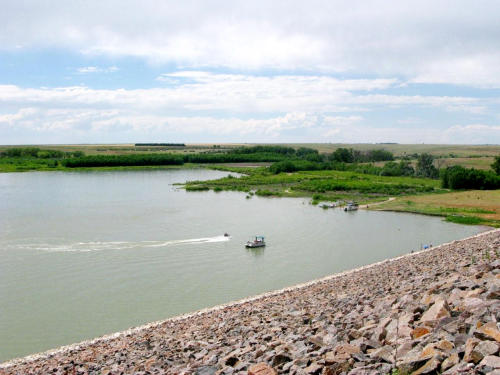
The meeting is co-hosted by the South Fork Republican River Restoration Coalition and the Colorado Agriculture Preservation Association. The article says that Yuma County Commissioner Robin Wiley believes that the group is making headway and that Wiley stressed that plans do include necessarily refilling the lake, but restoring the stream flow and possibly establishing some non-water and small water recreational activities in and around the old lake bed. All interested individuals are invited to attend the public meeting.
The Coalition is working with several different groups and it secured a $99,000 grant in January, 2018, from the Colorado Water Conservation Board, along with The Nature Conservancy giving a cash match.
The dam was drained seven years ago in response to a 2003 Supreme Court decision concerning intra-state water usage. The Court ruled that both Colorado and Nebraska had not honored the Republican River Compact, that both those states had shorted the state of Kansas of billions of gallons of water allocations.
The draining of the dam was controversial, as it represented the loss of a valuable recreation opportunity and the associated revenues from park fees and the associated businesses. You can read more in this Denver Post article, and this one in the Burlington Record.
A Better Way to Water
February 19, 2019
We recently attended two meetings, one in Burlington, CO, and one in Goodland, KS, which discussed the use of technology to monitor and control center pivots to both increase yields and conserve water.

We realize that statement might sound too good to be true, but it isn't. The data is real, and it makes sense when you understand the mechanics of the process.
The Burlington meeting was sponsored by CropMetrics, a company which has been using soil probes and data analysis for many years. The Goodland meeting was sponsored by ServiTech, a well-known crop-scouting service now announcing their entry into the precision irrigation market.
At the risk of over-simplifying this complex subject, the basic premise is that a 4 foot-long soil probe is inserted into a carefully selected spot in the field, and this probe has connection to the internet. Probe location is based upon a map of the soil in the pivot--more below.
This soil probe allows the pivot operator to "see" the actual moisture amounts at several levels in the soil, down to 48 inches. This knowledge is very valuable, and results in the ability to use water and fertilizer more efficiently.
This soil moisture data is available in near real-time, and armed with the knowledge of the corn's root depth, the operator can more accurately control watering to allow the plant to maximize the irrigation water usage. Water which moves below the plant's roots is essentially wasted water. But without a soil probe, this waste is frankly inevitable, because of the fear of "getting behind" in the irrigation process and damaging the crop due a lack of water.
We all know that a 2-inch rain that comes in twenty minutes will have an entirely different soil profile than one that comes over two days. With a soil probe, the farmer can "see" the actual results of the rain in the soil. No guessing, no digging. Wait for an hour and pull out your cell phone to know exactly what just happened, and use that same phone to turn off the pivot. More importantly, the cell phone allows you to turn the pivot back on at exactly the right time: not too soon and not too late. The same logic applies to the normal irrigation process.
Similarly, fertigation can be applied so that it is fully utilized by the plant and not leached too deeply. An extra inch of water can lose 4 pounds/acre of nitrogen: enough money to pay for the probe. Fertilizer that is applied with too much water is not only an expensive waste, it can be a danger to the aquifer, a well-known, long standing issue.
A further refinement of the system--called VRI--utilizes the above-mentioned map of the field's various soil types. This granular soil map is used to micro-manage the pivot's speed--and therefore the application rate--in a manner which better utilizes the water and/or fertilizer by varying the watering rate in many pie-shaped wedges in the field. Those wedges are visible in the image above.
The data is solid, based upon many seasons of usage. The system works: you can grow better yields for less money and with less water, because you can precisely target the root zone with both water and fertilizer. The probe allows you to target vertically, and VRI provides (with admittedly limited precision) lateral precision based upon the varying soil types in the field.
CropMetrics has been using this system for many years, and we've personally used their system for half a decade. We endorse the concept, and think that every pivot operator should at least try it for a season or two. ServiTech's entry into the market reinforces our belief that this is an irrigation technique which is here to stay.
The link to the ServiTech system is here, and CropMetrics is here.
Cover Your Acres Conference 2019
January 21, 2019
The annual Cover Your Acres conference was held at the Oberlin, KS, Gateway Civic Center on January 15-16, 2019. As usual, it had some excellent content. Based upon the number of vehicles parked outside and the crowd in the exhibit hall, it was a well-attended event.

You can read a summary of the program with the speakers' names and credentials by clicking here.
Even better, the event's full proceedings are available here. Spending 45 minutes reading this document is probably time well spent if you are actively farming.
Below is a very abbreviated summary of several presentations, based upon our attendance of some of the sessions or from the written proceedings (link above).
Strahinja Stepanovic discussed strategies for irrigated soybeans. Based upon 2018 tests in southwest Nebraska, he argues for early soybean planting--before corn planting--and lower seeding rates of 120,000 seeds per acre. He also argues that late season chemigation of nitrogen is not worthwhile.
Jordan Steele analyzed the financial status of northwest Kansas farms. Unsurprisingly, the overall situation is worse than it was three years ago, when commodity prices were much higher. However, he has one complex graph which shows that within those realities, some farms are quite profitable, while others are hemorrhaging cash. Interestingly, profitability is not well correlated to farm size: there both large and small farms that are doing well. Or not. It depends upon cost of production per bushel harvested.
Marshal Hay and Dallas Peterson discuss methods to effectively use paraquat, a herbicide which is enjoying a renassiance because of its ability to control resistant weeds such as Palmer amaranth and kochia. Paraquat can be tricky: if you apply it, reviewing the basic techniques is a good idea.
We attended Mykel Taylor's excellent talk which analyzed land values and rental rates. The data is there for you to see, but we especially liked her discussion of relationships between tenants and landlords. She noted the typical age and gender differences between the two, and noted shortcomings in the way some younger male tenants interact with older female landlords. It is important to treat landlords well, and her advice--based upon interviews with landlords--seemed accurate to us.
More and more insects are developing resistance to Bt traits in corn seed. These include corn rootworm, western bean cutworm, and corn borer. So buying the correct traits for your fields is important. Here is a chart which summarizes the issue for a large number of traits, along with their trade names.
Dr. Merle Vigil's discussion of using manure on eroded, high pH soils is only available in the printed summary, Even though Vigil reportedly wanted to attend, his superiors in Akron, Colorado, prohibited from doing so at risk of a $10,000 penalty and possibly jail time. This dire threat was based upon the decision to strictly abide by the Federal government shut-down in place at the time. His six year-long study analyzes manure rates and incorporation techniques.
Jeanne Falk Jones discussed three missteps to avoid in wheat production. She advises timely fungicide application, good weed control, and proper usage of nitrogen. It all makes sense to us, and we wished we'd been there instead of just reading the summary.
The above is the briefest of summaries, and doesn't do justice to the full presentations. Reading them by clicking here would be more useful.
K-State Dryland Cropping Meeting
December 21, 2018
We attended the K-State Dryland Cropping Systems Update meeting held at the Cheyenne County Fairgrounds 4-H building, on December 19, 2018. The meeting was well attended: there were about 60 people in the room.
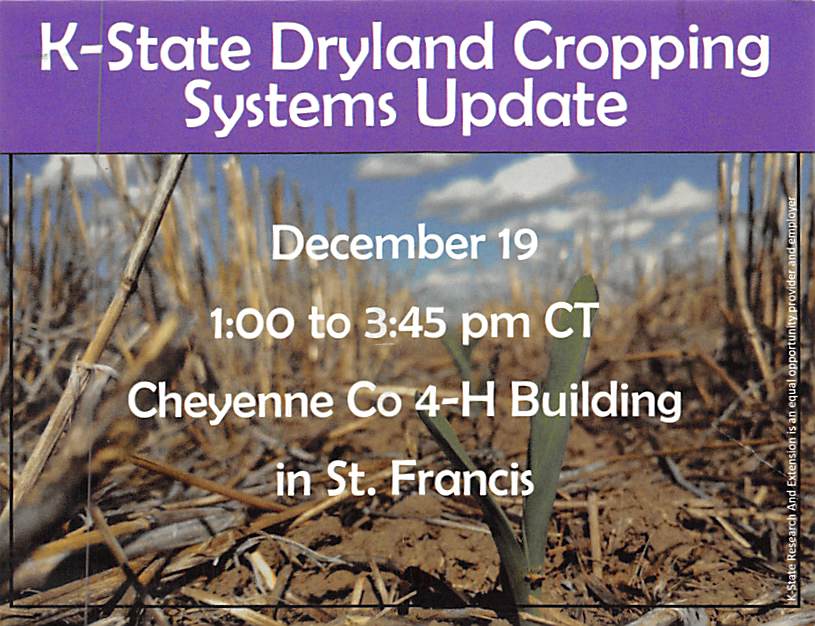
There were four speakers: Alan Schlegel, Tribune SW Research Center; Dallas Petersen, Extension Weed Specialist KSU; Monty Vandeveer, Department of Ag Economics KSU; and Lucas Haag, NW Kansas Research Extension, KSU Colby.
The speakers delivered a lot of information, and we've uploaded their powerpoint presentations in the links below: click and read them.
Alan Schlegel began by talking about their work with wheat-sorgum-fallow and wheat-corn-fallow rotations. He said that in Tribune, they find that sorghum works better, but he noted that similar results occur with corn and that corn might be better in this area. His research centered upon comparing conventional tillage, reduced tillage, and no-till with these rotations.
Schlegel said that wheat yields don't vary as much with each of the different systems, but that sorghum yields in no-till can be much higher--2.5 times!--than conventional, and that reduced till is better than conventional, too. He added that if you need one conventional tillage in a no-till system for a specific purpose, that the yields and expenses are not affected much.
Schlagel also had data that showed that during wheat harvest, leaving the stubble higher increased corn yields: he said 16 inch-tall stubble would yield 8 bu/acre more corn that wheat stubble cut at 8 inches at harvest. You can read his entire presentation by clicking here for a PDF and scrolling down a few pages.
Dallas Petersen gave a detailed talk about weed control for three problem weeds: kochia, palmer amaranth, and tumble windmillgrass. He explained weed biology, and talked about the need for careful herbicide selection. There is a lot of detail, and you can read it by clicking here .
Monte Vandeveer comparted the economics of the various tillage systems: do the increased yields result in improved profits, once the cost of the various systems are calculated? In short, the answer is "yes", you can make more money with reduced and no-till, but cautioned that your results will vary with the costs that you personally allocate toward your tillage operations.
He added that when commodity prices are quite low (lower than today's prices), reduced tillage might make more sense than full no-till. There are a lot of numbers, and they can be read by clicking here.
Finally, Lucas Haag discussed the choices for dryland seed corn, comparing planting dates, yields, and seed maturities. He used historical data going back many years, and has begun an experiment to validate the data, but he only has one season's actual data. You can read all of it by clicking here for a PDF.
You can also find out more by contacting Jeanne Falk Jones, Multi-County Specialist.
White House Announces Second Farm Payment In China Trade War
December 18, 2018
Yesterday, President Trump tweeted that, "I have authorized Secretary Perdue to implement the 2nd round of Market Facilitation Payments." As we reported here, in July the Trump administration promised $12 billion to farmers to compensate for the lower grain prices which resulted from the tariffs imposed upon China by the US government. Those tariffs resulted in dramatically reduced soybean imports into China.
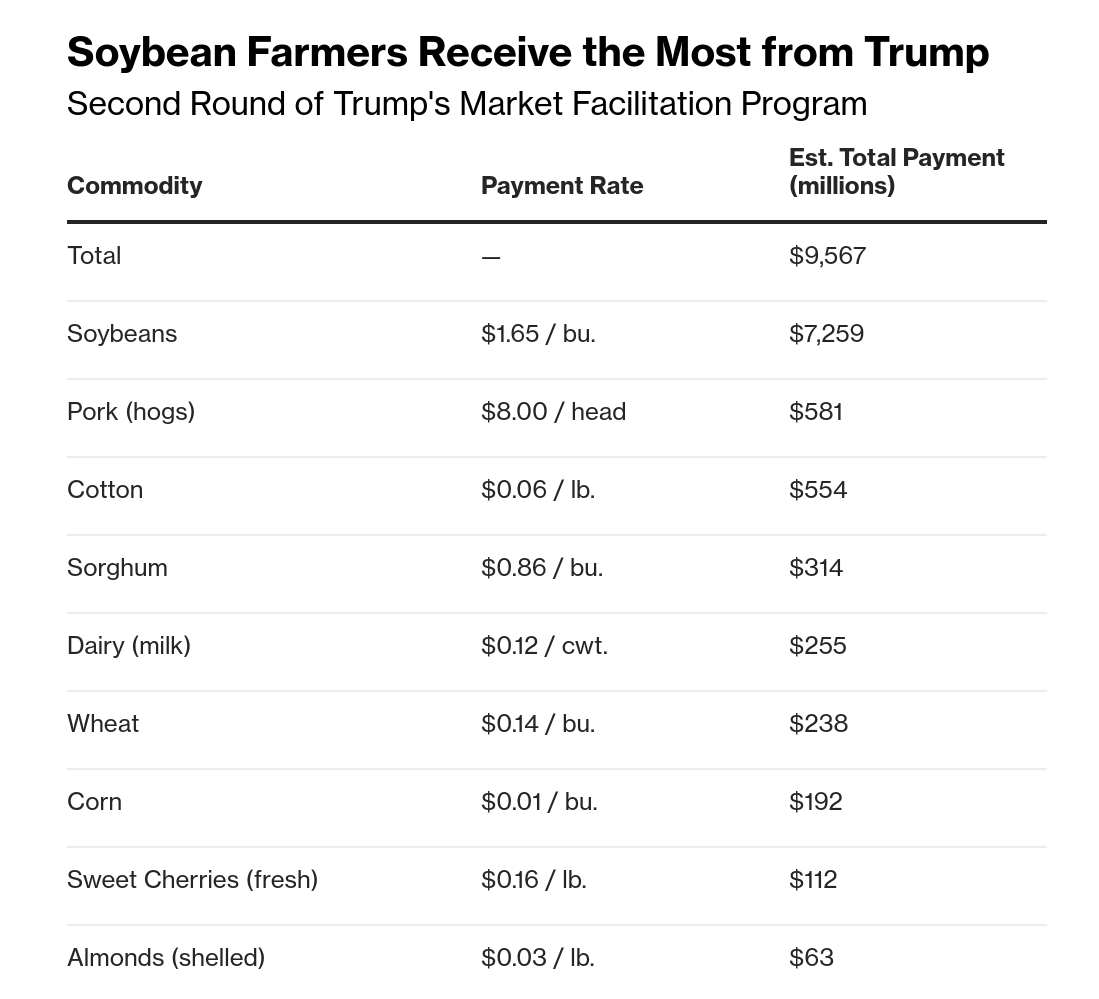
This Bloomberg article says that the first MFP was $4.7 billion, and that the second payment is slightly larger: Total payments are now $9.57 billion, with most of the money going to soybeans, as shown in the accompanying graphic. The National Corn Growers Association called the payments "virtually no relief."
There are more details about the MFP in this USDA announcement, including the limit on average adjusted gross income of $900,000 for recipients, and a maximum payment per entity of $125,000.
It is unclear whether there will be yet another payment to reach the promised $12 billion total. This USA Today article uses the words "final round" to characterize the second payment, but we don't know if that is merely speculation on their part?
House Passes Compromise Farm Bill
December 12, 2018
The US House of Representatives passed the farm bill in a lopsided 369-47 vote, according to this Politico article.

The 807 page-long bill will cost $867 billion over ten years, but 70% of that money goes to SNAP, Supplemental Nutritional Assistance Program--formerly known as food stamps. Which means that less than a third of the farm bill actually goes to farmers.
The SNAP program was the sticking point in the negotiations, as conservatives wanted to tighten the work requirements for 1.5 million able-bodied recipients, potentially dropping them from the list of the 40 million current recipients. The Democrats opposed this change, and since there weren't the required 60 votes in the Senate to pass the proposed SNAP changes, a compromise bill was voted on in the House.
Because the House will have a lot more Democrats after the first of the year, the Republicans had no choice but drop the SNAP provisions in order to get a bill passed.
It is expected that President Trump will sign the bill next week. In the last few years, net farm income has dropped a staggering fifty percent, mostly due to low commodity prices. Some of the lower commodity prices are blamed on the Trump administration's tariff policies.
The new farm bill mostly mirrors the old bill, according to Politico, and the federal crop insurance program is unchanged. There may be some funding in the bill for rural broadband and slight increases in commodity payments.
AgExpo in Reno
December 4, 2018
We recently attended the National Agriculural Aviation Association Ag-Expo in Reno, Nevada, on December 3-6, 2018.

We attend this meeting every year because it the largest collection of aerial application expertise in the world. If you want to know what is new and emerging in the ag aviation world, you need to attend.
We learned about UAS aerial applications, using social media to promote agriculture, new nozzle flow-rate technology, and much more.
One of the upbeat and interesting presentations was from the Peterson Farm Brothers, a Kansas-based family farm that is trying to promote the benefits of farming via social media, including original YouTube musical videos. They now have more than 50 million views, and also use Facebook and Twitter, along with a website with factual agricultural information on their blog. You can view one of their videos on the right, or click here for more.
So far, UAS (drone) pesticide applications are still mostly imaginary, or use very small aircraft which can only be used for the smallest of areas, possibly for spot spraying noxious weeds or public health control. Despite the fact that FAA certification will be a major hurdle, we saw several prototypes of automated hovercraft which can carry up to 50 gallons at maybe 50 mph, so there are companies trying to make automated pesticide application a reality.
We think automation in ag aviation is the future, but fixed-wing aircraft may be required to achieve scale in the Midwest, not rotorcraft. The argument for the smaller aircraft are that they can work 24 hours per day, if the weather is amenable, and that a single person on the ground could control several of them simultaneously. Those arguments make sense, but if you have an airport, the reasoning is equally valid for larger, more productive fixed-wing aircraft.
Another interesting nascent technology utilizes a pulsing diaphragm valve on individual nozzles, so that flow of each nozzle could be controlled in real time without changing pressure. This means that a spray pattern could be modified span-wise in terms of flow rate without changing the droplet spectrum. Clearly, this method could be useful, but it is unclear if the weight and complexity of the system are acceptable for the potential gains.

Other topics included aerial imaging, turbine engine maintenance, nozzle technolgy, pesticide safety, predictions of food consumption world-wide. There is broad agreement that the world population will increase by several billion people over the next thirty years, and that the emerging countries will want to consume more calories. In other words, the demand for food will continue to increase, and possibly at an impressive rate.
The only real questions are what foods will be consumed and who will produce them? Click here for a report that gives an excellent historical tutorial on food production in a graphic format.
Finally, we saw a new GPS guidance system that uses iPad displays instead of dedicated screens, a trend that we think has much merit: it's cheaper, slicker, and easy to upgrade. We currently use iPads mounted in our ag aircraft for ADS-B output, and they have performed well for two seasons.
Farmer Indicted For Dicamba Misuse
November 29, 2018
In this AP wire story, a southeast Missouri farmer, Bobby David Lowrey, 51, has been charged with a 53-count federal indictment for illegally applying dicamba to his own crops and thereby damaging crops in neighboring fields, and for lying to investigators about the applications.
The article also says that the "crops planted by Lowrey in 2016, which cover 6,700 acres, were modified to be resistant to dicamba." The indictment alleges Lowrey applied dicamba to cotton after planting and over-the-top on soybeans, and then presented false spray records to investigators.
Lowrey faces 49 counts of misapplication of a pesticide, three counts of obstruction of justice, and one count of making a false statement. He could face up to 20 years in prison and a $250,000 fine if convicted.
Our only comment is to reiterate what we said in the last paragraph in the November 20 article below...
EPA Issues Dicamba Ruling
November 20, 2018
The EPA has issued a new ruling concerning the use of dicamba in Xtend cotton and soybeans. As we previously reported, there was concern that the EPA might ban certain uses, because of the extremely high number of drift complaints across the Midwest in the past two years.
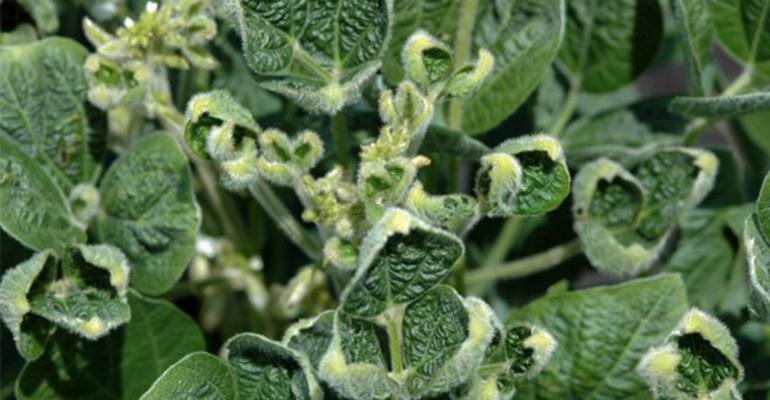
This article from the K-State eUpdate letter summarizes the new ruling. There are several new restrictions on use, including the requirement that all applications actually be performed by certified applicators, and not persons under their direct supervision. In addition, all applications are prohibited until one hour after sunrise and two hours before sunset.
In addition, the new EPA ruling is limited to two years, with a deadline of December 20, 2020, implying that the next two years are still a probation period, and that further restrictions or outright ban might sill be possible in the future.
If you apply dicamba to cotton or soys, you should read this link, because it is hard to imagine that regulatory agencies won't be watching applications of Xtend dicamba very carefully for the next two years.
"Right To Repair" Scores A Victory
October 28, 2018
This Washington Post article headlines a "major victory" for the right-to-repair cause, based upon a new ruling by the Librarian of Congress and the Copyright Office of the US. However, the ruling is actually somewhat limited, and merely carves out several exemptions to the existing law. That law prohibited owners of equipment which contains Digital Rights Management (DRM) from repairing their own equipment. The law is cited in Section 1201 of the Digitial Millennium Copyright Act (DMCA).
The Post article quotes Nathan Proctor as saying, the new exemption “establishes that you have a legal right to repair something that you own and that does not infringe upon the copyright protection afforded to the manufacturer.” One catch is that while tractors and automobiles are included in the new exemption, aircraft and boats are excluded.
The issue is complex, and you can read our previous articles here, or read this excellent summary from the Electronic Frontier Foundation (EFF). This manifesto by iFixit is also worth a look.
So farmers can now legally repair their own tractors, if they can hack through the DRM which is designed to prevent them from doing that very thing. Since the Copyright Office doesn't require manufacturers to provide DRM access to the owners of the equipment, the ruling might be a hollow victory in some cases.
We will keep following the story and keep you posted. In the meanwhile, you might consider donating some money to the EFF. It's a good group.
...And Some Bad News
October 12, 2018
Kochia is becoming resistant to fluroxypyr (Starane) according to this article which outlines recent research done by KSU at the Hays Agricultural Research Center.
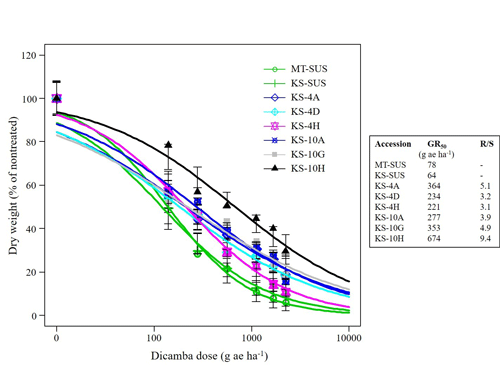
The article explains, in fairly dense scientific prose, how two different sets of kochia seeds reacted to varying doses of both dicamba (Banvel) and fluroxypyr (Starane) in greenhouse plantings. The scientists used harvest dry-weight of the plants as a method of measuring herbicide efficacy. One set of seeds came from a field which has had repeated herbicide treatments for several years, and the other seeds--considered "susceptible"--came from a pasture where herbicides have not been used on the kochia.
The results, if predictable, were quite disappointing: both dicamba and fluroxypyr showed significant loss of effectiveness on the kochia plants. The article says, "the selected kochia accessions also showed 3.2- to 9.5-fold level of resistance to Starane Ultra relative" to susceptible plants. Similar numbers were seen with the dicamba resistance tests.
This is bad news, as the herbicide options for controlling kochia are rapidly approaching zero. Best advice is use multiple herbicides and full-labeled rates when treating kochia. Treat when the kochia plants are small: rosette stage, if possible.
Some Good News...
October 12, 2018
We previously reported on the banning of chlorpyrifos (Lorsban) by a 3-judge 9th Circuit Federal appeals court. In that ruling, it was unclear if all the scientific evidence was available to the court, but rather a summary of data that came from sources which were biased against the pesticide.
In this USDA article, Sonny Perdue, Secretary of Agriculture, praises the Department of Justice for appealing the ban ruling. In the appeal, the DOJ asks for an en banc hearing, which means all of the judges will hear the case as opposed to the original 3-judge ruling. The full panel could overturn the previous ruling, which was a 2-1 vote. The DOJ's request was supported by many major farm groups with amicus curiae briefs.
The USDA article says, "The decision appears to be based on a misunderstanding of both the available scientific information and EPA’s pesticide regulatory system. The U.S. Department of Agriculture (USDA) and other groups have pointed out significant flaws in the draft chlorpyrifos assessments on which the court based its opinion, and USDA supports EPA’s conclusion that the available scientific evidence does not indicate the need for a total ban on the use of chlorpyrifos (emphasis ours)." The article continues, "EPA should be allowed to continue its ongoing science-based and expert-led evaluation of chlorpyrifos, which is part of EPA’s registration review program that covers all pesticides."
We agree with the EPA on this issue. Regulations should be based upon science.
Fall Thistle Postcard
September 12, 2018
Fall is the best time to treat pasture thistles--musk, bull, and Canada. Please contact us now to treat your pasture ground.
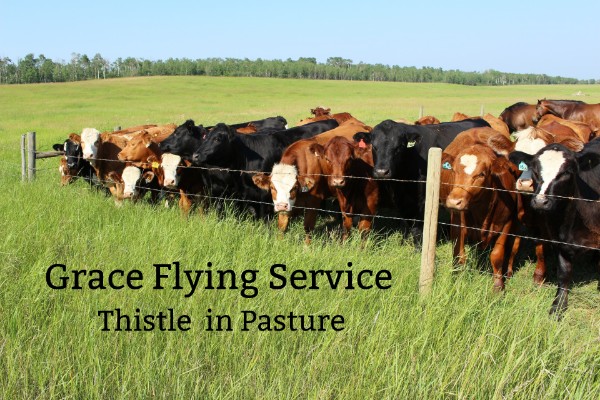
We need your order and maps so that we can plan an application schedule. The window of opportunity can be very short in the fall, and small field sizes means multiple customers for a single load.
Our deadline for taking thistle orders is Monday, October 8, 2018.
Musk and bull thistle can be treated until the ground freezes, but Canada thistle needs to sprayed before a killing frost. We think the best chemical choice is GrazonNext HL, which is Milestone in a pre-mix with 2,4-D.
Please contact us for more information.
Trump Promises $12 Billion To Agriculture
September 3, 2018
In this article, Reuters reports that the Trump administration has promised to "provide up to $12 billion in aid for U.S. farmers in early September to shield them from the repercussions of trade disputes between the United States and China, the European Union and others."
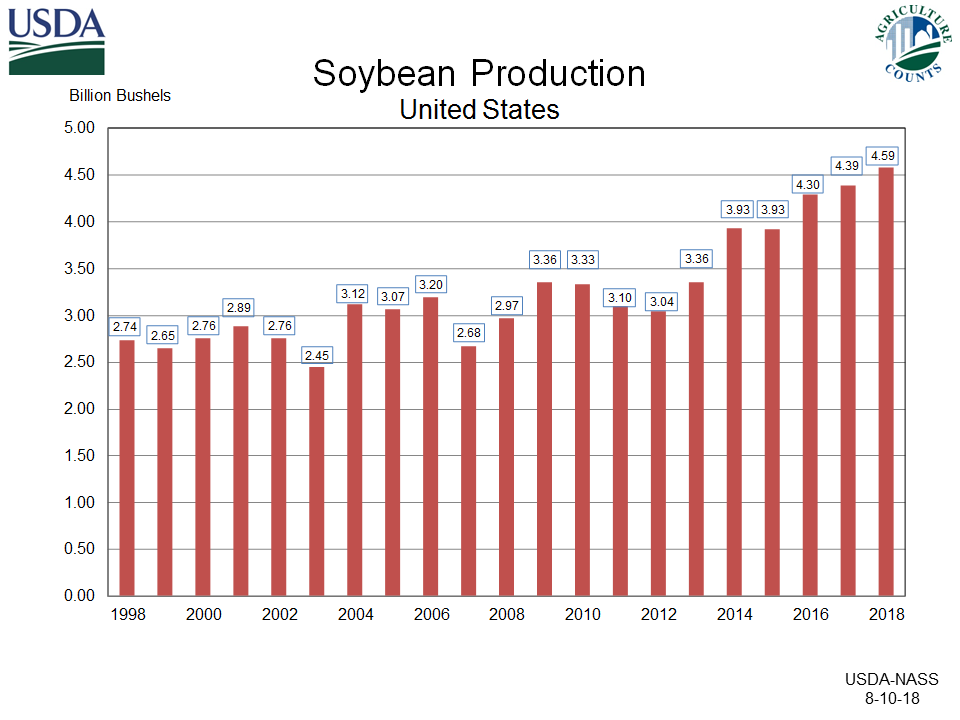
The article says that the US government last offered farmers a comparable amount of emergency assistance starting in 1998 to address low hog, corn and soybean prices. It adds that in 2017, the federal government spent nearly $19 billion on agriculture support programs, and that total had been expected to rise to nearly $27 billion in 2018.
The USDA said the $12 billion would be divided into three different programs, including direct payments to farmers of soybeans, sorghum, corn, wheat, cotton, dairy and hogs; purchases of foods for distribution to food banks and nutrition programs; and a trade promotion program to develop new markets. The funding would come from the Commodity Credit Corporation, which has authority to make loans and direct payments to U.S. growers when prices for corn, soybeans, wheat and other agricultural goods are low.
We looked at the USDA production numbers, and in 2017, the US produced 4.59 billion bushels of soybeans. If you assume all of the $12 billion were to go to farmers--an unlikely outcome--then the average price increase from the subsidy would be $2.61 per bushel.
We will keep you updated on this story.
Courts: 2, Ag: 0
August 21, 2018
In a pair of negative courtroom results for production agriculture, Monsanto lost a civil lawsuit concerning Roundup worth $289 million, and a Federal appeals court ruled 2-1 to order the EPA to ban all uses of a widely-used commercial insecticide, chlorpyrifos.

In the Monsanto lawsuit, DeWayne Johnson, who is suffering from terminal cancer which he believes was caused by long- term exposure Roundup during many years of applying the herbicide, was awarded $250 million in punitive damages (along with $39 million in compensatory damages) by a San Francisco jury. In a novel argument, Johnson's attorneys argue that Roundup specifically, as a packaged product, and not the active ingredient--glyphosate--is responsible for the cancer. Monsanto will appeal the verdict, and cites hundreds of studies which show glyphosate is not carcinogenic.
The European Food Safety Authority recently said that glyphosate is not "likely to be carcinogenic". In December, 2017, we reported on this two-decades long Agricultural Health Study, which involved 89,000 farmers and their spouses. It concluded that glyphosate is a not a risk for cancer, even among groups which apply the pesticide.
Six days after the Johnson ruling, General Mills was presented with a class action lawsuit over glyphosate residue, even though the residues in the Cheerios product are well below the EPA thresholds for grains. The lawsuit alleges that General Mills had a duty to disclose the presence of the herbicide in the cereal.
In the second adverse ruling, chlorpyrifos, commonly known as Lorsban, may be completely banned by the EPA within 60 days, if the Agency follows the ruling of the Federal appeals court. The insecticide is commonly used in commercial agricultural, even though its use in households has been previously banned due to damaging effects on children. The Appeals court consisted of three judges, and they ruled in a 2-1 vote to force the EPA to act, thereby denying the appeal. There are allegations of political interference on the issue by the recently resigned EPA head, Scott Pruitt.
It is unclear what the EPA will do in light of the ruling. The New York Times, in the above article, said that, "The agency could ask the full Ninth Circuit to reconsider the ruling or appeal it to the Supreme Court, while perhaps asking for a delay in the order that it ban the pesticide. Alternatively, the agency could move ahead with the ban." (Emphasis is ours.)
We will monitor the issues and provide future updates.
Moths and Weevils
August 9, 2018

Sunflowers are blooming, and that means insect control is a possibility. The primary insects that are controlled are head moth and red seed weevil. As we reported previously, with confectionery flowers, most growers simply plan on two insecticide treatments about ten days apart, because the dockage from damage is so expensive, and the economic thresholds are so low.
With oilseed flowers, it makes sense to scout, because there because insect thresholds are sometimes not met. With red seed weevil, the easiest method is spray the head with insect repellent to make the insects active and easy to count. The economic threshold is 10-20 per head.
For head moth, 2-5 moths per head is considered economic. The adult moths can be difficult to find because they are elusive and because they fold up their wings upon landing. Best techniques include scouting at dawn and dusk in light winds, while walking quietly. Some scouts use a flashlight.
Much more information is available from KSU by clicking here.
Updates: Dicamba Debacle and Wheat Test Plots
July 24, 2018
We have previously reported several times on the damage done by dicamba on soybeans after Monsanto began selling the dicamba resistant seed, and BASF sold the Engenia branded dicamba to treat that special seed. In this post, we reported that Monsanto had sued the Arkansas Board of Agriculture, and we later reported on the new extensive training requirements to use the "RUP dicamba" products. The industry has been worried that the EPA might ban dicamba outright if the damage to conventional soybeans was not minimized. We also opined that some of the problem might be volatilization, not physical drift, and that new herbicides need to be developed.

In this update on the 2018 season so far, Dr. Kevin Bradley, University of Missouri, asks some of the same questions that we asked.
Bradley reports that while the early reports of soybean damage are down from 2017, the numbers are still significant. He says that in 2017, there were "1,411 dicamba-related injury investigations being conducted by the various state Departments of Agriculture while university weed scientists estimated approximately 2.5 million acres of soybean had been injured with dicamba. To date, at about the same time in 2018, we have somewhere around 600 cases being investigated by the state departments of agriculture and approximately 1.1 million acres of soybean estimated with dicamba injury by university weed scientists."
In this unrelated article, we reported on the excellent and informative K-State Wheat Variety Demonstration Plots sponsored by Sunny Crest Farms and K-State University. Jeanne Falk-Jones has now published the 2018 results, and you can read them by clicking here.
Spider Mites in Corn
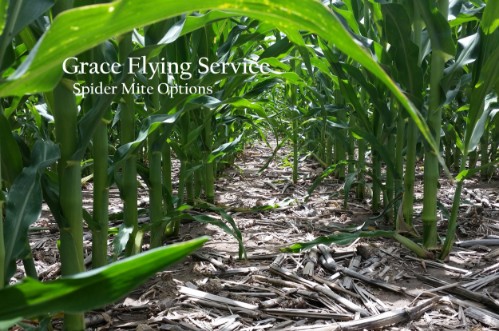
July 14, 2018
Many corn growers will soon be treating for spider mites. Last year, we noted that a new product--Portal XLO--was available, but priced substantially higher than either Comite 2 or Oberon.
The good news is that Portal XLO (fenpyroximate) is now priced competitively, and offers the best of all options.
Portal XLO controls all stages of mites, including eggs, and has a much shorter REI: 12 hours. (Comite 2 has a 13 day REI).
Portal XLO is advertised as being "soft on beneficial insects", and has a 14 day PHI (pre-harvest interval).
Timing is best when mite populations begin to build, and are 2 leaves below the ear leaf.
When applying a miticide, many farmers like to tank-mix in a fungicide--such as tebuconazole--since the application is already paid for. CoRoN can also be added for a foliar feed.
Talk with your consultant or contact us for more information.
Thunderstorms Wreak Havoc
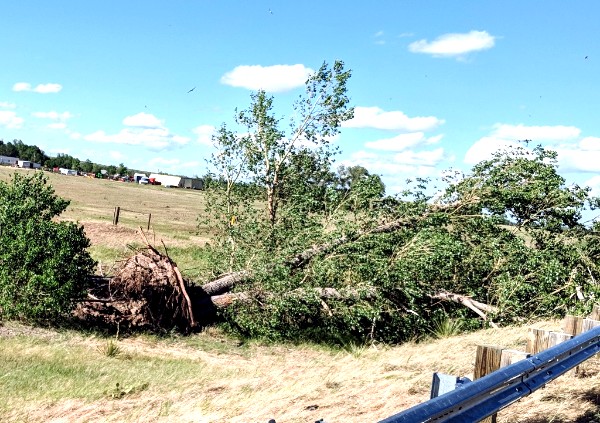

June 20, 2018
On the evening of June 19th, 2018, a major thunderstorm complex moved through eastern Colorado and western Kansas.
The storm path was roughly parallel to Highway 36, so a drive from the port of entry north of Idalia, through Saint Francis, and toward Bird City revealed an alarming amount of crop damage.
The storm provided the full gamut of adverse effects, including damaged roofs and windows on houses, as well as extensive crop damage--not only to corn and wheat, but also some pasture ground. In addition, there was localized flooding, many damaged vehicles, and trees with stripped leaves and downed branches.
At least one mature cottonwood tree was completely uprooted (see photo).
The radar image as the storm approached was especially ominous, including a hook echo, which portends tornadic activity. Several tornadoes were reported, but not confirmed as this is written.
The plains are infamous for severe thunderstorms, but this one was worse than most.
Pre-Harvest Weed Control in Wheat
June 18, 2018
Wheat harvest in the tri-state area is rapidly approaching, and there are some area fields which will need pre-harvest weed control.
Timing and weed spectrum dictate the herbicide selection process. Timing is controlled by label limitations, and these include the wheat stage required prior to application and the pre-harvest interval (PHI).
Weed spectrum is mostly dictated by the amount of kochia, and whether you have susceptible or resistant kochia. Since most grasses and broadleaves are still controlled with a glyphosate and dicamba tank-mix, that is the most common choice. With this tank-mix, you must wait for the hard dough stage to apply, and you have a 7 day PHI. Application should be made as soon as the wheat is in the hard dough stage, both for efficacy and harvest timing.

However, if you have kochia that is resistant to both chemistries, you will have kochia failures with glyphosate/dicamba option. Then, you will need to aggressively control the resistant kochia after harvest, either with mechanical tillage or with a Starane-type (fluroxypyr) herbicide. Otherwise, the resulting seed will be predominantly resistant, and the kochia problem will likely be much worse in the future.
For the best control of resistant kochia, you can use a fluroxypyr product now. Colt-Salvo is a popular broadleaf control choice. Its label, interestingly, has no wheat stage limitations for pre-harvest application, but the PHI is forty days. This extremely long PHI is a significant barrier to usage: if you applied Colt-Salvo as this is written, the legal harvest date would be July 28th.
Given these choices, we think that most farmers will choose a dicamba/glyphosate tank-mix and simply accept some kochia failures. We wish there were better options, and we hope for better products and choices in the future. Here is an article from K-State Extension.
If you have wheat that needs pre-harvest treatment, contact us early so that we can apply as soon as the proper wheat stage and weather conditions permit. Delaying application will reduce control efficacy and needlessly delay your harvest dates.
Wheat Variety Test Plots
June 14, 2018
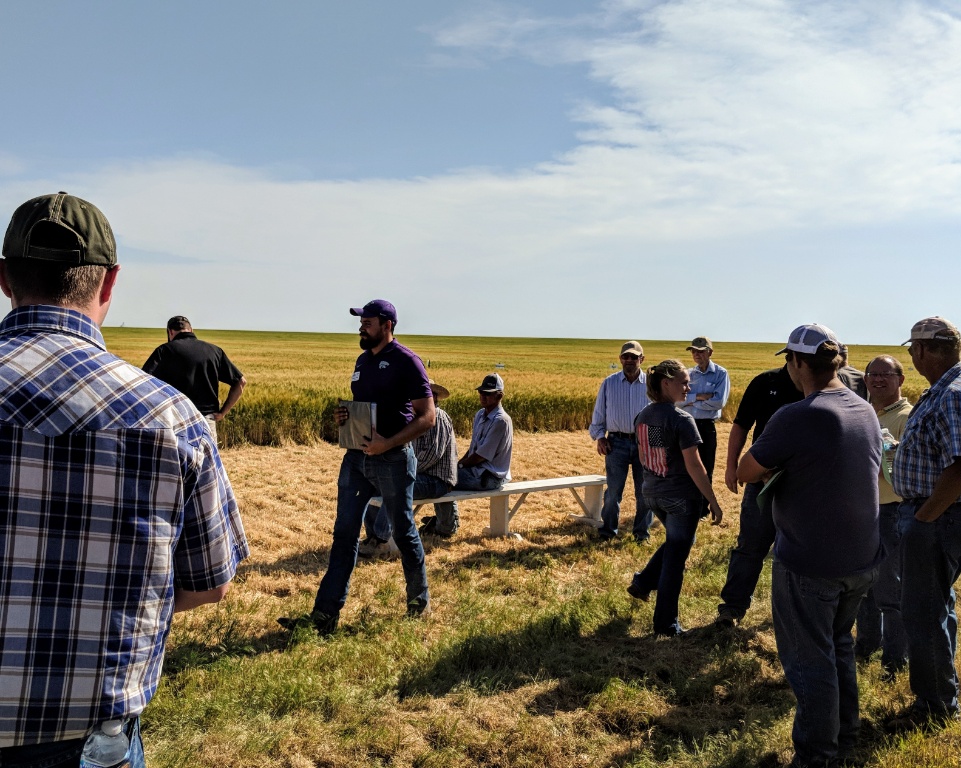
We attended the K-State Wheat Variety Demonstration Plots yesterday, June 13, 2018. The plots are five miles south of Wheeler, Kansas, and sponsored by Sunny Crest Farm and K-State University.
We counted about 45 people in attendance on the warm, windy evening.
There were 15-20 different wheat plots, and detailed comments about each wheat variety by two K-State specialists in plant pathology and agronomics, with comments by the local KSU contact, Jeanne Falk-Jones. The variety analysis included details on disease resistance, relative maturity speed, standability, leaf drop, yields, and drought resistance.
In addition, a pamphlet of previous results was distributed. The amount of information available was impressive. The 2017 results are published here.
It's a great event, and we appreciate the efforts of Sunny Crest Farms, Jeanne, and KSU. Nice work!
Honor Students: 14 Years
May 18, 2018
In 2005--so this is the 14th year--we launched our Honor Student Recognition Program. Our Honor Student Program is one that we love: it allows us to support scholastic excellence in the local high schools, a concept which we think is vitally important.

The Honor Student program is simple: the top five students in each High School class get special recognition via a letter and a momento. In 2018, the award was a wireless bluetooth headset displaying a "Honor Student" logo. The schools provide with the students' name, and we list them on our website, as well as provide the gifts to the school in time for the awards assembly at year's end.
As an extra bonus, we often get "thank you" notes from recipients of the award.
We are happy to announce that we have added Cheylin to the other two schools in the area: Idalia and Saint Francis. We wanted to include Cheylin for years, and it finally became possible this year.
Here is more about the Honor Student program and some of our other community programs.
To see a list of all the Honor Students since 2005, more than 120 separate classes, please click here. It's a great bunch of individuals!
K-State: Wheat Rust Update
May 6, 2018

The April 27, 2018, K-State eUpdate reports that stripe rust has arrived in southeast Kansas at low levels. Notably, the disease apparently traveled across the vast area of dry, poor wheat in Texas and Oklahoma. The lack of a wheat host which was thriving which was considered a mechanism to slow or suppress northward movement, so the arrival in Kansas was notable.
Despite this news, it is not clear if the disease will continue to spread across Kansas. The wheat crop in our region appears to have good yield potential, but might be behind in development stage, possibly because of cool weather and an extended spring.
The K-State article does quote Josh Coltrain, K-State Extension Agent in the Wildcat Extension District: "many growers are considering a fungicide to suppress stripe rust in the southeast region."
We have some growers who are now considering treatment, but the outlook is always difficult to predict. Best advice is to scout susceptible varieties (here is a K-State susceptible variety publication) and irrigated wheat first. Fields with high yield potential would come next in the process. To read the K-State eUpdate, please click here.
China Stops Importing US Soybeans
May 5, 2018

According to this Bloomberg story, China has stopped importing US soybeans. This termination of soybean imports is presumably in response to the growing trade war recently begun by the US. Last month, China annouinced tariffs on US soys, but now the world's largest oilseed processor--Bunge Ltd,--says China is ceasing US imports, relying instead on Canada, and to a greater degree, Brazil.
In our local area, soybeans are a relatively small percentage of the landscape, but they are important, and the implications of this action potentially affects other grain exports.
The article adds that, "Soybeans are the second-largest American crop and prices are heavily dependent on trade with the Asian nation, the world’s top importer."
The article continues, saying, "In the two weeks ended April 19, China canceled a net 62,690 metric tons of U.S. soybean purchases for the marketing year that ends Aug. 31, U.S. Department of Agriculture data show. At this time of year, South American countries typically complete their harvests and become the dominant shippers for several months. Brazil’s lead on global exports is expected to widen to a record in the 2017-2018 season as it sells 73.1 million tons abroad versus 56.2 million from the U.S., the USDA estimates."
To read the entire Bloomberg article, please click here.
Ag Pilots And Video Cameras
April 25, 2018
About a week ago, a professional video crew--KEO Films--was working with a local pilot, Mike Callicrate of Callicrate Cattle Company, recording his landing as part of a documentary. By coincidence, we were returning from a job in the turbine Thrush ag aircraft, and saw the camera crew from a distance.
The old joke is that it is dangerous to get between a politician and a video camera, but a similar danger exists with ag pilots. So as soon as Mike's Piper Commanche cleared the runway, we dropped into the final approach slot on runway 14, and hoped for our fifteen minutes of fame. A careful approach and the judicious use of the Garret's beta power during rollout allowed us to stop precisely at the camera crew, resulting in this 34-second video.
We are admittedly biased, but we like this video, not to mention a fairly decent landing.
The video quality is reasonably high, so try the full-screen image. (It might take a few seconds to load if you have a slow connection: we feel your pain, but we hated to lose resolution.)
Finally, a big thank you to KEO Films for providing the footage.
Cheyenne County Land Auction
April 11, 2018

A land and mineral auction was held at Western Auction and Real Estate in Saint Francis, Kansas, on April 11, 2018.
Two tracts were sold: the first was 480 acres of grass and dryland. The second tract was for mineral rights on some adjoining property: the mineral rights for the first tract were sold with the tract 1 sale. The seller was Gladys E. Cullum.
The land in the first tract is located just southwest of Saint Francis: the W 1/2 and SE 1/4 of 12-4-14. The northwest quarter of the land is divided by a rural, hard-surfaced county road. The 480 acres were advertised as 130 acres of summer fallow, 156 acres of wheat, 152 acres of grass, and 39 acres of waste. The 2017 taxes were $1,945, and the wheat base was 141 acres with a PLC yield of 35 bu/acre. All of the land was shown as HEL and UHEL.
The second tract was listed as "An undivided 1/4 of all, gas, and other minerals...in NW 1/4 of 17-4-40 and the NW 1/4 of 8-4-40 and the seller's lease interest in section 17-4-40", the latter listed as $825.46 in 2017.
There were about fifty people attending the sale, and there were also telephone bids. The first tract sold to a local buyer for $740/acre, and the mineral rights sold for $14,000.
The Western Auction and Real Estate website is here.
Wheat Herbicides Postcard
March 23, 2018
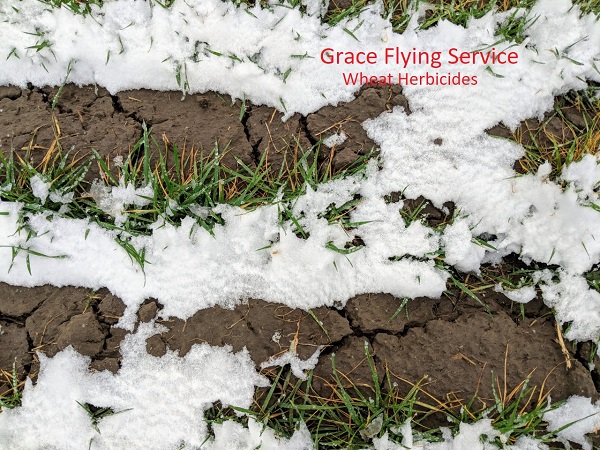
Our area's wheat crop currently has excellent prospects: generally good stands, adequate sub-soil moisture, and recent rain and snow. It is time to consider your spring herbicide and top-dress options.
If you have any mustards or wild lettuce, treating now with Ally (metsulfuron), dicamba, and 2,4-D is a good option. This treatment must be applied before joint stage, and before the kochia grows out of its early dicamba-susceptible stage. This is the least expensive option, and with early timing, is a proven effective program, despite minor kochia resistance concerns.
No mustard in your wheat? Kochia and summer annuals can be treatment can be delayed up to the wheat's flag-leaf stage, using a tank-mix of Ally and Colt+Salvo, for a cost of less than $4/acre more than the early treatment above. Note: Colt+Salvo is a trade name for a mixture of the active ingredient in Starane (fluroxypyr) and 2,4-D.
Weed control with this tank-mix is normally very good, and is reliable on kochia, with no resistance issues. In addition, the soil activity is more likely to extend into the post-harvest stubble season, because of the later application date.
All herbicide applications in growing wheat aid harvest and also delay the stubble's post-harvest weed flush.
We have CoRoN in stock: If you want, we can add it to a herbicide applications for a foliar boost. Any CoRoN which lands on the dirt, as opposed to the leaf surface, needs incorporation by moisture to be effective. So earlier top-dress has more time to catch rain, but later applications have more leaf surface to "catch" the CoRoN. We think timing should be based more upon the weed profile than the top-dress considerations, but sooner is probably better than later if you are adding top-dress.
Remember that we leave no tracks, and we do all required application paperwork for you.
Questions? Please contact us.
The above article is from the postcard that we recently mailed to our customers. This article has some added detail that space constraints on the postcard prohibited. If you would like to be on the postcard mailing list, please contact us and give us your mailing address.
Pigweed DNA Sometimes Circular
March 16, 2018
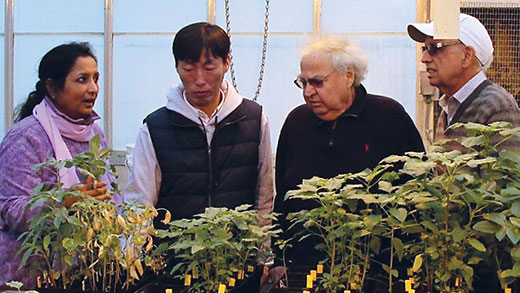
Kansas State University researchers published a technical paper which outlines a previously unknown mechanism which allows Palmer amaranth plants to modify their DNA in order to rapidly develop resistance against the herbicide glyphosate. According to this article the new structure is described as extra-chromosomal circular DNA or eccDNA. It says, "Each eccDNA has one copy of the gene that produces an enzyme that is the target for glyphosate."
The KSU article says that “We found that glyphosate-resistant Palmer amaranth plants carry the glyphosate target gene in hundreds of copies,” Mithila Jugulam, a researcher, said. “Therefore, even if you applied an amount much higher than the recommended dose of glyphosate, the plants would not be killed.” “Because of the presence of hundreds of eccDNAs in each cell, the amount of the enzyme is also abundant,” researcher Bikram Gill said. “Therefore, the plant is not affected by glyphosate application and the weed is resistant to the herbicide.”
It is too soon to know if there are practical applications to be gleaned from this discovery, so KSU says that the existing practices for combating herbicide resistance should be followed. The study indicates that once a weed has acquired eccDNA, the resistance may evolve as quickly as one generation.
Grain Prices Rally
March 9, 2018
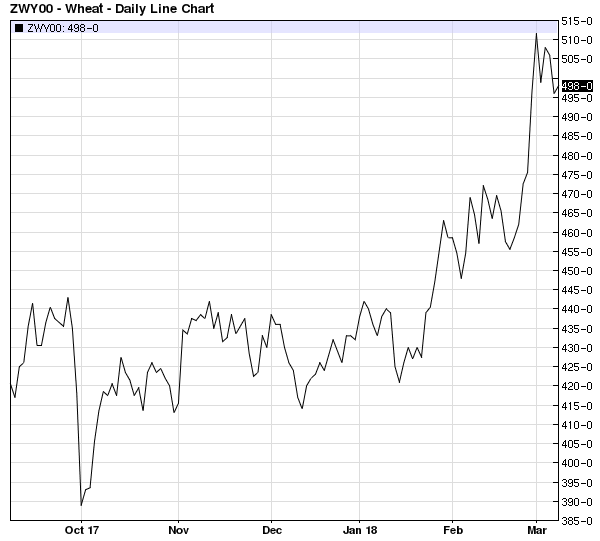
This article from Successful Farming outlines the recent rally in hard red winter wheat prices, along with soybeans and corn.
The article says, "... prices were reacting to the new developments that included the deterioration of the US HRW wheat crop as well as the Argentine 2018 crops. So, prices of winter wheat (and) corn are now near or at their highest price levels since August and highest prices for soybeans since Jan. 2016!"
Widespread drought conditions in the major wheat growing areas of the US, as well as in South America, are reportedly driving the rally in prices. Fortunately, here in the tri-state area, the abundant snows we had early in the year have helped soil moisture, and we are in much better shape than our neighbors to the south.
The article notes, "...as March unfolds we are at a most critical point in the crops development, as March and April usually make or break the winter wheat crop. Rains must arrive soon, or the winter wheat crop will suffer irreversible damage, as this is the time of year that winter wheat gets a good deal of its moisture and best growing season weather, typically. But currently, the warm/dry weather is forecast to continue through the next few weeks..."
We agree that spring rain would help a lot, but since our wheat is just now breaking dormancy, we can wait a little longer in this area. To read the entire Successful Farming article, please click here.
New Dicamba Certification Requirements
February 12, 2018
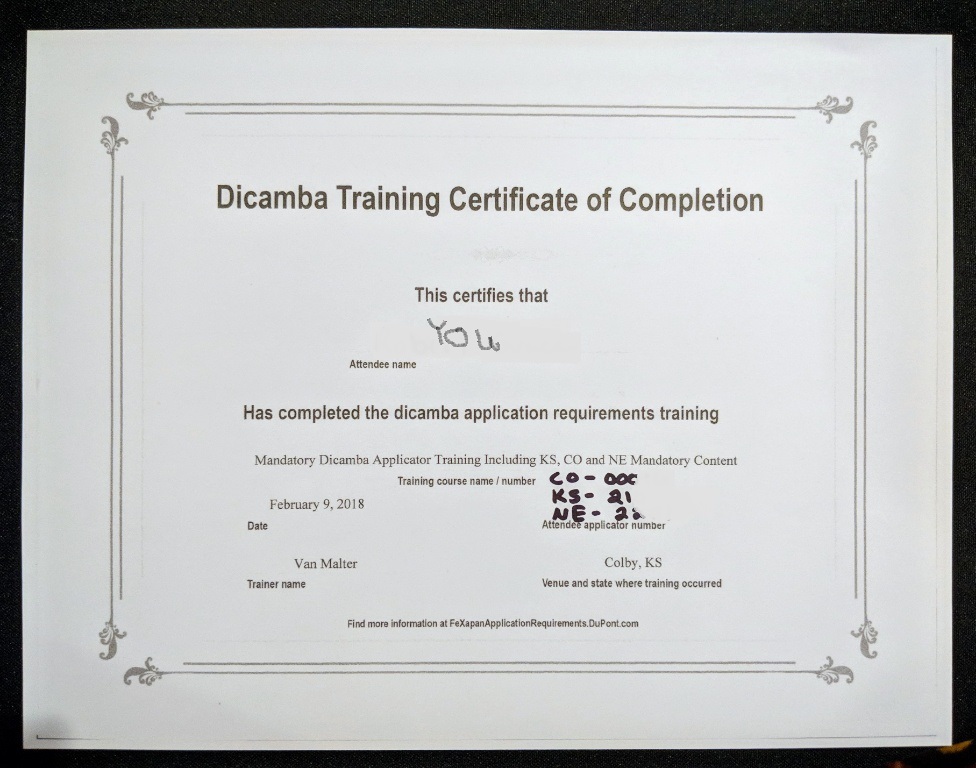
For the first time since 1958, when the dicamba molecule was discovered, some formulations now require a special training and certification to mix and apply the product. The new certification is added to your existing pesticide license in whichever state(s) that you have pesticide certification.
The new formulations are classified as Restricted Use Products (RUPs), so they require a pesticide license to purchase them, and the new additional training and certification to mix and apply them.
The new "RUP dicambas" are used on dicamba-tolerant soybean and cotton varieties, and no other formulations of dicamba require the special certification, although the 1.5 hour training session might be useful to remind applicators of the safeguards to be employed when applying any pesticide. The RUP dicambas are now sold as FeXapan (DuPont), XtendiMax (Monsanto), and Engenia (BASF).
We attended a certification seminar held by DuPont in Colby, Kansas, on February 9, and found the discussion interesting. Because dicamba is slated for re-certification by the EPA in November, 2018, and because of the debacle (click here for our previous reporting ) that occurred in the 2017 growing season, the chemical industry says that they are very concerned that if the new practices and record-keeping requirements aren't adopted for this season, there is a very real chance that dicamba could be lost to agriculture. As you might imagine, this loss would be considered a major issue for both the chemical companies and for agriculture in general, given the widespread usage of relatively inexpensive dicamba products.
We don't have enough space to go over all of the new requirements, but here are a few highlights of the training seminar:
-certification is automatic upon attendance of the training: no testing is required.
-the RUP dicambas must be applied in less than 10 mph winds, and no treatment is allowed if susceptible crops exist downwind and adjacent to the the target crop.
-15 gpa is the required volume, and nozzles used must be on a list of approved nozzles which is obtained from the label's website.
-before application, the applicator is required to read the label website to get the most recent information.
-all tank mix products must be listed--by trade name, not merely active ingredient--on the label website.
-the spraying equipment must be cleaned, using an approved procedure, both before and after application.
-the record keeping requirements are extensive if not onerous: there are 16 parameters that must be recorded.
-a 110 foot wide buffer-strip must be left if there are non-cropland targets downwind. The buffer strip is not for crop damage protection, but rather an endangered-species requirement mandated by lawsuits against the EPA by environmental groups.
-even very small amounts of AMS in the tank mix will greatly increase the dicamba's volatility, which is why the equipment cleaning requirement is so extensive.
-it has been demonstrated that non-resistant soybeans will exhibit cupped leaves if subjected to an application rate of dicamba that is only 1/20,000 of the labeled rate.
DuPont believes that some of new requirements, especially those concerning buffer strips for endangered species and the enhanced record keeping, might be required for new herbicides as they are granted labels by the EPA.
Even though many farmers in our area only use the older formulations of dicamba, and therefore won't need the additional certification, it would be a good idea to review your current practices and record-keeping. We imagine that regulatory agencies will be on increased alert this summer for misuse of any form of dicamba, not just the RUP formulations.
Land Auction in Wray, Colorado
February 8, 2018
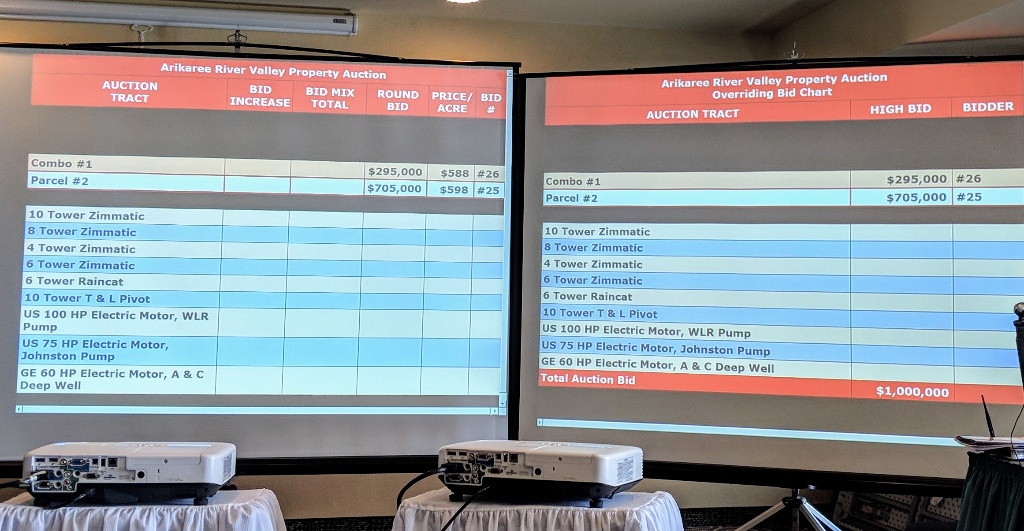
On February 6, 2018, we attended the land auction held in Wray, Colorado, at the Cobblestone Inn. On sale was 1,678 acres of pasture and dryland farm ground, which was sold in four parcels. Three of the parcels were mostly dryland with some bordering grass, and the last parcel was 1,177 acres of grass.
Although the land had been previously irrigated via center pivot, the wells were being capped--by the buyer--as per Colorado River Compact regulations. After a somewhat complicated bidding procedure, which required multiple bid rounds, the three farm land parcels ending up selling as a single unit. These three dryland parcels totaled 64 acres of grass and 437 acres of dryland farm ground.
The pasture contained four water tanks, but only one well, which had underground piping to the tanks. An auction attendee told us that the local water regulations prohibited adding a stock well to this pasture, but the pasture was advertised as having a pond on the property. The used center pivots and other irrigation equipment was sold separately after the land sale.
There were perhaps fifty people in the room, and telephone and internet bidding was present, but we believe that all the successful bidders were in the room. The auction was handled by Reck Agri Realty and Auction.
When the bidding ended, the farm ground parcel and the pasture went for nearly an identical price: $588 per acre for the former, and $598 for the pasture ground, to two different bidders.
If you were to figure the grass on the dryland parcels at zero dollars per acre, then the farm ground calculates to roughly $687 per acre. But since the balance of the pasture ground sold for more money than the dryland, even that calculation is worth pondering.
Autonomous Ag Aircraft?
January 29, 2018

Although there is spirited debate in the ag aviation industry, we believe that fully autonomous aerial crop applications are only a matter of time. In this Ag-Air Update article, Thrush Aircraft Company announces a strategic alliance with Drone America to develop a fully autonomous air tanker to be used to fight wildfires. The companies hope to be able to monitor and fight fires 24 hours per day, and bypass the current prohibition on nighttime fire fighting.
Thrush Aircraft is a major manufacturer of ag aircraft--they built the Thrush S2R aircraft flown by Grace Flying Service--and Drone America designs and manufactures unmanned aerial vehicles and systems. The article doesn't mention it, but it should be noted that this is not only a technical problem, it has significant regulatory hurdles to cross: The Federal Aviation Agency will have to approve this type of operation. The FAA, like most government agencies, can exhibit significant inertia in their approval process.
Despite the hurdles, this might be the beginning of a major transformation in the way that pesticides are applied aerially. As noted earlier, it is only a matter of time...
A Big Snow...
January 23, 2018

A major snow event began on Sunday, January 21, 2018. All of the tri-state area was affected, from an area south of Goodland, Kansas, extending northeast well into Nebraska. Click here to see a map.
By Monday morning, most areas had between 8 and 12 inches of wet snow. In some cases, the total precipitation was reported at more than 1.00" of moisture. There were substantial winds later in the storm, with gusts to 40-50 mph, and subsequent drifting. We heard of eight foot drifts, and we don't doubt that the reports were true.
Highways were closed over much of the area for a period of time. The early precipitation came as sleet, and the winds were not strong early in the storm, so there was a reasonably even distribution of the badly needed water.
The temperatures were in the 29-30 F range, so the snow was wet, and some melting began as soon as Monday afternoon when the skies cleared.
Kochia, Cattle, and Pluvials
January 19, 2018
We recently attended the annual Cover Your Acres conference in Oberlin's Gateway Center. As usual, they had an exhibit floor and a lot of seminars on many topics, including herbicide options, climate trends, grassland management, and soil probes as irrigation management tools.

Curtis Thompson, KSU Extension Agronomy, talked about kochia and palmer amaranth control. Both species are major problems, due to multiple herbicide resistance patterns. Thompson believes the best solution for both weeds is using soil active herbicides pre-emerge, to prevent germination.
As to kochia in wheat, treatment to the rosette stage with dicamba still mostly works, but waiting will likely result in unacceptable failure rates. Their studies show that treating weeds during the wheat growing season improves the percentage of kochia controlled in the fallow season. In corn, the use of pre-emerge applications followed by up to 16 ounces of dicamba will probably be effective. As usual, timing is everything.
Keith Harmoney, Range Scientist, K-State Research, Hays, spoke on managing rangeland. Harmoney noted that while cropland has increased in Kansas, rangeland acreage is decreasing. The three tools available are stocking rate, stocking systems, and managing encroaching species.
Yucca now has several products labeled for broadcast treatment--Cimarron Plus and Chaparral, both with ester 2,4-D--and they give about 70% control, so KSU recommends treating at least twice over a three year period. Harmoney noted that yucca on steep slopes can provide erosion control, but on flat ground, 1,000 plants/acre can reduce forage production from 300 to 1,000 pounds/acre. To estimate the number of plants, he said to walk 363 feet with your arms outstretched, and count all the yucca covered. Multiply your count by 20 to get the number of yucca per acre.
As to stocking rates, when comparing light, moderate, and heavy, their data shows that in the short and long term, the best practice is a moderate stocking rate. This is the most profitable and protects the rangeland. Moderate is defined as 48% forage consumption: "take half and leave half." Surprisingly, when half of the forage is used, the cattle only eat about half of it: the rest is lost to insects, wildlife, trampling, and destruction from urination, etc.
Dr. Jeffrey Basara, Oklahoma University, spoke about climate in the Great Plains. One of the subjects of their research team is studying is droughts, and the wet spells between the dry spells: called pluvials. Basara is worried that the High Plains might be entering into a drier period, but cautioned that predictions are dangerous, and that regional variations are common.
Basara noted that the Great Plains is unique when compared globally in a couple of ways. First, the rainfall and temperature gradients are orthogonal: temperature varies north to south, while precipitation varies east to west. Also, unlike most grasslands, the peaks of temperature and rainfall don't peak at the same time.
You can read much more by clicking here.
Agricultural Conditions in the Midwest
January 12, 2018
We attended the Farming For the Future conference in Scott City on January 10, 2018. There were perhaps 100 people in the room, including the sponsors and presenters.
It was noted that from 2007 to 2013, the US agricultural production had high profitability which has then been followed by big losses: this was deemed a "normal cycle". The said that the cattle market had a similar but less difficult pattern, because the last three years represented lower profits instead of losses.
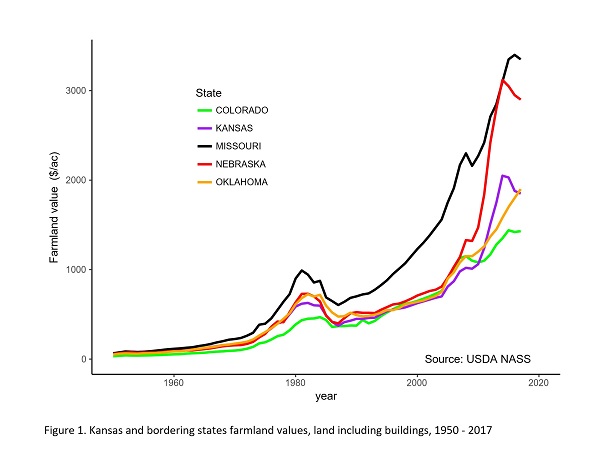
The number of farm bankruptcies is double the number of a few years hence: now 65-70 per year. Young farmers and those with high debt loads are the most at risk.
Land values in Kansas are down but the amount of reduction varies, depending upon how you measure it. The biggest declines are in dry land, with irrigated and pasture declining more slowly. Based upon property valuation figures from Topeka--from 6,845 actual land sales in the three years from 2014 to 2016--overall prices were down 10%.
This same sales data showed dry land down 17%, irrigated down 9%, and pasture 5% lower. For Cheyenne County, Kansas, the dry land is priced at $1,776, irrigated land at $3,786, and pasture is $1,278. Their agmanager.info website has detailed information: click here to see more information on land values.
Other topics included FSA loans, land rental values, and custom farming rates. To read more about the latter topic, please click here.
The presenters believe that a strong US economy will prop up oil prices, possibly raising fertilizer costs a little, although this trend isn't clear. It is possible that the weak farm economy will result in fairly constant prices for seed, pesticide, and machinery.
As to commodity prices, demand is strong across all sectors, and US production is strong but stable. Exports are in the middle of the normal trading ranges, but stockpiles are at record highs for corn and almost as bad for wheat. So any upward price pressure--possibly from increased exports or decreased domestic production--will be tempered by the big stockpiles.
Upcoming Meetings For Farmers

December 30, 2017
Jeanne Falk Jones, K-State Multi-County Agronomist, recently sent an email reminding everyone of two upcoming meetings for farmers. The first meeting, Farming For the Future, is in Scott City on January 10, 2018. Jeanne said that, "This meeting will give an overview of the current farm situation, a discussion of interest rates outlook, and a look at input costs..." The registration fee is $20 by January 5, and then $30. Register online here, or contact Jeanne Falk Jones.
The second meeting is the annual Cover Your Acres Winter Conference, held in Oberlin, Kansas, on January 16-17, 2018. Topics include smart spending of your fertilizer dollars, weed management, using soil moisture probes, and soil health and profitability in dryland cropping. They will also discuss farm economics, including profitability opportunities and pitfalls, and surviving and thriving in tough economic times. The cost to attend is $40 per day or $60 for both days, until Jan 10, 2018. Register online here.

Happy Holidays!
December 22, 2017
We hope that you have a wonderful holiday season and a safe and prosperous 2018!
Glyphosate and Cancer
December 10, 2017
According to this two-decades long study, which involved 89,000 farmers and their spouses, glyphosate is a not a risk for cancer, even among groups which apply the pesticide.

There are other studies which do find carcinogenic links, and the information is confusing. This Wired article does a good job of explaining some of the contradictions, and explains the different terminology employed: the difference between "hazard" and "risk", using a clever shark tank analogy.
Our take? Most human activity represents health risks: most of these risks are minor, but non-zero. In this case, we think farmers face many much greater risks than this one.
Dicamba Story Continues
November 26, 2017

According to this CropLife article, 3.1 million acres of soybeans were damaged by dicamba in the 2017 season, spurring a staggering 2,200 injury investigations. As the image shows, Kansas had 100,000 acres of beans reportedly damaged.
We have reported on this issue twice before, here and here , and yet the controversy has not abated. Monsanto has sued the government, there are rumors of banning dicamba except for early season applications, and Monsanto also accuses its customers of improper use and claims that illegal, out-dated formulations are being sold.
The CropLife article is a good summary of the present situation.
Corn Rootworm Resistance Options
November 12, 2017

We recently attended a re-certification seminar, and one of the speakers was Jeff Whitworth, KSU Entomology. Whitworth reviewed the 2017 growing season in terms of crop insects, and noted that the Sugar Cane Aphid, which was a major pest in milo in 2016, did little damage in 2017. We reported on the Sugar Cane Aphid here.
Whitworth also spend a fair amount of time discussing the issue of increasing Western Corn Rootworm resistance to Bt corn. He said KSU is seeing more and more resistance, and increase crop damage, including lodging.He added, "Bt is just an insecticide", and therefore resistance was to be expected. He said that some seed companies are going back to planting time treatments.
Jeff also noted that adult rootworm control--where the females are controlled via aerial application in the silking phase--can be very effective. He thinks adult control is "under utilized": Typically two treatments will keep the number of adults below 5 adults per ten plants: 0.5 beetles per plant is the threshold.
Since Grace Flying Service is in the business of treating adult insects, we want to agree with Whitworth. But even publications like the Huff Post are discussing the issue, perhaps with a little more alarm that it deserves.
In a related aside, we learned at a later conference about the history of pesticide resistance. Thaddeus Gourd, CSU Extension, said the first documented case was insecticide resistance: DDT in house flies in 1947. The resistant flies developed longer foot pads so that they didn't absorb the pesticide when they walked over treated surfaces. The first herbicide resistance was spreading dayflower, against 2,4-D in 1957, and benomyl debuted resistance to fungicides 1969.
EPA Reverses Course On Renewable Fuels Mandate
October 31, 2017
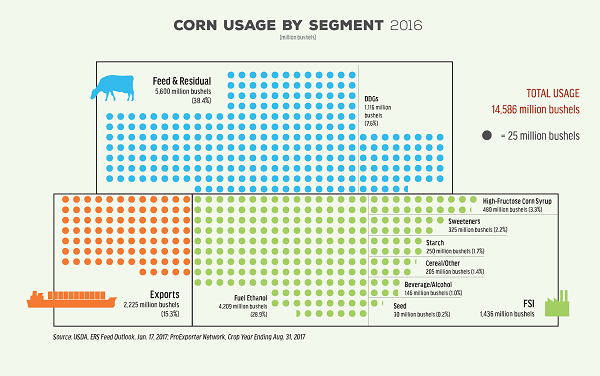
According to this Reuters article, EPA Administrator Scott Pruitt reversed a previous agency plan which threatened to open the door to cuts to the renewable fuel plan.
This reversal by Pruitt is a big win for corn producers and the biofuels industry, since about 40% of US corn production is used for ethanol. Reuters said the decision was spurred by lobbying "by Midwestern lawmakers, including Republicans Charles Grassley and Joni Ernst, had vocally opposed all those ideas, calling them a betrayal of the administration’s promises to support the corn belt." Grassley issued a statement saying, “It’s a great day for Iowa and a great day for rural America. Administrator Pruitt should be commended for following through on President Trump’s commitment to biofuels.”
The move dealt a blow to merchant refiners like PBF Energy Inc and Valero Energy Corp who have argued that biofuels compete with petroleum, and that the blending responsibility costs them hundreds of millions of dollars a year.
"The program disproportionately hurts mid-sized refiners and mom-and-pop gas stations that are the backbone of the nation’s energy infrastructure and needs to reformed", said Greg Blair, a spokesman for the Fueling American Jobs Coalition. In the EPA's letter, Pruitt said the EPA was prepared to work with Congress to examine the possibility of a waiver that would allow the year-round sale of E15 gasoline (which contains 15 percent ethanol), which is currently not permitted during the summer due to concerns about smog.
Monsanto Sues Arkansas Over Dicamba Ban
October 21, 2017

Monsanto is suing the Arkansas Plant Board, a state regulatory agency, over its ruling to ban dicamba usage in Arkansas for the 2018 growing season. This article in the St. Louis Post-Dispatch has details on the story, as well as a video which interviews two farmers with different views on the issue. In addition, we have previously reported on this issue: please click here to read our older articles.
Monsanto said this: "The Plant Board's arbitrary approach also has deprived, and if left unchecked will continue to deprive, Arkansas farmers of the best weed management tools available--tools that are available to farmers in every other soybean and cotton-producing state in the nation."
The lawsuit came on the heels of an agreement between the EPA and Monsanto, DuPont, and BASF. The agreement adds new restrictions to the dicamba label, including changing the product to a Restricted Use Product (RUP), which means that dicamba can now only be legally sold to certified pesticide applicators.
It is not clear how many of the problematic applications last year--which resulted in over 1,000 farmer complaints in Arkansas alone--were done by non-certified applicators. Many farmers in our geography already have pesticide certification, so it is possible that the change to RUP status alone might not make much difference out in the real world.
It is also not clear how much of the dicamba problem is due to physical drift as opposed to volatilization: We believe that the physical drift portion of this problem can be managed with careful planning and disciplined use of modern application techniques. Physical drift occurs at the time of application, and should be correctable with better training and enforcement of existing regulation. The thornier issue is rate of volatilization of the dicamba.
While pesticide volatilization often results in much lower concentrations of off-target movement than does physical drift, it can be damaging to sensitive crops, including cotton. Volatilization can also affect larger geographic areas. Volatilization commonly occurs hours or days after application, and is greatly affected by climatic conditions--including high ambient temperatures and atmospheric inversion layers.
Volatilization effects can be minimized with timing of applications, but the issue could only be truly solved if Monsanto changed the dicamba molecule itself. Alas, changing the chemical formulation is almost certainly technically difficult, and it would also likely require expensive and time-consuming re-regulation by the EPA.
It is worth repeating that the degree to which a herbicide volatilizes is inherent in the formulation, and is something that only the manufacturer can change: it is not in the control of the users of the herbicide.
There is no question that dicamba is an important herbicide for crop production, both because of the affordable price and the wide-spectrum control which it provides. However, since there are increasing numbers of weeds which are developing tolerance to dicamba, we fervently hope that Monsanto (and other manufacturers) are working on developing new, less volatile, products.
Land Sale In Bird City
October 13, 2017
A quarter section of mixed farm ground and CRP sold today at the American Legion building in Bird City, KS. The land was sold by the Gerdes family, and is located about half way between Bird City and Wheeler, about five miles south of the highway. The legal description is NE 1/4 13-4-39, and comprises roughly 97 acres of farm ground and 59 acres of CRP. The CRP has an annual payment of about $37 per acre until 2021.
There was a small crowd attending, and there were four off-site--internet--bidders. The bidding opened at $900/acre and slowly rose to $1,175/acre, which was the final selling price.
Farm and Ranch Realty of Colby, KS, managed the auction. Their website has a listing of selling prices of land they have sold since 2007: please click here to see those listings.
Precise Patterns For Ag Aircraft
October 9, 2017
On September 28, 2017, we attended a SAFE fly-in on the La Junta, Colorado, airport.
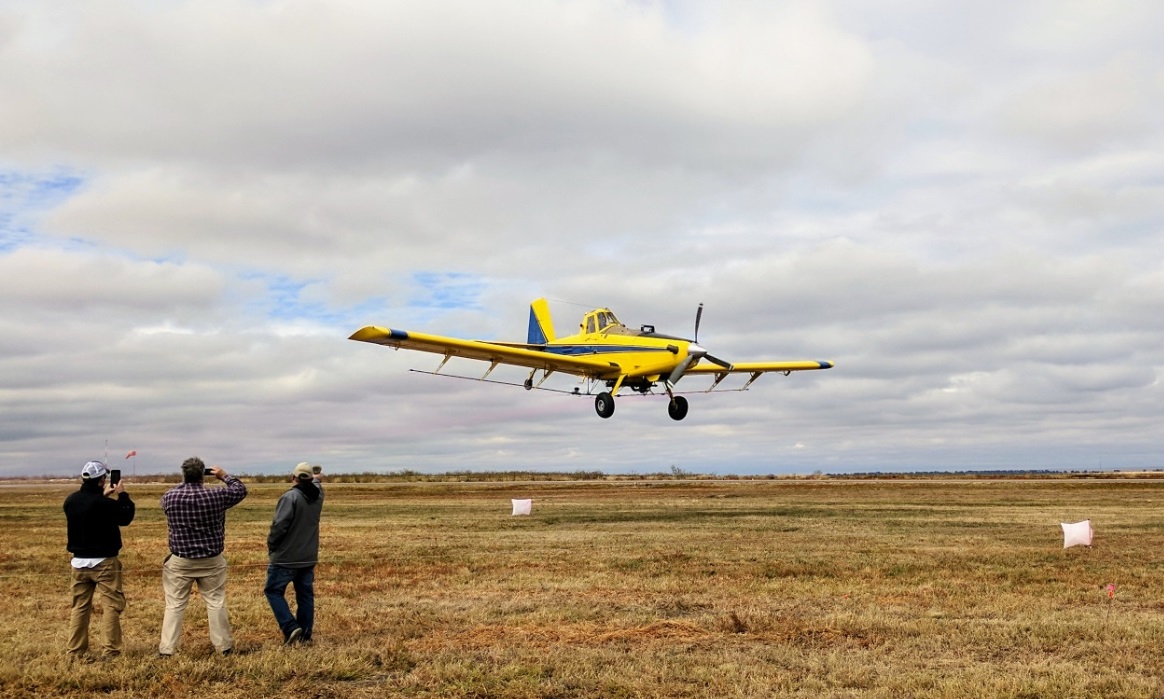
SAFE fly-ins are co-sponsored by the CAAA (Colorado Agricultural Aviation Association) and the KAAA (Kansas). The clinics are held several times per year in various locations to allow ag aviation operators the opportunity to fine-tune the calibration of their aircraft's spray pattern. Grace Flying Service aircraft have been calibrated using the SAFE system in the past, but at this event we were there to watch and learn.
The heart of the system is a string which is stretched across the aircraft's pass. The string collects a special dye dispensed by the aircraft. In addition, the aircraft's speed and height and the droplet sizes are recorded with other sensors. After each run, the string is analyzed with a computer which has an external device to determine the amount of deposition.
The net result is a graphic showing span-wise distribution of the swath. This allows modifications to be made to the system, if necessary. After changes, the aircraft may "fly the string" again, to analyze the efficacy of the modifications made. Trained operators download the data and make suggestions as to optimal swath width and nozzle options.
Please click on the 10-second MP4 video to see an Air Tractor applying dye to the string. After the pass, the string is rapidly rolled up and a clean string deployed for the next pass.
Airport Beacon Replaced
September 27, 2017

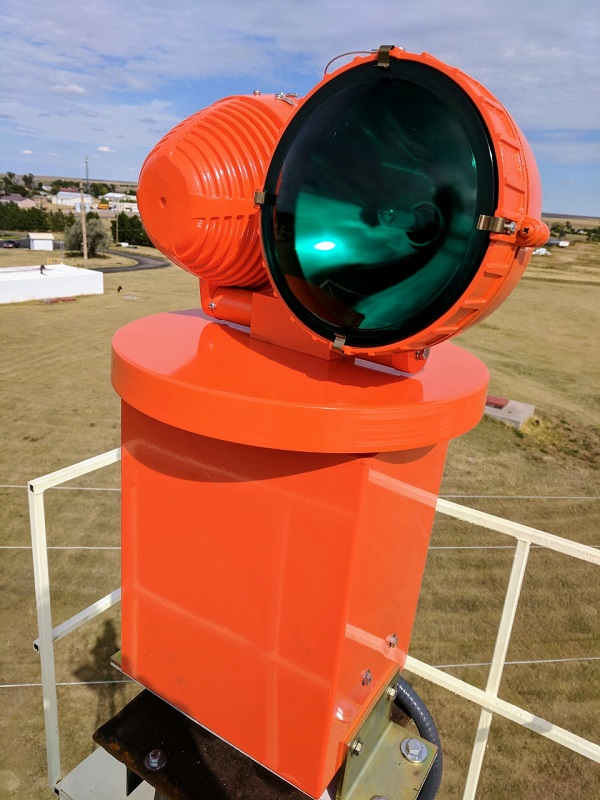
The flashing light at the Cheyenne County Airport has changed from a flashing white light to alternating green and white flashes. The green and white sequence is appropriate for a land airport, but for more than sixty years, the airport had only a flashing white beacon. The reason for this discrepancy has to do with aviation history, tight budgets, and truly phenomenal reliability from the Sperry Corporation about eight decades ago.
The old beacon was a retired airway beacon. It was presumably purchased as surplus, or possibly the Commerce Department donated the beacon to the tiny new airport. In any event, it was likely the cheapest way to provide a rotating beacon to the grass-runway airport, and the lack of a green flash was not considered a deal breaker. The airway beacon history is interesting:
According to this Wikipedia link, more than 1,500 of these beacons were used from 1923 to 1933. The Post Office, which had a need for reliable night flight to transport airmail, helped with the financing of this 18,000 mile network. Pilots flew from airway beacon to airway beacon, identifying them via a coded light flash, among other means. The obvious shortcoming to this system was that it was only useful at night, and in reasonably clear weather.
So when radio navigation appeared in the form of the Adcock low-frequency radio range , the airway beacons were quickly retired. But the builder, Sperry Gyroscope Company (which later became Sperry-Rand) did an excellent job of building the beacons, and this one kept spinning year after year, requiring only a few bulbs and belts. The 24-inch diameter parabolic mirror directed a very bright incandescent light as it spun round and round at 6 rpm, for more than 20,000 nights and more than a 100,000,000 revolutions, in heat waves and ice storms, all powered by a rotating brush. It's a big heavy device, so there was significant inertia, yet it was well balanced, and remarkably reliable.
This old airways beacon was, and is, a clever device. This one is serial number 11, as you can see from the photos on this page. We hope to find a happy home for this piece of aviation history.
The Adcock low-frequency radio range navigation which replaced the airways beacon is worth reading about: it required only a headset on the pilot, who listened to a continuous tone in headset: the Morse code for A and the code for N: "di-dah, di-dah" and "dah-dit, dah-dit" respectively. One letter meant that you were flying left of course, and the other indicated a right deviation. If you were in the middle, the two tones blended into a monotone. Read more about radio ranges here.
John Grace, a WWII Army Air Corps P-38 pilot, described the "radio range" system to us on several occasions. It was the only radio navigation system available, but difficult to use, especially when electrical interference--lightning, for example--made it hard to hear. Worse, the lack of precision over the "cone of silence" could create situations that were potentially fatal. War stories for another time...
If you'd like to see more photos of the retired airways beacon, please click here.
Pasture Thistle Postcard
September 7, 2017
We are mailing our annual musk and Canada thistle postcard to our customers who have noxious weeds. The text of the postcard is shown below, and the postcard will arrive next week.
If you don't get the postcard, and would like to be added to the noxious weed mailing list, please contact us.
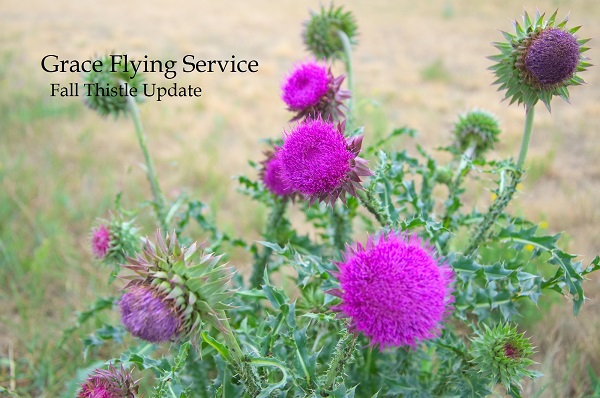
Postcard text:
"Fall is the best time to treat pasture thistles. Please contact us now if you want your pastures treated. We need your order and maps so that we can plan an application schedule.
"The window of opportunity can be very short in the fall. Also, the small field sizes mean we need multiple customers on a single load.
"Our deadline for taking thistle orders is Monday, October 9, 2017.
"Musk and bull thistle can be treated until the ground freezes, but Canada thistle needs to sprayed before a killing frost.
"We think the best chemical choice is GrazonNext HL, which is Milestone in a pre-mix with 2,4-D."
Insects in Sunflowers
August 15, 2017
As sunflowers begin to bloom, insect control becomes an issue. The two primary pests are head moth and red seed weevil, although there are several other pests which can be an issue. With confectionary flowers, most growers simply plan on two insecticide treatments about ten days apart, because the dockage from damage is so expensive, and the economic thresholds are so low.

With oilseed flowers, it makes sense to scout. With red seed weevil, the easiest method is spray the head with insect repellent to make the insects active and easy to count. The economic threshold is 10-20 per head. For head moths, 2-5 moths per head is considered economic. The moths can be difficult to find: scouting at dawn and dusk in light winds, while walking quietly, is recommended. Some scouts use a flashlight in the dark. Much more information is available from KSU by clicking here.
Wheat Streak Mosaic Meeting
August 14, 2017
We attended the KSU Wheat Streak Mosaic meeting at the Goodland 4-H building today. Speakers included Erick De Wolf, Plant Pathology KSU and Jeanne Falk Jones, K-State agronomist. The meeting included a brief overview of the method that disease is transmitted, and much of the information we reported here in our Wheat Field Day article.
In 2017, Kansas suffered wheat yield losses of $76 million dollars due to mosaic. Mosaic can be a very serious problem in wheat production. The severity of the 2017 disease was attributed to the very late first-freeze we experienced last fall, which was as late as mid-November.
Controlling volunteer wheat now is an important step. Because KSU recommends two weeks of dead, dry volunteer wheat before planting, and because chemical applications can take a week or more to dry the wheat out, treatment should occur very soon for proper timing. There is no chemical control for the wheat curl mite, so other than volunteer control, the two other options to control the virus are planting resistant wheat varieties and delaying wheat planting. The K-State Wheat Streak Mosaic guide is a good summary for managing the disease.
It was noted that some resistant varieties, such as Oakley CL and Joe contain the WSM2 gene, which provides resistance to the Wheat Streak Mosaic virus itself. This WSM2 resistance works best in temperatures below 65F, but KSU research is working on WSM3, which will provide resistance in higher temperatures and against other viruses. De Wolf estimated that it might be five years before a commercial wheat variety with WSM3 would be available.
Other varieties, such as Tam 112, Byrd, and Avery are instead resistant to the primary vector of the disease, the wheat curl mite. An excellent resource for more information on disease and insect resistance in various wheat varieties is the K-State Wheat Variety Disease and Insect Ratings 2017.
KSU would like to work with local farmers this fall to monitor wheat fields and even experiment with techniques to improve mosaic management. If you would like to help out, or just want more information, contact Jeanne Falk Jones.
Customer Postcard Is On The Way
July 14, 2017
We are sending a postcard to our customers today. The text is shown below. Please contact us if you aren't on the mailing list and would like to be added.
Postcard Text: "Late season control of spider mites in corn is no longer effective, so most corn is treated with miticides designed to kill eggs. Early treatment--before damaging numbers occur--is required because the mite population response to the miticide is slow.

"Product choices include Comite II, Oberon, and a new product: Portal. Comite II provides good mite control, and Portal has good reports. We have heard mixed reports about Oberon's efficacy in some areas, but if you have had good results in the past, it could be an option.
"Comite's restricted entry interval (REI) has been reduced, but it is still 13 days, which can be an issue for sprinkler repair. The other two products have REIs of 12 hours. Oddly, Comite's REI in milo is only 48 hours.
"Pricing for Comite II and Oberon is about equal, in the $25-$30/acre range (applied), depending upon rates. Portal is maybe 8-$10/acre more. The mite application is an excellent opportunity to give a "free ride" to Coron and/or a fungicide, since the timing for all three products is excellent.
"Spider mites can cause significant yield reductions. Please call us or talk with your consultant if you have questions."
Update On Dicamba Ban
July 10, 2017
Soon after we posted the article below, both Missouri and Arkansas have announced a ban on the sale and use of dicamba herebicide.
In this article, Missouri Director of Agriculture Chris Chinn announced that sales and on-farm use of dicamba would be suspended, and that the ban is being made "with an abundance of caution and is temporary until a more permanent solution is reached." In Arkansas, the ban is for 120 days.
Dicamba Ban Possible in Arkansas
July 7, 2017
Dicamba herbicide is making headlines in Arkansas and in the national news. This article explains the issue in some detail.
The issue is both complicated and politically sensitive: the Arkansas Plant Board asked Arkansas Governor Asa Hutchinson to ban dicamba for 120 days. Hutchinson then referred the decision to the Legislative Council, and that group has delayed making a decision on banning the herbicide outright, although they did impose stricter penalties for "egregious" misuse violations. Presumably, no one really knows what that statement means, further adding to the general confusion.
It is estimated that a third of Arkansas's 3.5 million acres of soybeans are a GMO variety which are dicamba tolerant, and can be treated with BASF's special formulation of dicamba, Engenia. The farmers who have invested in the dicamba tolerant seed want to continue dicamba use to control pigweed, a plant that is resistant to most other herbicides.
Reportedly, in some cases, the damage did not occur from physical drift but rather volatilization. This means that even if the herbicide was applied with proper drift control techniques, high temperatures and atmospheric inversion layers that occurred hours--or even days--later can create conditions wherein the herbicide volatilizes off of the treated plants and moves downwind in high enough concentrations to damage non-tolerant soybean crops. This type of damage cannot be blamed solely on the pesticide applicator because volatilization is caused by the inherent chemical properties of the herbicide and by so-called "acts of God."
Since volatilization often results in relatively low concentrations of herbicide on susceptible crops, our observation is that the crop damage is sometimes cosmetic, limited to cupped leaves. In these cases, the soybeans will often grow out of the symptoms with minor yield loss. But this is not always the case, and in a politically charged atmosphere, these types of arguments often fall on deaf ears.
We will keep you updated on this issue.
Growing Milo? Read This!
July 6, 2017
In the last two or three years, a new insect threat has emerged in sorghum: the Sugar Cane Aphid (SCA). Many farmers in our area remember that twenty years ago milo was a common crop, and the insect which did the most damage was the greenbug. The Sugar Cane Aphid is of the same family of insects, but is even more damaging to milo production.
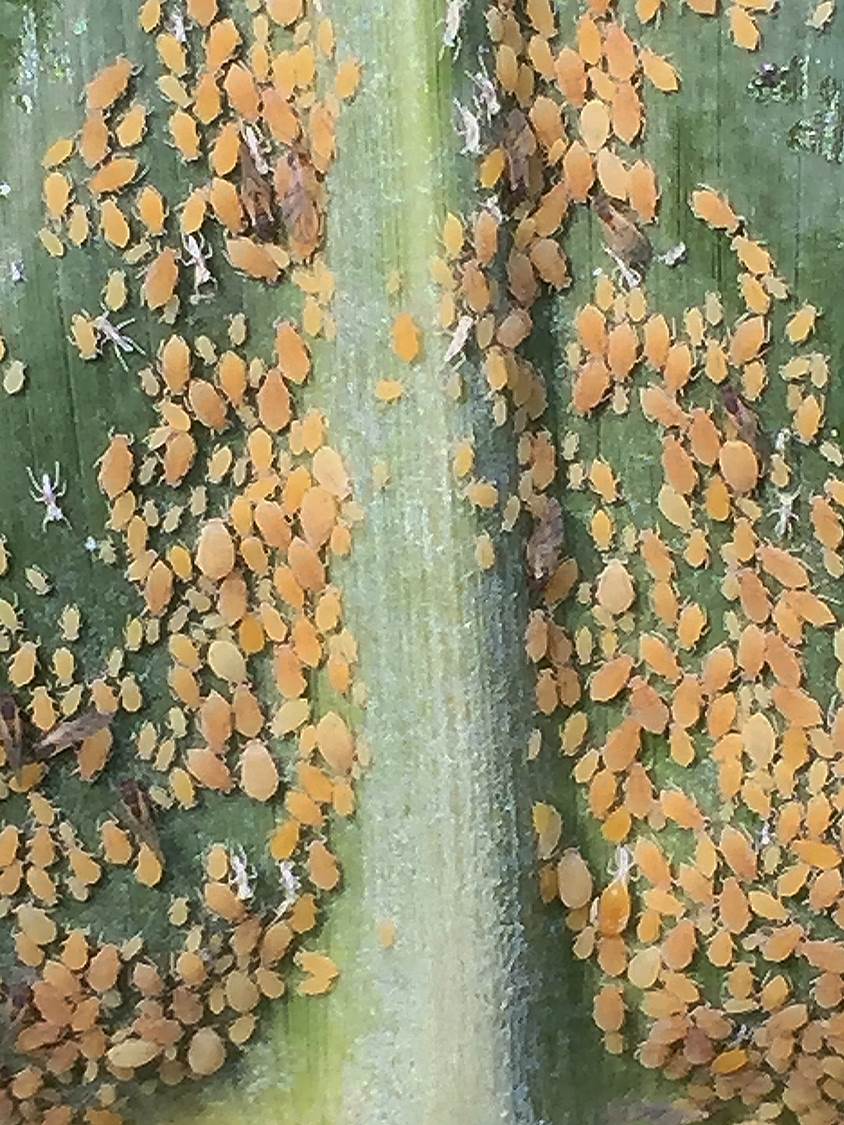
The good news for local farmers is that the SCA has not been found this far north. The bad news is that it has been moving our way: it was prevalent in the Dodge City area last year. No one knows if it will get this far north, but if it does, careful scouting and early treatment is essential to protect your milo yields.
At one of our meetings last year, Brent Bean reported that the Sorghum Association has spent $700,000 in 13 states to research the insect. He said that in some cases, yield reductions were 100%, and 50-70% reductions are quite possible without timely treatment. In the 2016 season, there were two insecticides that were effective: Silvanto and Transform. If you have headworms at the same time, other products are used in the tank mix. Naturally, the greenbug is still a threat, but it is generally less expensive to control.
The SCA is a milo insect: it generally does not invade other crops, including sugar cane. There are some reports of millet infestations, however.
Bean said, "Early treatment is critical, because of the rate of increase of the population: you can go from 50 to 500 aphids per leaf in two weeks or less. All SCA are born pregnant, and have 6-10 young per day for ten days, then the rate slows somewhat, but does not go to zero. Data shows that late treatment, even when it works well, results in reduced yields." In instances when the SCA arrives early in the season, two treatments might be necessary.
This KSU article says, "The SCA has a smooth body with a light colored head and light colored legs with dark feet. They have dark colored, short cornicles (tail pipes) with no shading at the base of them as on the corn leaf aphid."
Proper scouting is critical: this KSU guide has scouting techniques, treatment thresholds, and more photos. But the general guidelines are to scout weekly until insects and/or honeydew is observed, then begin twice-per-week scouting. Bean mentioned treatment when you reach 50-125 aphids per leaf. KSU's guide has slightly different guidelines. Taking photos at each scouting can help estimate the rate of increase of the population, too.
There are resistant varieties of milo, and these can delay the need for treatment significantly. Seed treatment with the common insecticides is also effective in delaying treatment: both of these techniques are recommended if the SCA moves into our area. Early planting might also help, Bean said.
In 2016, there were cases where the insects arrived late in the season, and growers hoped to simply skip treatment and harvest the grain because the plant was mature. But this tactic failed, because the insects were so numerous that the combines plugged up, and they had to treat to allow harvesting. Since both labeled insecticides have a 14 day pre-harvest interval (PHI), this was a major issue. Clearly, the SCA is a serious threat to milo production.
If we hear of SCA infestations near this area, we will keep you informed. It is probably a good idea to click on the KSU links above if you aren't already informed about the Sugar Cane Aphid.
Kansas Court Rules For Corn Farmers Against Syngenta
June 23, 2017
Today, a federal jury in Kansas City ordered Syngenta AG to pay almost $218 million to 7,000 Kansas farmers. The farmers claimed that, in 2010, Syngenta commercialized a GMO corn seed--Agrisure Viptera--before that variety was approved for export to China.
The Friday verdict included only compensatory damages, and Syngenta will appeal the verdict. A simple math calculation shows that the verdict totaled about $31,000 per farmer.
According to this Reuters story, thousands of other corn producers are also seeking damages for the same reason. Lawyers for the corn producers claim that this is "only the beginning", adding that damages will total $5.77 billion dollars: 25 times more than this ruling. The damages are based upon the price of corn dropping sharply in 2013, when China refused shipment of millions of tons of the unapproved GMO strain.
Syngenta denies wrongdoing--and in what could be interpreted as a thinly veiled threat--said, "We are disappointed with today's verdict because it will only serve to deny American farmers access to future technologies even when they are fully approved in the U.S."
Ironically, Syngenta is now owned by a Chinese company, China National Chemical Corporation, after a $43 billion purchase in early 2016.
We wonder what happened to the Viptera corn that was produced in the two seasons prior to the Chinese ban...?
KSU Wheat Test Plots
June 14, 2017
Tonight we attended the KSU Wheat Day, which is a review of more than two dozen wheat test plots which are located 5 miles south of Wheeler, Kansas, on the west side of the highway.
There were more than forty farmers attending, and detailed descriptions of each wheat variety were given by Erick De Wolf, Plant Pathology KSU, Lucas Haag, Extension Agronomy Specialist from Colby, and Jeanne Falk Jones, K-State agronomist.
Because of the extensive damage this year to wheat in western Kansas due to wheat streak mosaic (WSM), many questions were asked about that viral disease. WSM is spread in the fall with the wheat curl mite as a vector for WSM (and two other very similar viruses). In many cases this year, large areas of wheat were damaged so badly that they won't be harvested, reported De Wolf.
There is no chemical control for the curl mite, so the primary protections against WSM consist of three basic options: planting WSM resistant wheat varieties, controlling volunteer wheat in late August for perhaps a mile around the planted wheat, and delaying wheat planting for 7-10 days. None of these options provides perfect protection, but a combination of techniques will help, according to De Wolf.
Stripe rust in wheat was another topic, and De Wolf pointed out which varieties are more resistant to the various rusts: stripe, leaf, and stem. Planting these resistant varieties can provide benefits in a year when rust is prevalent, including less damage from the disease, and the option to delay or omit treatment, depending upon rust severity and timing.
When questioned about the issue of common fungicides losing efficacy due to resistance by rust, De Wolf said that tebuconazoles would likely have a gradual loss of efficacy over several years, while the strobilurin family might lose resistance quickly--with a single year failure occuring without warning. He added that research on the fungicide resistance issue is being done in the Northwest US, and resistance has been found in those studies.
After harvest, yield data will be available from the wheat test plots. Jeanne Falk Jones will send it to everyone on her email list. You can join her excellent email list by contacting her.
Supreme Court Ruling Supports "Right to Repair"?
June 4, 2017
On May 30, 2017, the Supreme Court reversed the Federal Circuit Court in the Impression Products, Inc. v. Lexmark International Inc. case. (We previously reported on the "Right to Repair" issue here.)
According to this EFF article, this Supreme Court ruling "says that once a patent owner sells a product, it cannot later claim the product’s use or sale is infringing. This principle prevents patent owners from controlling goods after sale and interfering with your right to resell, tinker with, and understand the things you own."
Even though this ruling concerns reuse of printer cartridges, the underlying principle is likely much broader, and could reduce John Deere's ability to limit repairs of equipment owned by farmers.
Heavy Rain, Hail Damage Occurs
May 26, 2017
The spring of 2017 has been both cool and wet. This weather pattern--while providing ample and appreciated moisture--has delayed corn planting for some farmers. Some have already changed to a new seed number, and are anxious that they might have to go an even shorter season variety.
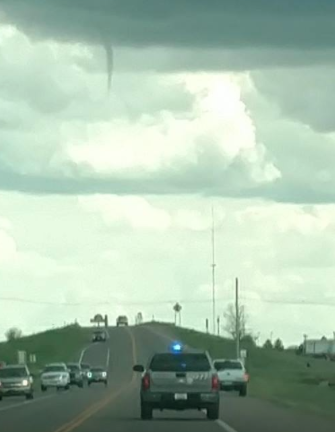
On May 26, a large line of thunderstorms moved through the area. Unofficial reports say that up to five inches of rain were dumped in portions of Sherman county. The National Weather Service issued both tornado and severe thunderstorm warnings early in the event, and flash flood warnings afterward. The next day, many normally dry creeks were running completely full, and much wheat damage occurred from the large quantities of hail. In addition, word-of-mouth reports are that vehicles and buildings suffered severe damage.
The Salina Post published a picture of a small funnel cloud. The photo was taken by the Sherman County Sheriff.
Honor Students Recognized
May 19, 2017
We began our Honor Student Recognition Program in 2005--more than a decade ago. We wanted to recognize and reward academic excellence in our High Schools, as we believe that learning matters now more than ever.

Every May, we provide a letter of commendation and a small memento to the top five students in the high school classes of Idalia and Saint Francis. The Honor Student awards are presented at the year-end Awards Ceremony in the respective schools. This year was no exception, and the personalized USB storage keys were awarded last week. We believe that we have now recognized more than 700 students!
You may read more about the Honor Student program and view a complete list of the names of the recognized students by clicking here. It's a great group!
Update on Wheat Rust Treatment
May 18, 2017
We have been flying every available minute for the last eight days, with three airplanes in the air. Many of our customers are now protected from the rust pressure, but the cloudy, wet, and windy weather has slowed us considerably in the last two days. The weather is not only problematic for us: the wet weather and poor drying conditions are also delaying corn planting for many farmers.
As this is written, our aircraft are grounded due to weather: however, we have used the down time to perform routine maintenance. We hope to finish most of the booked work in the next few days, as soon as the weather cooperates.
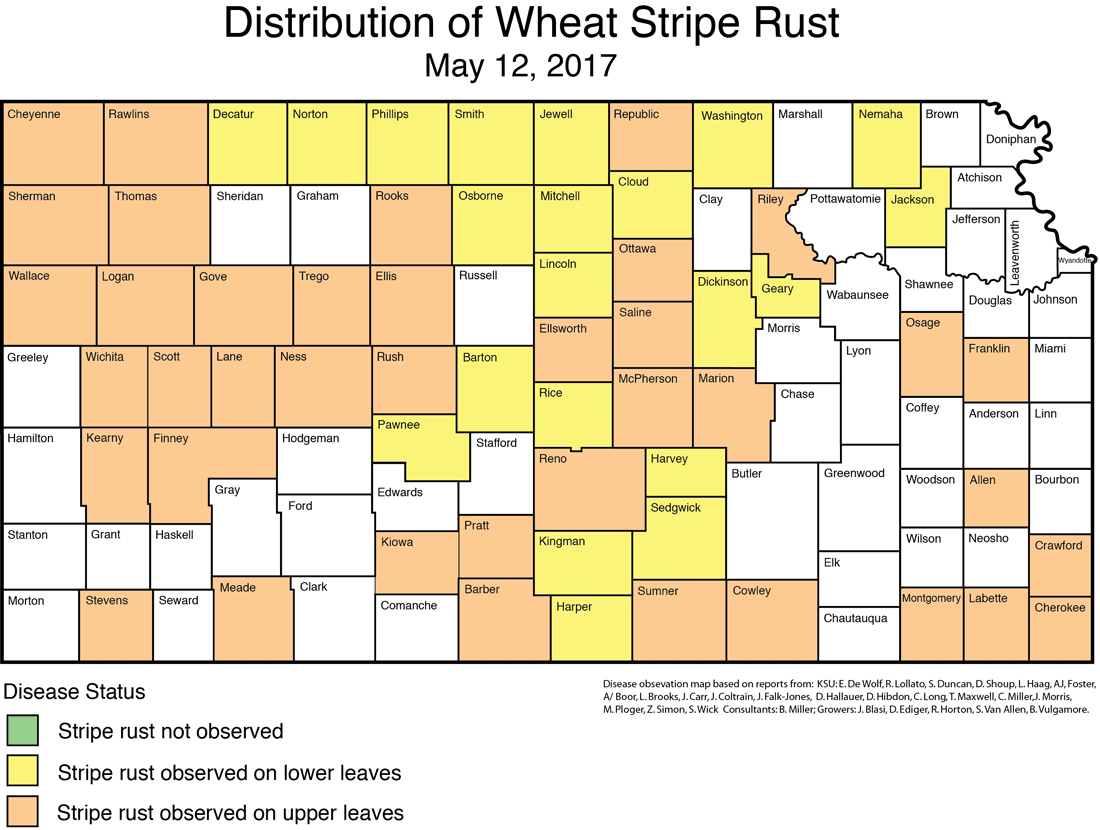
Local reports say that rust is slowly increasing in the wheat, but despite the favorable weather for rust development, the disease is not increasing as rapidly as in past years. Ironically, the same weather which is slowing our work and corn planting is good for rust development. The favorable weather for rust development is causing some farmers to decide to treat.
The May 12, 2017 K-State Extension Agronomy eUpdate on stripe rust says, "Stripe rust and leaf rust were rapidly increasing in incidence and severity in parts of central Kansas this week. . . Observations this week indicate that stripe rust has increased in severity in many fields of susceptible varieties that were unprotected by fungicides. In some cases, more than 30 percent of the flag leaf area has been damaged by the disease."
As you can see from the newest map, our region shows rust on the upper leaves of the wheat. To read the entire KSU eUpdate, please click here.
Wheat Rust Treatment Has Begun
May 10, 2017
Starting two days ago, rust treatment orders in wheat started pouring in. We covered a lot of acres in those two days, as we had good weather. Heavy rains have occurred both nights, and more rain is forecast for today and tomorrow, so it may this weekend until we can go "full blast" again.
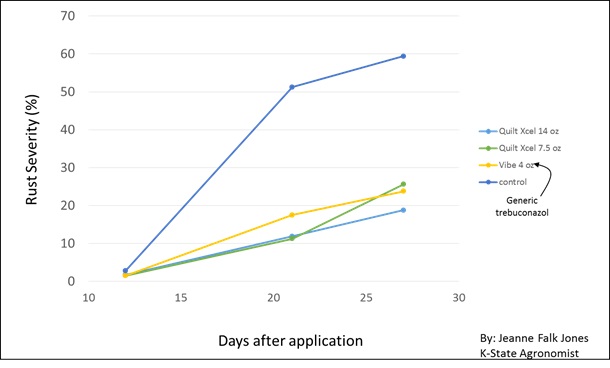

The rust levels in the wheat are presently low, but the farmers who have elected to treat are concerned that reports of rust "blowing up" south of us--in Scott City--mean that treating early makes sense.
We have called Paul Soulek, Ascend Ag, Inc., from Spearfish, SD, to help us again this year. Paul helped us last year in his new turbine Air Tractor, and he did excellent work. His arrival, scheduled for Thursday, will increase our capacity by about 80%: Timely treatment is important, and Paul's airplane should make that possible. Since infection levels are still low, we have time. But the flag leaf is emerged, so if infections explode, treatment needs to be as soon as possible, and weather can delay us for several days.
Our customers are choosing generic tebuconazole for their treatment, and we generally agree with this choice. Tebuconazole is less expensive, and provides nearly identical control as the more heavily advertised products. We have had excellent control in previous years. The two images--from Jeanne Falk Jones--show fungicide comparisons from 2016.
Erick DeWolf, KSU, specialist, has a complete article on the subject, and we recommend reading the entire article if you have questions.
Here is an excerpt from the DeWolf article: "In tests conducted by universities throughout the Central Plains and Midwest in recent years, researchers have found no significant differences in the efficacy of products with identical active ingredients. In other words, the generic fungicides are equally effective when used at the same rates as other products with the same active ingredient. "
We do agree with DeWolf that managing resistance to fungicide products might mean changing active ingredients in future years: using the same product year after year is normally a bad idea.
A May Day Mayday
May 2, 2017
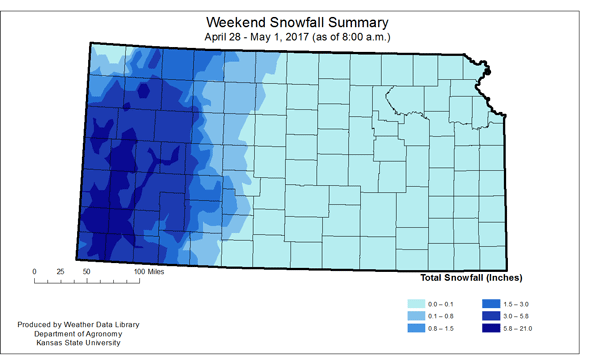
This KSU eUpdate describes the snowfall event which occurred over most of western Kansas on the weekend of April 29 through May 1, 2017. The snowfall missed Yuma county in Colorado, and only impacted the far southeast corner of Cheyenne County, Kansas. It is possible that the missed moisture opportunity was more than offset by the lack of wheat damage.
The report has several interesting maps, and attempts to analyze possible wheat damage, but notes that until the snow melts, there is a lot of speculation and less hard data. Still, when tall wheat is both buried and flattened by wet snow, and exposed to cold temperatures for many hours, it is tempting to guess that yields were reduced.
The event was widespread: KSU says, "anywhere from 1 to more than 21 inches of snowfall covered the majority of western Kansas, which corresponds to roughly 40% of the wheat acreage in Kansas."
Wheat Disease, Again
April 24, 2017 (updated April 26)
We have reports of stripe rust in the Oakley, Kansas, area, and aerial treatment is now occurring in Hamilton county. The recent cool nights and rainfall events are both favorable to rust development, according to KSU. Here are some pictures of stripe rust developing on wheat leaves, and a table of wheat variety resistance ratings.
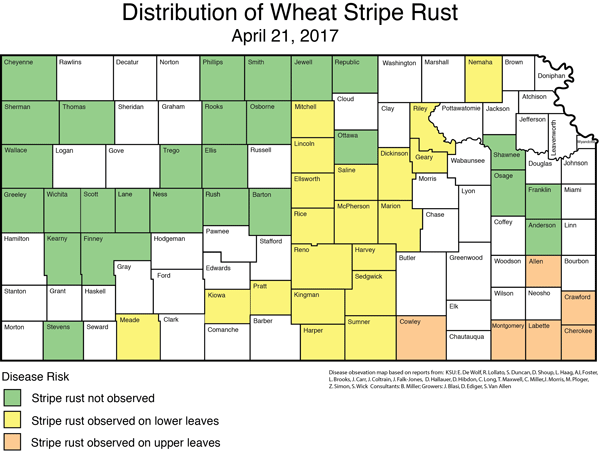
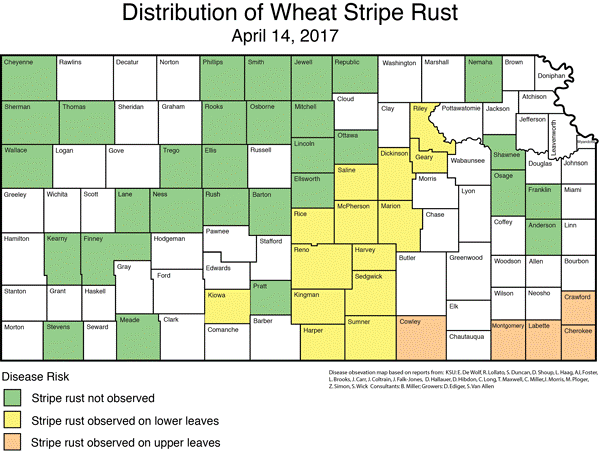
In this KSU article, Jeanne Falk notes that wheat streak mosaic is common in our region, presumably because of favorable environmental conditions last fall for the wheat curl mite. At this writing, Falk hasn't found either stripe or leaf rust in the wheat in our immediate area.
We have one reliable report of both stripe and leaf rust in Hamilton County, which is about 120 miles south. We also know that extensive aerially applied rust treatment is occurring near Wichita. We agree that the fields which are most likely to need treatment--if rust moves into our area--are susceptible varieties, seed wheat, and fields with high yield potential, especially irrigated wheat.
Stripe Rust Update
April 11, 2017
In this KSU Extension Agronomy eUpdate--dated April 7--Erick DeWolf reports that stripe rust has been found in wheat in southeast Kansas.
The report says, "The recent period of cool temperatures and frequent rainfall has been highly conducive for the continued spread of the disease. We will likely see more signs of disease continuing to show up over the next 14 days. What happens after this first wave of infections is critical to the development of an epidemic. The risk of severe disease and yield loss will increase if we get into another period of cool temperatures (44-55 degrees F) and frequent rains. Temperatures above 60 F at night often slow the development of stripe rust."
The KSU report has more information and a color coded map.
Our New Website
April 1, 2017
Version 2 of our website is up and running. We are still tweaking the rough edges, but the site is happily residing on the new servers, anxiously waiting for you to click on it. If you want to know more about the site, please click here.
Wheat Postcard Summary
March 30, 2017

Our customer postcard is being sent today. The text says:
"The warm, dry spring made wheat herbicide application difficult. It finally rained, but the wheat is near joint stage, which means that dicamba can no longer be safely used to control resistant kochia.
"There are still at least two excellent herbicide options available: Colt+Salvo and Starane Flex. Both products allow treatment until flag leaf emergence, and the fluroxypyr in them provides good control of resistant kochia.
"These applications cost more than dicamba, but they offer both better timing flexibility and improved control, especially on late-emerging kochia. We recommend adding Ally to obtain some soil activity.
"We have Coron in stock, if you'd like to add foliar feed to the application."
Finally, It Rained!
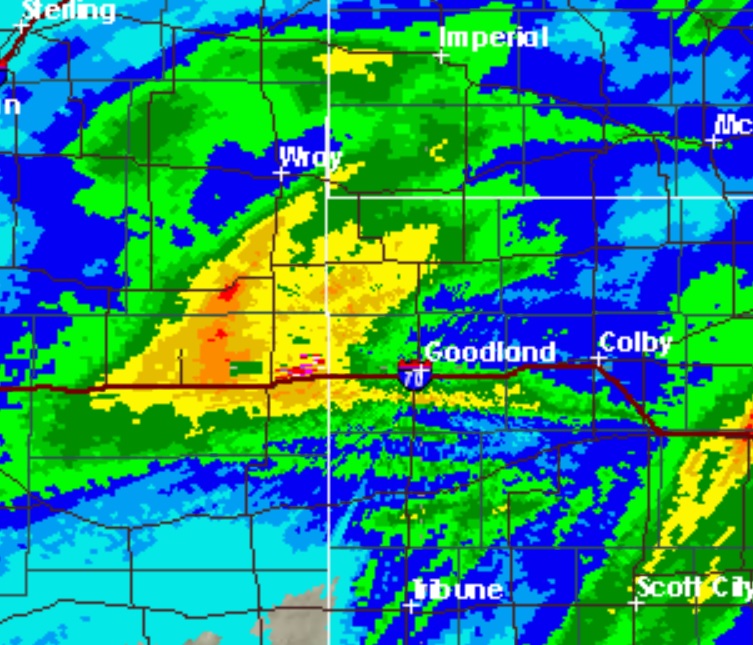
March 24, 2017
Over the last 24 hours, badly needed rains arrived over most of the tri-state area. Some areas received more than 2 inches of rain, and much of the area had at least one inch. The wheat was beginning to show drought stress, and the pastures weren't greening up. Corn ground was dusty. The rain occurred when a low pressure parked over the region for long enough to do real good.
There may be someone who didn't like this rain, but we don't know who it is.
Wheat Herbicide Applications Are Beginning
March 17, 2017
Despite the lack of badly needed rain, we are now treating wheat for weeds. In some cases, the customer is adding Coron as a topdress application. We think that these treatments make sense, because dicamba resistant kochia is a real threat in many wheat fields, and treating early is the preferred option for best control . When it rains, these treated fields will be ahead of the game.

Caterpillar Company Raided by Federal Agents
March 7, 2017
The IRS says that Caterpillar owes the US government more than $2 billion dollars in taxes because of an alleged illegal off-shore accounting scheme based upon a Swiss Caterpillar subsidiary.
A recent raid of three Peoria offices by federal agents underscored the seriousness of the government's long standing allegations on the issue. In addition, Dr. Robinson, an expert on the issue, accused the company not merely of negligence, but outright fraud: “I believe that the company’s noncompliance with these rules was deliberate and primarily with the intention of maintaining a higher share price. These actions were fraudulent rather than negligent.” If convicted of fraud, Caterpillar's penalties will be much higher.
Caterpillar representatives say that the company's actions are prudent and lawful. The stock price dropped significantly after the raid, partially based upon fears that the company might be excluded from government contracts just as the new US president has promised a $1 trillion infrastructure program. You can read more in this New York Times article.
A Very Warm February
February 24, 2017
According to this excellent Washington Post article, this February has been one of the warmest ever--at least in the eastern two-thirds of the US. The article notes that "A stunning 2,805 record high temperatures have occurred across the nation this month compared with just 27 record lows." Not surprisingly, levels of ice and snow are at very low levels.
Kochia Control in Corn: KSU's Recommendations
February 20, 2017
KSU strongly recommends that corn ground should be treated "late-winter" with pre-plant applications in order to control the glyphosate-resistant kochia populations that are becoming increasingly common.
This link has photographs and tables to buttress their arguments, and includes specific herbicide recommendations. It is worth reading if you haven't attended a recent seminar on this issue.
"Right to Repair" Legislation
February 12, 2017
This Apple Insider article says that five states will have "Right to Repair" bills in Congress this year. The states of "Nebraska, Minnesota, New York, Massachusetts, and Kansas all aim to make it easier for consumers to fix the devices themselves, by publishing service manuals not typically viewable by the public, and making it easier to acquire spare parts."
The proposed laws not only allow consumers to repair their own products, but also allows third-party repair shops to better repair your products. At least two major companies, Apple Computer and John Deere are lobbying strenuously against the laws, claiming that the new laws would “make it possible for pirates, third-party developers, and less innovative competitors to free-ride off the creativity, unique expression and ingenuity of vehicle software.”
Some argue that if only one state passes the legislation, it will effectively become law in the entire USA, because the manuals will be available everywhere, and because big companies don't like different procedures and restrictions in different states.
Here is a copy of the letter than John Deere wrote to the Kansas legislature, in response to Kansas House Bill HB 2122.
New GFS Website Is Getting Closer
January 5, 2017
We had a website early in the game: 2005. That original site has served us well, but the underlying technology has gotten old. We are working hard at creating a new one--using HTML5 and CSS3--as well as optimizing it for both phones and the larger screens on laptops and desktops. Don't worry: After we get the new site going, we'll reformat the old data and bring it along.
The new site is also light-weight, which means it should load quickly in areas of limited bandwidth.
More Loading Capacity

December 12, 2016
This past spring, Grace Flying Service added onto our loading building. The original 40x40 building--which features specialized loading equipment and complete containment both when unloading pesticides and during the mixing process--now has an additional 1,200 square feet of warehouse space.
The new 30x40 area has complete containment, but it is not a loading or mixing area. The larger building worked well this year, providing us with increased inventory in peak season.
Update on Wheat Rust
May 5, 2015
Farmers are booking wheat to be treated for rust. Most field reports indicate light rust infestations lower in the plant, but the wet, cool weather is ideal for rust development. We have treated some irrigated wheat, but we are getting calls for dryland fields now. The timing is important: treatment should occur immediately after flag leaf emergence, if possible.
It's Your Data...
June 29, 2014
The battle over farmers' data--which is sent into the "cloud" by modern farming equipment is heating up--according to an article in Ag Professional. The article says, "So far, farmers have been willing to share data to gain specific details on farm conditions, and companies have said they do not intend to pay farmers for data. But with Big Data companies planning to sell customer-made seeds or peddle precise crop production estimates, farmers now want a share of the value stream."
To read the entire article, please click here.
NOAA: Drought Lessens
March 16, 2014
The climate prediction Center at NOAA shows our region in the areas labeled drought remains but improves and even drought removal likely. The latter classification means that we may not be considered in the drought region by May 31, 2014. Click here to see the drought map.
Ethanol and Crop Insurance
April 15, 2013
Two separate proposals which would affect farmers have been announced in the nation's capitol.
President Obama, in announcing his budget, proposed reductions in the farm bill which alleges a total of one billion dollars per year in savings. He proposes reducing the share which the government pays into crop insurance, both in the premium subsidy and in the government's share of the administrative costs. Right now, the president says that 62% of the premiums are paid by the government. The new budget also proposes eliminating the $5 billion per year "direct payment." To read more about the proposed budget reductions,
click here.
The second announcement, which might have even greater effect, is
legislation proposed by four Congressmen to eliminate the biofuels mandate
in the Renewable Fuels Standard. The proposed law would rescind the
requirements of blending up to 15 percent ethanol into the fuel supply, and
would prohibit corn-based ethanol from being used to meet the RFS. This
proposal is supported by a broad coalition of food groups and the National
Cattlemen’s Beef Association and the National Pork Producers Council. To
read more about the RFS legislation,
click here.
Only 18 Months?
March 12, 2013
A Texas man who shot a crop spraying airplane with his rifle has been sentenced to 18 months in prison and almost $300,000 in fines.
The shooter, James Cate, used a single-shot Ruger Number One rifle chambered in 25-06. He fired three warning rounds before he hit the aircraft which was treating his neighbor's field in Coleman county, Texas. The aircraft was damaged, and bullet fragments tore the pilot's jeans.
To read the entire article, click here.
Solar Power
February 26, 2013
While our airplanes are still powered by fossil fuels, we now have solar panels providing electricity for our office. Last fall, we installed a 2.25 kilowatt grid-tie solar system, and it has been quietly producing power since then.
If you are interested, we have a webpage which has photos and full details of the system: please click here.
Supreme Court: Monsanto vs Bowman
February 19, 2013
In a fascinating case, an Indiana soybean farmer, Vernon Bowman, will face off against Monsanto in front of the Supreme Court next week over a patent issue that many believe will greatly affect agriculture, medicine, and other industries.
The case is complex, because Bowman purchased Monsanto's engineered seeds for his first crop, but bought less expensive elevator seed for his second planting. The elevator seed, which was a mixture, carried no patent technology agreement and no directive prohibiting seed saving, unlike the Monsanto seed used in the first crop.
Bowman argued that Monsanto's rights to the seeds he purchased from the grain elevator were exhausted because they were not the first generation seeds other farmers had purchased and planted, but rather a mix of later generation progeny.
"It didn't occur to my mind that this would be a problem," said Bowman, who doesn't have a computer at home so he goes to the library to read about his case on the Internet. "Farmers have always been allowed to go buy elevator grain and use for seed. You have no idea what kind of seed you're buying at an elevator. They claim I'm making a new seed by planting it. But that's far-fetched reasoning."
Monsanto argues that without patent protection, they can't afford expensive research to develop more transgenic seed in the future.
Read the entire article here.
Droplet Size Vs Efficacy
February 12, 2013
Aerial applicators have spent decades weighing the trade-off between droplet size and pesticide efficacy. Thisarticle details new research in Nebraska using wind tunnels and actual pesticides--instead of water--to analyze those issues for both aircraft and ground rigs.
One of the researchers, Greg Kruger, University of Nebraska, says that the majority of work being done is aimed at determining what droplet size provides the best efficacy for pesticides currently on the market. In the past, the EPA promoted larger droplet sizes to control drift without regard to efficacy.
The article has several charts and tells how to obtain a phone app to calculate droplet size for ground rigs.
EPA Says RFS Not The Problem
November 21, 2012
The EPA--after completing a ninety-day review spurred by requests from two
governors--has decided to move forward with the mandate for corn ethanol in
gasoline used in the renewable-fuel standards (RFS) program.
EPA said the standard was not causing economic harm, and that suspending it
would reduce corn prices by only 1%. Livestock producers, who believe the
mandate is driving up corn prices in the current drought, will likely
dispute the 1% number.
"We recognize that this year's drought has created hardship in some sectors
of the economy, particularly for livestock producers," said Gina McCarthy,
EPA's air chief said in a statement. "But our extensive analysis makes clear
that congressional requirements for a waiver have not been met and that
waiving the RFS will have little, if any, impact."
To read more about this issue, please see the August 29th story below
To read the EPA story, please click
here.
Isobutanol: Ethanol Redux?
October 18, 2012
According to this article in the PEI Journal, the use of ethanol to meet the EPA's clean fuel mandate will soon hit a "blend wall", perhaps as soon as next year. The idea is that most vehicles currently on the road can not use more than 10% ethanol mix, yet the EPA requires a higher percentage of ethanol to meet the revised Renewable Fuel Standards guidelines. Indeed, even with the full 15% ratio, the blend wall is hit in 2016.
The solution, quite possibly, is substituting isobutanol for ethanol, which will avoid the "blend wall" scenario completely assuming a slight modification of the EPA rules. Isobutanol is nearly perfectly suited for this exchange, as it has lower vapor pressure, higher energy content, and lower water solubility than ethanol, and is much less likely to cause equipment materials degradation.
The only shortcoming of isobutanol is its lower octane value, but since higher blending ratios are feasible--24% compared to 15% for ethanol--even this problem is neatly solved as the resulting fuel mixture has an even higher percentage of renewable content.
Since isobutanol and ethanol can be mixed, storage, distribution, and transport facilities can easily make the conversion from one to the other. Likewise, existing ethanol production facilities are easily converted to isobutanol, since both products can be made from corn, sugar cane, wheat, sorghum, and grasses.
If the PEI article is correct, it appears that isobutanol is a very likely substitute for ethanol. We will keep you posted.
Bt Corn Resistance
September 30, 2012
In this technical discussion of insect to resistance to Bt modified plants, Bruce Tabashnik explains how the relationship between recessive genes in resistant progeny, the size of the refuge, and the dosage which the Bt produces combine to affect the rate of insect resistance.
While it is possible that the discussion from the National Academy of Science might tell you more than you want to know about transgenic crop resistance, if want to fully understand this serious issue--which affects virtually all corn farmers--this is an excellent article.
Click here to read the article.
US Corn Prices Are Global Concern
August 29, 2012
US corn prices, which are now over $8 per bushel, are the subject of international scrutiny. The target of the outcry is the mandate by the EPA to produce ethanol from corn, an industry which now consumes 42% of the corn production.
In this recent article from the BBC, USDA statistics are cited, claiming that US "corn production in 2012-13 will be 10.8 billion bushels, some 2.2 billion bushels less than it predicted last month and the lowest since 2006-07." The article predicts even higher corn prices, and notes the United Nations' recent call for suspension of ethanol production targets in the US.
In rebuttal, US Agriculture Secretary Tom Vilsack said the biofuels standard was having a positive impact on the country: "It is impacting in a positive way the cost of gasoline in this country - some estimates put it at 25 cents to as much as $1.30 less for gas because we have a biofuel industry."
A minority of members of the US House and Senate have called for the EPA to halt or lower ethanol mandates in the US, according to this article. The article also cites Growth Energy Chief Executive Officer Tom Buis as saying that ethanol production results in distillers grains, a byproduct of manufacturing the fuel, that can be fed to livestock and poultry.
Rain!
July 8, 2012
Much of the tri-state area received badly needed rain during the night of
July 7. Rain reports ranged from 1.5 inches to over 4 inches in localized
areas.
After a long drought--which was accompanied by record high temperatures--the
rains will put some green color into the brown grasslands, and may save
withering dryland crops. In addition, the volunteer fire departments will
get some badly needed rest after fighting numerous grass fires.
The rains were so heavy that flash flood warnings were issued by the
National Weather Service on Sunday morning. But the problems of standing
water and muddy roads are generally welcomed by the majority of farmers,
given the severity of the preceding drought.
More Bad News for Bt Corn Seed
June 17, 2012
Because of increasing incidences of failure of Bt hybrids to corn rootworm
attacks, there is speculation that the EPA might increase the refuge
requirement to 50% of planted acres.
In
this article, Mike Gray at the University of Illinois, says that he has
found found rootworm adults scavenging for food, since silks, tassels, and pollen are not yet available, because the corn is early. The insects have been removing the top cell layer of corn leaves, causing the corn leaf to take on the appearance of rough paper. In fields where adults are being found, Gray says he is also finding substantial root pruning, which is evidence of heavy populations of rootworm larvae.
2012 Farm Bill in Senate
May 30, 2012
On Thursday, May 24, U.S. Sen. Debbie Stabenow, chairwoman of the U.S. Senate Committee on Agriculture, Nutrition and Forestry, introduced the Agriculture Reform, Food and Jobs Act of 2012 (S.3240) into the U.S. Senate.
The 2012 Farm Bill is long and complicated, and as this article by Matthew Grassi concludes, it may face difficulty in the House, where the Republican majority is pressing for more extensive cuts to food assistance programs. Also, southern senators say the shift from direct payments to a system based on crop insurance discriminates against Southern crops, particularly rice and peanuts.
Grassi also says that the Farm Bill would repeal longstanding Direct Payments, Counter-Cyclical Payments (CCPs), and both the Average Crop Revenue Election (ACRE) and the Supplemental Revenue Assistance Payments (SURE) Programs, creating $15 billion in deficit savings.
Further, the 23 existing conservation programs will be consolidated into four “fundamental program functions,” reportedly saving taxpayers $6 billion.
To read the entire article, click here.
Honor Students Recognized
May 18, 2012
For the last eight years, Grace Flying Service has recognized high school students who display academic excellence by finishing in the top five of their class. The 2012 students were honored this week.
Since 2005, the company has provided the Idalia and St. Francis schools (the Bird City School Board declined the offer) with a letter of congratulations and an Honor Student t-shirt for each of the top five students in the freshman through senior classes at the annual awards ceremony at both high schools. In addition, each student's name is listed on the Grace Flying Service website for public recognition.
To see the webpage which lists the Honor Students, please click here.
Stripe Rust Outbreak
May 6, 2012
Many local farmers are applying fungicide to their wheat this year to combat stripe rust.
A recent (May 2, 2012) email from Jeanne Falk, K-State Multi-County Agronomist in this area, said, ". . . during the last two days, I can see an increase of incidence of stripe rust. It is now showing up on flag leaf. This is especially evident on varieties that are showing the greatest susceptibility. These varieties include: TAM 111, Armour, Everest, TAM 112, and Jagalene. Some of the varieties that are still showing symptoms, but the development has been slower, are: Fuller, PostRock, Overley, Winterhawk, TAM 304, T-158 and Danby."
Falk goes on to say, "I looked at some irrigated wheat and was a bit surprised in the quick progression of the disease. This was in a susceptible variety that significantly increased in less than a week - progressed to the flag leaf and increased in severity in the mid canopy. The canopy has also been slow to dry out because of the foggy, moist, cool mornings and irrigation. This coupled with the cool overnight lows and moderate daytime temperatures. "
Despite the increased application capacity from Grace Flying Service's recently acquired turbine Thrush ag aircraft, the company has also hired an additional turbine Thrush to minimize customer wait time on applications.
PBS Television "America Revealed"
April 11, 2012
Robert Grace was interviewed in last night's debut of the PBS four part
television special, "America Revealed". Grace also flies a Weatherly
agricultural aircraft and a Boeing Stearman biplane for the program.
As
this National Agricultural Aviation Association article says, the
program “explores the structures and processes of four sectors that keep
America humming: food, transportation, manufacturing and energy. In many
respects, tonight’s episode marvels at the wonders of modern agriculture and
the productivity of a system where, for the first time in human history,
less than 2% of the population can feed the other 98%."
The episode can be viewed on the PBS website by
clicking here.
Stripe Rust in Wheat
April 9, 2012
Rumors about stripe rust in wheat increase concern for wheat growers, but
consistent scouting and timely treatment are the only sure solutions.
Because stripe rust often adapts to damage "resistant" varieties, all fields
need to be watched. Rust on upper leaves is more damaging, and earlier
infections are worse than later arriving ones.
This University of Missouri
article reminds us that many fungicide options
are available, and that treatment should be timed to protect the flag leaf.
Remember that many products have a pre-harvest interval (PHI) of 30 days or
more, another reason for early treatment.
As to fungicide choices, the article says this:
"Any of the registered wheat fungicides will work, but propiconazole (Tilt
and generics) and tebuconazole (Folicur and generics) are the least
expensive and best for stopping infections that have already occurred and
stopping new infections.
"Strobilurin fungicides such as azoxystrobin (Quadris) and pyraclostrobin
(Headline) are best for preventing new infections but weak for stopping
existing infections.
"Combination products such as Quilt, Stratego, Absolute, and Twinline are
good for stopping both new and existing infections. Prosaro (prothioconazole
+ tebuconazole) and Caramba (metconazole) are primarily used at flowering
time to suppress Fusarium head blight (scab). A second fungicide application
may be needed at late-boot stage of growth for other diseases, so don't
spend a lot on this early application."
Read the entire article by
clicking here.
The Thrush Goes To Work
March 18, 2012
After many months of refurbishment and several test flights with water, the
Thrush S2R-G6 turbine ag aircraft treated the first customer field for Grace
Flying Service on March 17, 2012.
The aircraft performed perfectly and will provide even
faster customer service because of increased throughput. The larger hopper and faster
ferry speeds will be especially useful when treating fields which are longer
distances from the loading facility.
The 140 mph working speed and 510 gallon hopper are
powered by a Garret (Honeywell) TPE331-6 turbine engine which spins at
41,730 RPM and produces 750 shaft horsepower for take off and 715 HP
continuously, while burning 35-45 gallons of Jet A per hour.
Precision swath guidance is provided by differential GPS, which Grace Flying
Service has utilized since the mid-1990s. Multiple flow meters provide a
high degree of application precision, and coupled with the fuel facility
upgrade (see article below), the Thrush completes a two year expansion in
the company's capacity.
Fuel Facility Upgrade
March 9, 2012
Grace Flying Service announced today that it has a new 100LL aviation fuel (avgas) system in service. A 12,000 gallon above-ground tank sends fuel to a remote, dual dispenser which will serve both 100LL and Jet A aircraft fuels. The new avgas system provides dual filtration and higher pumping volumes than the aging underground tank which it will replace.
Sited next to the avgas tank, in the same secondary containment, is a Jet A fuel system which will feature state-of-the-art floating suction and prefiltering capabilities. The entire project--which requires no interruption of the airport's 24 hour/365 day fuel availability--is expected to last 30 months, and is scheduled to be completed mid-year 2012.
Grace Flying Service believes that the new system will provide the company with efficient, safe, and environmentally sound dual-fuel facilities for decades to come.
Kochia and Glyphosate
February 28, 2012
The issue of kochia's resistance to glyphosate is no longer speculation: universities in both Kansas and Nebraska have confirmed the problem.
This article from UNL reports that resistant kochia populations can tolerate 10 to 15 times the labeled rate of glyphosate, so the only viable alternative is u tank mix with kochia effective chemistry. Higher rates of glyphosate alone are not adequate.
UNL also notes that kochia is capable of self- or cross-pollination, making it likely that glyphosate resistance could spread via gene flow. It also can spread via the plant’s unique seed dispersal mechanism. After the plant has matured, it will break off at the ground and roll in the direction of a slope or wind. As it rolls, seed is dislodged and deposited in new areas, disseminating the genetics from a single plant over great distances. This article gives the KSU view on the issue.
Grace Flying Service has a policy of adding kochia-specific herbicides to all applications which target kochia with glyphosate.
Bt Corn CRW Failures Documented
February 18, 2012
Recent reports of the failure of Bt corn hybrids to protect against corn rootworm damage spurred University of Nebraska researchers to survey 28 crop consultants in Nebraska in December, 2011.
The consultants represented 47 counties and 369,000 acres of corn. More than half, 57%, reported seeing unexpected rootworm damage to Bt corn, and half reported yield losses, as well as higher incidence of lodging and root injury. They reported that several traits were involved, including YieldGard/Genuity (Cry3Bb1), Herculex RW or HXX (Cry34/35), Agrisure RW (mCry3A), and SmartStax.
The survey is not scientifically rigorous, but since the results are indicative of a rresistance outbreak, UNL is following up with more research into the issue.
To read the entire, article please click here.
US Losing Biotech Lead?
February 9, 2012
In this editorial, Ab Basu, acting executive vice president, Food and Agriculture Section, Biotechnology Industry Organization, argues that the "ability of the United States to remain a leader in biotechnology is no longer certain." Basu cites the increasing length of time for the EPA, FDA, and USDA to approve new biotech traits, compared both to historical time frames and to other countries.
He notes that over the last three years, when Brazil approved 27 new traits the United States had less than 10 approved in the same time period. Basu states that while in 1995, USDA granted its first authorization of a plant biotech product in 141 days, the length of time has increased on average by more than 700 percent.
Basu intimates that some of the slowdown is due to a pro-organic bias in the government, but he adds that organic production covered barely one percent of the 370 million acres of U.S. cropland in 2008, and that experts foresee perhaps three percent of U.S. acreage being certified organic within the next 40 years. Given the relatively low yields of organic agriculture, this is no solution for a hungry world .
"Within the same period of time, we shall see an increase in the world’s population from current estimates of 6.7 billion to ultimately 9 billion mouths to feed. Using some basic math skills, one cannot comprehend how organic production growing at a rate of a few percent over several decades can hope to feed an exponentially growing world population."
To read the entire article, please click here.
Future of Farming?
January 18, 2012
Predicting the future is somewhere between difficult and impossible, so we seldom air stories that try to do so. But because Sano Shimoda, and Terry Jones are so willing to go against the conventional wisdom, we are making an exception.
In their article, they says that the present boom times in agriculture are going to reverse, calling the present situation "Ag Bubble 2.0, reflecting “irrational exuberance”, not a “new normal”, which will result in a traumatic downward cycle." They go on to say that "Agriculture faces a “Perfect Storm” in terms of a secular reversal in the key drivers of farmland values."
They believe that changing weather patterns, large production increases of corn, and rising interest rates will lower commodity prices and therefore the prices of farm ground. To read their prognostications, please click here.
Monsanto in the News
January 8, 2012
Two stories concerning Monsanto have been recently released: in the first story, Judge Naomi Buchwald announced that oral arguments on Monsanto's motion to dismiss the Organic Seed Growers and Trade Association (OSGATA) lawsuit will be heard in federal district court Jan. 31, 2012, in Manhattan.
The landmark lawsuit challenges the validity of Monsanto's transgenic/GMO patents and seeks court protection for innocent family farmers who may become contaminated by Monsanto seed. This issue has been the subject of much controversy, and Jim Gerritsen, President of lead plaintiff OSGATA., said this: "Last August we submitted our written rebuttal and it made clear that Monsanto's motion was without merit."
To read the entire story, please click here.
In an unrelated story, Monsanto's announcement of drought resistant corn trait variety known as MON 87460 has met with lukewarm response from some industry experts. The Department of Agriculture announced that MON 87460 "is no longer considered a regulated article under our regulations", but Bob Nielsen, agronomist at Purdue University, said he will have a "healthy skepticism" about how much the product will help farmers until he sees the results of the upcoming trials. He added that, "Drought resistance may not have improved corn production significantly last summer because the crop came under stress from extreme heat, as well as dryness." In addition, the Union of Concerned Scientists, a group wary of biotechnology, predicted the product would have little impact on output.
It will work best in areas of moderate drought and not be much use in severe drought, said Doug Gurian-Sherman, a senior scientist for the group. About 15 percent of U.S corn is grown in areas where moderate drought is a problem, he said."It's really a baby step, not a giant step forward," he added.
To read the drought seed story, please click here.
No Link Between Atrazine and Cancer
December 24, 2011
An extensive, long-term study by the, federal Agricultural Health Study (AHS), in conjunction with the EPA, USDA, National Institute of Health, and the National Cancer Institute declared, "there was no consistent association between atrazine use and any form of cancer."
Included in the study, which began in 1993, were 89,000 farmers, pesticide applicators and spouses. This study, one of the largest of its kind, confirms previous reports on the safety of atrazine to humans. To read more, please click here.
Video Thanking Farmers
October 24, 2011
At a recent recertification seminar, we saw an excellent video which praises farmers' contribution to the world. The four minute video, which was produced by BASF, is slick, moves quickly, and tells the story of modern agriculture very well. If you would like to see it, please click here, and maybe even send the link to your friends.
USDA: 2011 Net Farm Income Record High
September 10, 2011
USDA is forecasting 2011 net farm income to jump 31 percent from 2010 to $103.6 billion, according to Greg Scheer. The USDA says that both crop and livestock receipts will rise sharply, driven by higher prices.
Production expenses are expected to increase more than $30 billion in 2011 compared to 2010. While production expenses will total $318.1 billion, when adjusted for inflation, 2011 expenses remain slightly below those in 1979.
To read the entire article, and see the accompanying graphs, please click here.
Rootworm Resistance to Bt Corn Confirmed
August 7, 2011
The first documented case of in-field resistance to Bt corn targeting rootworms has been confirmed recently in Iowa. Aaron Gassman, Iowa State University entomologist. After high levels of rootworm were found in the field, laboratory tests confirmed the insect resistance to the Bt toxin.
Christian Krupke, Purdue University, entomologist reports, “Hybrids expressing this toxin include those formerly labeled as Yieldgard RW and VT3 hybrids. This toxin is also one of the proteins found in SmartStax hybrids."
Other toxins showed no cross resistance, which was feared as a possibility. There is no "putting the genie back in the bottle," and resistance in these areas is a problem that won't go away, the article stated.
To read the entire article, please click here. Another article, which calls CRW resistance "a reality", is here.
Update on LightSquared and GPS
July 2, 2011
In order to ensure that LightSquared's $14 billion investment into satellite-based broadband internet access will not interfere with GPS signals, the company has announced that it will use frequencies lower in the spectrum band from the GPS signals. These frequencies had been saved for future expansion of the broadband network. LightSquared made this concession after the House Appropriations Committee, with strong bipartisan support, passed a motion to insert language in a spending bill that bars the FCC from spending any money on LightSquared's proposal until the company can unequivocally prove that GPS interference can be completely avoided. The bill is not yet law, but is expected to pass. Click here to read story, and read our initial report below.
“This is a solution which ensures that tens of millions of GPS users won’t be affected by LightSquared’s launch,” Lightsquared Chairman and CEO Sanjiv Ahuja said in a statement. He added, “At the same time, this plan offers a clear path for LightSquared to move forward with the launch of a nationwide wireless network that will introduce world-class broadband service to rural and underserved areas, which still find themselves on the wrong side of the digital divide.’’
But LightSquared also criticized the GPS industry, arguing that because the GPS satellite network is maintained by the Department of Defense, the GPS providers are heavily subsidized, and should have shielded their equipment more carefully. LightSquared claimed that this lack of shielding, which would have very inexpensive if applied during manufacture, is essentially an infringement of LightSquared's frequency allocation.
LightSquared's press release said this: "Fixing this problem through the deployment of better filters in GPS devices will add some costs to the GPS industry, but those costs would only be a fraction of the $120 billion in benefits that would be created by LightSquared's deployment of its LTE network," To read this story, please click here.
LightSquared Interferes With GPS Says Deere
June 15, 2011
LightSquared, a company proposing to provide broadband data services via the L-band frequencies, has a major problem with interference with GPS receivers used in precision agriculture.
Deere and Company recently notified the FCC that LightSquared's signals created substantial interference as far as 22 miles away during testing conducted in New Mexico. Deere also maintains that it knows of no technical solutions which will mitigate the problem effectively, and the tests showed that high-precision receivers used in agriculture are more adversely affected than are consumer grade GPS units.
Deere concludes that allowing LightSquared to implement its planned network will result in massive interference for precision agriculture and potentially cause serious harm.
To read the entire article, please click here.
Wheat Disease Is Global Problem
April 24, 2011
Researchers meeting at a scientific conference in Aleppo, Syria, this week reported that aggressive new strains of striped and stem rust in wheat have decimated up to 40% of farmers’ wheat fields in recent harvests in North Africa, the Middle East, and the Caucuses.
The article also says that "climate change, in terms of rising temperatures, and the timing and increasing variability of rainfall, is contributing to the spread and severity of rust diseases. Emerging races of rust are showing adaptations to extreme temperatures not seen before."
To read the entire article, please click here.
Wheat Striped Rust Warning
April 17, 2011
According tothis article, striped rust in wheat was found much earlier than normal this year, prompting Don Hershman, University of Kentucky, to speculate that striped rust was able to overwinter in that area. The rust was found 3-4 weeks early in commercial wheat fields. The article does not predict that severe rust infestations will necessarily occur, but it does recommend early monitoring.
Hershman says that all newer fungicides do a very good to excellent job against rust diseases in wheat, but he specifically mentions that "tebuconazole can be bought very cheaply, but still provides excellent rust control."
Read the Hershman entire article by clicking here, please.
If you would like to read an excellent article which summarizes wheat diseases, including identification and treatment, please click here.
Let the Good Times Roll
March 3, 2011
The farming sector in the US is doing relatively well--certainly better than the general economy--and a pair of recent articles noted that fact in mainstream publications.
National Public Radio did a piece on agriculture, using a Nebraska farm as the centerpiece of the article. Rapidly rising commodity and land prices were mentioned, as well as the ability of many farmers to pay down debt. Several factors were cited, including the declining value of the dollar, the government mandated demand for ethanol, increased demand by China, and drought in Russia. But NPR also cited new technology in the farm world, citing GMO seed, newer tractors, and even Twitter, the social network that allows rapid communication amongst farmers.
Another article, by Maggie McNeil of MarketWatch, expressed a similar view, but it focused on the political side of the issue, quoting Bob Stallman, head of the American Farm Bureau. The article reported that "agribusiness industry spent $120 million in lobbying in 2010, and employed 1,122 registered lobbyists."
In the article, Stallman worries that the government might cut direct payments to farmers, and that public perception of modern agriculture is tainted by unfair news coverage. Stallman doesn’t deny that agriculture is a big business and admits that only around 10% of the nation’s 2.2 million farms produce around 85% of the food — “it’s all about efficiency,” he says. But Stallman also contends that there is a disconnect in the popular thinking that wants “our food produced like it was 50 years ago” and also expecting affordable prices.
To read the NPR article, please click here. The Market Watch article is here.
USDA: 2010 Net Farm Income Will Be Up 31%
January 7, 2011
Inthis complete report, the USDA predicts that the 2010 net farm income will be $81.6 billion, up 31 percent from 2009 and 26 percent higher than the 10-year average of $64.8 billion for 2000-2009.
The report also notes the high volatility of farm expenses and commodity prices. Finally, the USDA expects that total production expenses in 2010 will be only 2.0 percent higher, much lower than the 15.7-and 8.8-percent increases in production expenses recorded in 2007 and 2008.
Elections Won't Change Commodity Payments
November 19, 2010
A Purdue University agricultural economist, Otto Doering, believes that newly elected Congress, despite some Tea Party influence, will continue direct farm payments instead of reverting to entirely to counter-cyclical payments.
The article notes that "Counter-cyclical payments date back to 1933 and are traditional price support subsidies provided to qualifying crop farmers when the prices for their crops are lower than a specified level. The payments were replaced in 1996 by direct payments, which qualifying farmers receive regardless of whether crop prices are high or low. Congress reintroduced counter-cyclical payments in 2000 and have left the two subsidies in place ever since."
Farm payments total about $20 billion per year, and despite high commodity prices and Tea Party leader Dick Armey's animosity toward farm payments, Doering thinks that farm groups will prevail in their efforts to preserve direct payments.
A federal law, the Renewable Fuels Standard, currently requires gasoline blenders to blend 10 percent of ethanol with their gasoline. However, Doering says there is a push to raise the percentage to 12-15%, which tends to push the price of ethanol up. The present ethanol subsidy is now 45 cents per gallon, but it expires in January, and the new Congress will have to address the issue.
The Purdue article is an excellent summary of farm policy: click here to read it.
PBS Television Special
September 20, 2010
Grace Flying Service recently worked with Lion Television on a television series, for PBS, entitled, "America Revealed."

The four part television series will air in 2011, and is an in depth look at food, transportation, manufacturing and energy in the United States. The series is patterned after the highly acclaimed British Broadcasting Corporation series, Britain From Above, which covered similar topics in Great Britain. The BBC program utilized stunning aerial photography to give a new perspective to an ageless topic. Because the BBC program was so popular, the US-based PBS engaged the same production team to create a similar television program in the US.
On September 14 and 15, 2010, Grace Flying Service supplied and flew two aircraft, a Weatherly agricultural aircraft and a 1942 Stearman biplane, to the Garden City airport. From there, the aircraft--after being festooned with movie cameras--were flown in formation with a Bell Long Ranger helicopter which had a Cineflex camera and professional filming crew and director on board. In addition, Robert Grace was interviewed and spoke of the history of agricultural aviation and the issues of today's aerial application industry.
When PBS finalizes the airing date of the series, we will post it here.
Post-Emerge Grass Control in Milo
September 15, 2010
Controlling grassy weeds in sorghum, including Johnson grass, using herbicides in a post-emerge application will soon be possible, according to this article. New seed from Pioneer, which was developed from two sorghum hybrids originating from germplasm developed in the Kansas State University sorghum breeding program about five or six years ago, is likely to be on the market by 2013.
According to Dr. Brent Bean, "There's a group of herbicides called ACCase herbicides. You are familiar with those in herbicides like Fusilade, Poast, Select, Assure II and Fusion. They've been around a number of years and are used primarily for grass control in soybeans and cotton."
"You are also familiar with ALS herbicides typically used in corn, such as Resolve, Accent and Basis," Bean said. "The tolerant hybrids being developed will eventually be tolerant to both classes of herbicides.."
To read the entire article, click here.
Wheat Prices Climb on Russia Drought News
August 15, 2010
Extreme drought coupled with wildfire in Russia has dramatically reduced that country's wheat harvest. President Dmitry Medvedev said the events had destroyed a quarter of crops. In response, the Russian government banned wheat exports from August 15 to December 31, which pushed wheat prices to well above $7/bushel in Chicago.
According to this BBC article , last year Russia was the world's third largest wheat exporter, behind the US and Canada, according to the USDA. The BBC also notes that the USDA also cut its wheat production forecasts for Kazakhstan by 18%. Ukraine had its forecast cut by 15%.
In a related article by the American Farm Bureau Federation, John Anderson,
an economist with the AFBF, predicted that the US will capture much of the
wheat export market that Russia is forfeiting.
“We don’t have to worry about a global shortage of wheat right now, despite
the difficulties in the Russian wheat market,” he said. “Overall, global
wheat stocks aren’t all that tight, and the winter wheat crops in Argentina
and Australia, who are big producers and exporters in the Southern
Hemisphere, are looking pretty good so far:"
In addition to more corn going in to ethanol production, USDA is forecasting
more corn to go in the export market, to make up for the lost Russian grain
exports. USDA is predicting a record US corn crop, and it is expected that
export corn will be used as livestock feed in other countries.
Monsanto Claims Victory For Roundup Ready Alfalfa
July 14, 2010
In a press release, Monsanto claims a major victory because the US Supreme Court, on June 21, 2010, reversed a 2007 federal district court ruling which stopped the sale and planting of Roundup Ready alfalfa seed. The Supreme Court ruled in favor of Monsanto 7-1, and it ruled that the district court's injunction "cannot stand."
Steve Welker, Monsanto alfalfa business lead, is quoted as saying, "This is exceptionally good news received in time for the next planting season. Farmers have been waiting to hear this for quite some time. We have Roundup Ready alfalfa seed ready to deliver and await USDA guidance on its release.
Our goal is to have everything in place for growers to plant in fall 2010.”
To read the Supreme Court ruling, please click
here. To read the Monsanto press release, click
here.
KSU Conducts Wheat Tours
July 2, 2010
The St. Francis Herald newspapaer reported that 60 farmers attended
the wheat tour held at the Sunny Crest farm in Cheyenne County, Kansas.
Jim Shroyer and Erick DeWolf , KSU agronomists, talked about various wheat
varieties and the striped rust issue. It was noted that the wheat in the
plots appeared to have good yield potential.
The methods of combating rust include choosing resistant varieties and
treating with fungicides. A locally popular variety, Jagger, was said
to have been susceptible to striped rust this year. It was noted that Tam
111, Winterhawk, and Armour were relatively resistant this year
to the striped rust.
The KSU agronomists said that if you pick a variety which you think will
give a good yield, you can treat it for striped rust with fungicides with
good results. They also noted that the lower cost fungicides have a high
disease rating and will provide good protection.
Wheat Fungicide Demand At Record Levell
June 5, 2010
In late May, 2010, many area farmers made the decision to treat wheat with fungicide. A combination of good wheat yield prospects, reports of several class="maintext" title="More Information on Striped Rust" href="Wheat/disease.htm#striped rust">
striped rust in
adjacent areas, a humid, warm weather pattern, and inexpensive
application options created a near perfect storm of demand.
 The warm nights and high humidity, along with strong southeast winds made rust infestation common, and fields with susceptible varieties seemed vulnerable. The fungicide used was mostly tebuconazole, an off-patent fungicide which has
very good disease ratings from universities, but which is quite competitively priced.
The warm nights and high humidity, along with strong southeast winds made rust infestation common, and fields with susceptible varieties seemed vulnerable. The fungicide used was mostly tebuconazole, an off-patent fungicide which has
very good disease ratings from universities, but which is quite competitively priced.
After three days and nights of strong south winds, Grace Flying Service realized that more application capacity was needed in order to ensure timely
treatment, but the availability of pilots and airplanes was scarce.
Fortunately, a good friend who is also a conscientious, precise pilot was
available: Jeff Chanay in his turbine Thrush S2R (see photo on left).
Chanay joined Grace Flying Service's two aircraft, and several long, hectic
days allowed the wheat acres to be covered quickly and efficiently.
John Deere in Russia
May 10, 2010
In a press release, Deere & Company announced that it has opened a
new manufacturing and parts distribution facility south of Moscow in
Domodedovo, Russia. Deere's newest plant is the largest Deere
investment in Russia, and the facility will manufacture agricultural,
construction and forestry machinery as well as distribute service parts in
the region.
To read the press release, please
click here.
More on Wheat Rust Threat
April 23, 2010
The threat of wheat disease, even on varieties previously considered resistant, is becoming more pronounced.
In an update of the March 31 article posted below, KSU's Erick DeWolf
says,"The risk of significant yield loss to stripe rust is high for growers
in Central Kansas."
In our area, continued strong south winds, coupled with cool wet weather,
combine to create a weather pattern conducive to wheat disease development.
Here is an abbreviated version of DeWolf's April 20, 2010, comments:
“Stripe rust was observed in North Central Kansas today. The disease was
found at low levels in research plots near the town of Belleville (Republic
County) and was present in the varieties Jagalene, Jagger, and Santa Fe. The
size of the lesions and position in the canopy suggests that the inoculum
resulting in these infections likely arrive 3 to 4 weeks ago.
Wheat at this location was at the end of jointing with flag leaves emerging
over the next week to 10 days. This is the first report of stripe rust in
Kansas for 2010.
"This find is significant because all the varieties affected should have
been resistant to stripe rust. All evidence to date suggests that the
population stripe rust population has changed within the Southern Great
Plains and that varieties including Fuller, Santa Fe, Overley, Post Rock,
Jagalene, and Jagger should now be considered susceptible to
stripe rust.
"The risk of significant yield loss to stripe rust is high for growers in
Central Kansas. . .Growers in this region should be on alert for potential
development of stripe rust in their fields and be ready to apply a fungicide
between flag leaf emergence and heading.
"Fields with a yield potential of more than 40 bu/a and seed production
fields should be a top priority. . ."
In
this April 26 update, DeWolf mentions TAM 112 as a variety which
bears close watching, and he specifically mentions tebuconazole as a
low cost alternative, especially if it is applied early.
Here is a
chart showing comparisons of common fungicides.
New Agro-Culture Plant
April 22, 2010
Agro-Culture, the makers of High-NRG N, a top dress fertilizer popular with many of our customers, has announced a they are building a new
plant to satisfy increased demand of their products..
The press release says, "To support future growth in the Eastern United States, and strengthen its manufacturing capability across the country, Agro-Culture Liquid Fertilizers has announced plans to build its flagship,
state of the art, manufacturing and distribution facility in Ashley, Mich.
The 50,400-square-foot-facility will be Liquid's largest with manufacturing,
truck loading and distribution offices all under one roof."
The go on to say, "Agro-Culture
Liquid Fertilizers is a responsible neighbor; constructing facilities
with containment and environmental protection systems that exceed industry
standards."
Wheat Rust Threat Worsens Says KSU
March 31 2010
In
this article, K-State University Extension reports that wheat rust in
Texas is now attacking varieties previously thought to be resistant,
including Jagger and Jagalene. While it is unclear if the
adult plant will have more resistance, the article says that "the severity
of disease is cause for concern."
The article also says that Tam 112 is showing signs of severe
disease.
Erick DeWolf, KSU, is quoted as saying that, "These are the highest
severities for stripe rust in recent years, and the severity of the disease
on varieties previously thought to be resistant is also cause for concern."
Glyphosate Resistant Kochia Has Arrived
March 3, 2010
There are many weeds which now exhibit glyphosate resistance. Sadly,
resistant kochia has been found in Western Kansas.
According to this
article, Kansas State University scientists have completed long-term
evaluations of a limited number of independent kochia (Kochia scoparia)
populations on privately-owned land in western Kansas that are now confirmed
to be glyphosate-resistant. These populations have undergone both greenhouse
and field testing by K-State and Monsanto personnel.
Read the entire article
here.
GM Wheat Would Drop Prices 40%
February 18, 2010
The Western Organization of Resource Councils says that introduction
of genetically modified (GM) wheat would drastically drop the price of wheat
for farmers in the United States.
The report concludes that wheat buyers in Europe, Japan, and other Asian
countries are likely to switch to GM-free wheat from other countries if GM
wheat is introduced in this country. As a result, the price of U.S. hard red
spring wheat would fall 40 percent, and the price of durum wheat would drop
57 percent.
"Consumer attitudes in the European Union and Japan are not ready for GM
wheat," according to the report author Neal Blue. "In addition, Asian
countries such as South Korea and Taiwan are leery about importing GM wheat.
Major customers of U.S. wheat, particularly the EU and Japan, have labeling
and traceability requirements that make it difficult to sell GM wheat."
"In 2004, Monsanto withdrew its application to introduce GM hard red spring
wheat because of strong consumer resistance by foreign consumers to
genetically modified organisms. Despite that consumer resistance, a
coalition of some wheat industry stakeholders in Australia, Canada and the
United States agreed in 2009 to pursue commercialization of wheat with GM
traits. The coalition includes some wheat grower groups, the National
Association of Millers, and technology providers."
To read the entire AgriProfessional article, please
click here.
Industry Alleges EPA Bias
February 3, 2010
Yesterday, the EPA began a re-evaluation of atrazine. According to herbicide industry groups, this additional testing has no scientific basis, but rather
is driven by a media blitz by environmental groups instead of hard science.
“We want to set the record straight on the agriculture community’s broad
support of this very effective herbicide that has been used by farmers for
more than 50 years,” said Jere White, executive director of the Kansas corn
and grain sorghum growers associations.
This article from the industry says, "53 groups representing tens of
thousands of farmers in nearly every state and commodity call for decisions
based on science, not politics" and continues to say, " Recent media events
by agenda-driven organizations such as the Natural Resources Defense
Council, Land Stewardship Project and Pesticide Action Network North America
suggest a coordinated campaign to call atrazine’s safety into question and
politicize what should be a scientific process. In fact, in an unprecedented
move, the EPA itself identified NRDC material as part of its justification
to launch the new review." The industry has written a letter of protest to
the EPA, which you can read here.
Here is an August 25, 2009, article from the Washington Post
which is purportedly one of many which were driven by the environmental
groups' allegations against atrazine.
Monsanto-DuPont Update
January 20, 2010
We recently reported that the US Justice Department was questioning Monsanto in response to claims by DuPont that Monsanto was misusing patent rights in
RoundUp Ready seed.
Now, according to this Agprofessional.com report, the U.S. District
Court has ruled that the Roundup Ready license agreements between DuPont and
Monsanto contain an unwritten ("implied") term that prohibits DuPont from
stacking its Optimum GAT trait with Monsanto's Roundup Ready trait in
soybeans or corn. DuPont says that this narrow ruling does not affect the
ongoing DOJ antitrust investigation of Monsanto, and that DuPont will
continue to press patent and antitrust claims.
"This litigation is just beginning; we will now vigorously pursue our
antitrust, license and patent fraud claims," said Thomas Sager, DuPont
senior vice president and general counsel. "By gathering further evidence
through the discovery process and proceeding quickly to trial, we will
demonstrate that DuPont has the legal right to provide farmers with the
best-yielding, most innovative seeds. . ."
To read the Agprofessional article, please
click here.
To read the DuPont press release, please
click here.
Record Corn Crop
January 14, 2010
Despite difficult harvest conditions, the USDA reports that US corn farmers produced a record harvest in 2009. The Department of Agriculture estimates 13.2 billion bushels, and a record average yield of 165.2 bushels per acre. The average price is low, at $3.70 per bushel.
The record crop was produced on less acres than the previous record in 2007: 86.6 million acres versus 93.5 million.
The estimate is that corn stocks are up 9 percent over December, 2008, and that 4.2 billion bushels of corn will be used in ethanol.
To read the entire article, please click here.
Associated Press Slams Monsanto
December 28, 2009
A recent Associated Press article accuses Monsanto of using near-monopoly power in the seed market to stifle competition and raise seed pricing to farmers.
"They have the capital, they have the resources, they own lots of companies, and buying more. We're small town, they're Wall Street," said Bill Cook, co-owner of M-Pride Genetics seed company in Garden City, Mo., who also declined to discuss or provide the agreements. "It's very difficult to compete in this environment against companies like Monsanto." Clickhere to read the AP article slamming Monsanto.
Monsanto emphatically denies the AP's allegations, and has posted a point-by-point rebuttal on their website. Click here to read the Monsanto rebuttal.
In a related story, Forbes reports that a coalition of seed industry companies are trying to head off a Justice Department investigation of allegations that the seed industry is unfairly restricting trade and raising prices unfairly. They cite a coalition of 34 farm organizations which claim a tripling of some seed prices. Read the Forbes article here.
Finally, a coalition of farm groups is asking the Supreme Court to review a district court ruling concerning the safety of biotech alfalfa. The lower court issued an injunction against planting the biotech hay. To read more, please click here.
FMC and Monsanto Go To Court
November 5, 2009
In a strongly worded press release, FMC announced that it will take the EPA to court to fight the Agency's proposed ban of Furadan (carbofuran).
"EPA's unprecedented attempt to deny any review of its science deprives the registrant and the growers who use carbofuran the right to prove that the product is safe, and represents a bold abuse of power in contradiction of the agency's earlier commitments to transparency and good science," said Dr. Michael Morelli, FMC.
Click here to read the entire FMC press release.
In an unrelated story, Monsanto is asking the Supreme Court to review a lower court's decision which required farmers to stop planting of Roundup Ready alfalfa until an environmental review is complete. Monsanto thinks this decision is too harsh: "We feel the court took some real drastic actions when it didn't need do," company spokesman Garrett Kasper said.
The article also notes that Monsanto's genetically modified sugar beet seed might also be temporarily banned. To read the entire Monsanto article, please click here.
Monsanto Questioned by Justice Department
October 22, 2009,
A recent Bloomberg article reports that the US Justice Department is questioning Monsanto over a complaint by rival DuPont concerning patent rights on Roundup Ready seed.
DuPont reportedly accused Monsanto of misusing its patent rights to control the markets for “virtually every commercially important agricultural biotech trait in corn and soybeans.”
A Monsanto spokesperson said the claims are "baseless" and said Monsanto is complying with the requests from the Justice department.
To read the entire article, please click here.
Farm Bureau Strongly Opposes Climate Change Bill
October 6, 2009
In a recent press release, the American Farm Bureau strongly opposes the US Senate's Boxer-Kerry climate change bill, commonly known as cap-and-trade.
“America’s farmers and ranchers did not fare that well in the House-passed climate change bill and they fare even worse in the Senate bill,” said AFB Federation President Bob Stallman.
The press releases lists several specific objections to the legislation, including the lack of agriculture credits for carbon sequestration, allowing the EPA to regulate carbon dioxide under the Clean Air Act, and the lack of mandates for alternative energy sources.
“Both the Senate and House bills would bring higher fuel and fertilizer costs to American farmers and ranchers, which puts us at a competitive disadvantage in international markets with other countries that do not have similar carbon emission restrictions,” Stallman said.
To read the press release, please click here.
<
Monsanto Announces Price Cuts
September 30, 2009
In a recent press release, Monsanto announced that it is substantially increasing US-based production of Roundup, along with dramatic price cuts: “We anticipate farmers will see Roundup prices that are 50 percent of what they were last year,” said Glenn Stith, North American crop protection lead.
Monsanto said it is investing hundreds of millions of dollars into increased production facilities, and argues that the China based glyphosate products are sometimes less effective than the Roundup branded product: ". . .some quality issues from Chinese suppliers that led to crop safety concerns and failures in weed control.”
To read the entire Monsanto press release, please click here.
In a related story, a four year-long Canadian research project showed that herbicide mixtures are more effective than rotations in slowing the evolution of herbicide resistance. Since glyphosate resistance in the US is being reported on more and more weeds every year, studies which increase knowledge of the best ways to combat resistance are welcome.
To read the Weed Technology summary, or see the complete study, please click here.
Volunteer Wheat Control
August 27, 2009
Controlling volunteer wheat is important for a variety of reasons.This article from UNL Nebraska gives hard data on yield increases and explains how the wheat curl mite acts as a vector for the mosaic virus. It also discusses other insects which are spread when the "green bridge" of volunteer wheat is not broken. Click here to read the article.
Triple Stack Hybrids Exacerbate Corn Rootworm Resistance
July 22, 2009
In a classic case of unanticipated consequences, a new Purdue study says that triple-stack corn hybrids may accelerate the evolution of Bt-resistant rootworm populations.
The problem occurs when glyphosate resistant volunteer corn appears in soybean fields, something which happens at a much higher rate with the Roundup Ready trait. The volunteer corn plants have a reduced level of the Bt gene, which allows corn rootworm larvae to survive and likely results in resistant offspring. To read the entire story, pleaseclick here.
GMO Wheat Opposed
July 12, 2009
In carefully worded statement, fifteen global agricultural and consumer organizations have restated their opposition to genetically engineered (GMO) wheat. The Canada, US, and Australian organizations cite historical, political, and economic objections to the technology, and they claim that it does not decrease world hunger nor increase yields.
No Ethanol Subsidies?
June 21, 2009
A recent Ipsos survey showed that a majority of Americans--56%--think that the US government should not subsidize ethanol production.
A careful reading of the article indicates some uncertainty on the subject, and perhaps the most interesting result of the survey is buried at the end of the article: fully two thirds say that lower gas prices are more important to them personally than reducing the emissions from gasoline and nearly that many say that lower food prices are more important to them personally than reducing the emissions from gasoline.
To read the entire article, please click here.
Drought Tolerant Corn Seed
June 11, 2009
A naturally occurring gene has been discovered which will allow corn and other crops to have greater drought tolerance, according to a joint BASF-Monsanto press release. They claim that the new seed will produce the first biotechnology-derived drought-tolerant crop in the world.
The cspB gene, from Bacillus subtilis, allowed yield enhancements of 6-10 percent in field tests in the Great Plains last year. The companies call this seed a "first generation" product and expect their $1.5 billion collaborative effort to yield even greater results in the future. The seed may be available as soon as 2012 if regulatory hurdles cause no undue delay.
In 2008, Monsanto pledged to double yields in its three core crops - corn, cotton and soybeans - by 2030 compared to a base year of 2000. To read the entire article, pleaseclick here.
K-State Sues Farmers
May 25, 2009
In a headlinestory on May 23, 2009, the Salina Journal reported that Kansas State University is suing several farmers over alleged misuse of wheat seed developed by KSU. The article also says that similar suits against farmers have been filed by the Kansas Wheat Alliance.
Unspecified settlements occurred in some cases, but in the article says that Clayton Fisher, Okeene, OK, paid $50,000 in damages, agreed to destroy all disputed seed, and that he is subject to ongoing inspections of his seed and crops. The lawsuit alleges Fisher sold "brownbagged" wheat in violation of the Plant Variety Protection (PVP) certificate which accompanied the seed. The PVP offers patent-like protection to some seeds, and it prohibits resale of harvested seed.
The entire article and a copy of the lawsuit in PDF format are available by clickinghere.
Fungicide Improves Corn Yield, Again
April 25, 2009
A three year study by the University of Tennessee and Pioneer Hi-Bred showed yield increases of up to 23.5 bushels per acre on gray leaf spot susceptible corn varieties after fungicide treatment.
Moderately susceptible varieties had a 12.5 bushel increase, and tolerant varieties increased 6 bushels per acre. "Depending on commodity prices, the data from this study suggests spraying tolerant hybrids in a very heavy disease environment can be a viable practice for growers," said Greg Luce, Pioneer.
The crops were treated with a single fungicide application at full tassel stage. The article cautions against treatment prior to full tassel. Melvin Newman, plant pathology specialist, University of Tennessee, advised that farmers should consider three things when considering a foliar fungicide application: "These are 1) knowing the susceptibility rating of the hybrid, 2) factors that can increase potential for the disease, such as, corn-after-corn, no-till or minimum-till fields and 3) the weather environment--ample rainfall and humidity or irrigation."
To read the entire article, please click here.
Roundup Resistance is Real
April 18, 2009
Bill Johnson, Purdue University, adds his voice to the growing chorus of people concerned about Roundup (glyphosate) resistance. Exclusive use of glyphosate on crops creates weeds that are resistant, and chemical companies do not have alternative products in the pipeline, according to this article.
"Farmers do not think resistance is a problem until they actually have it," Johnson said. "And they think the chemical companies can turn on the spigots and produce a new herbicide whenever they want. The problem is, since Roundup is so effective, there's not been any money for new herbicide discovery."
Solutions include rotating between conventional and Roundup Ready crops and using herbicides other than glyphosate to slow the development of resistant weeds. Read the entire article by clicking here.
Corn Fungicide Tests
April 6, 2009
A 2008 University of Minnesota corn yield test showed that applying fungicides to the corn, even when there was no disease pressure, resulted in 5-6 bushel yield increases and slightly wetter corn at harvest. The test was not "statistically significant at the 10% probability level", according to the study, and more testing in 2009 is expected. Click here to read the article.
Grassland Sale Results
March 27, 2009
A section of Kansas grassland sold today in Goodland for $375 per acre. The pasture is located in the southwest corner of Cheyenne county, on the Sherman county line. The sellers were Herbert and Carolyn Schritter. The property included two windmills, 81.6 acres of crop base, and 82.6 acres of CRP. The legal description is 35-5-42.
Russian Wheat Aphids Appearing
March 11, 2009
In this article, Texas A&M Extension says that Russian Wheat Aphids are appearing in high numbers in wheat in the panhandle of Texas. There are other reports of light infestations in wheat in eastern Colorado. The article quotes Dr. Ed Bynum, extension entomologist in Amarillo, who says the RWA "seem to be heavier and more widespread than we've seen in quite some time."
The article has a formula for calculating economic yield: For every 1 percent of the tillers infested, there is a 0.5 percent yield loss. Using 50 bushels of $5 wheat, this formula would require 10% of the tillers infested.
To see photos of RWA and read more about them,click here.
Should You Grow non-GMO Corn?
February 25, 2009
In a recent newsletter, Ohio State University's ag department offers strong evidence that non-transgenic corn seed yields comparably with stracked trait hybrid seed. The article notes that the reduced seed costs, along with the 50 cent per bushel price premium available to non-GMO corn makes non-transgenic seed desirable and profitable for some corn growers.
The key to success seems to be control of corn borer and rootworm, along with careful herbicide selection. The proper use of herbicides is covered in the newsletter. OSU's ag department documents their conclusion with a large number of yield tests when they say, "A comparison of average OCPT plot yields of the non-transgenic hybrids with that of hybrids containing one or more events (16 different events and combinations of events) revealed that the non-transgenic corn yielded as well as most events and better than some."
To read the entire article, please click here.
Insecticides Boost CRW Hybrid Yields
February 13, 2009
Soil insecticides increased corn yields significantly, even in corn seed which had the CRW trait, according to a recent two year, 11 university study. The study included 64 yield comparisons, and the average yield increase was 9.1 bushels per acre. In 27% of the trials, yield increases exceeded 15 bushels per acre. To read more, click here.
New White Winter Wheat
February 7, 2009
Anton, a hard white winter wheat which was developed
by the ARS and the University of Nebraska, is now available for production.
According to
this article, Anton was developed over 15 years and has reduced
levels of the enzyme polyphenol oxidase (PPO). The lower PPO levels result
in better color stability in bread and noodles and presumably improved
marketability.
According to the USDA ARS article, yields were competitive: "During 2007
trials conducted by NAES, Anton averaged 50 bushels per acre compared to 57,
53 and 54 bushels for, respectively, Millennium, Jagalene and
Wesley,"
Anton grows to 31 inches tall, and is somewhat resistant to stem and
leaf rust diseases, moderately susceptible to stripe rust, and tolerates
wheat soil borne mosaic virus.
To learn more,
click here.
EPA Considering 2,4-D Ban
February 6, 2009
The Environmental Protection Agency was recently
petitioned by the National Resources Defense Council to ban all uses
of the herbicide 2,4-D. Jim Gray, executive director for the Industry Task
Force II on 2,4-D, responded to the NRDC request by saying, "Extensive
research, independent scientific reviews and regulatory evaluations
worldwide have consistently found that authorized uses of 2,4-D do not pose
risks of concern for human health or the environment."
2,4-D is used commonly in this area to improve the uptake and effectiveness
of several newer herbicides. The loss of 2,4-D would presumably result in
increased use rates of those products and reduced weed control.
The comment period ends February 23, 2009, and the docket number is
EPA-HQ-OPP-2008-0877. If you would like to read the EPA post, click
here, and if you would like to comment, please click
here.
Biofuel in Bolivia
January 27, 2009
According to
this Public Radio report, recently harvested soybeans in Bolivia,
South American, are rotting in the field because of a shortage of diesel
fuel to transport them to market. Many Bolivian farmers would like to use
the soybeans to produce biodiesel, but Juan Pablo Ramos, Bolivia's Vice
Minister of Environmental Affairs, will not allow biofuel production. Ramos
says biofuel cuts into food supplies and harms the environment.
Some Bolivian farmers are reportedly banding together to produce biofuel,
despite the law prohibiting such actions.
IGUCA Public Meeting
January 17, 2009
The Kansas Department of Agriculture has published new proposed regulations for Intensive Groundwater Use Control Areas (IGUCAs)
(pronounced eye-gook'-uhs)
. You may read about the new regulations here, and there will be a public meeting in Topeka on February 12.
Furadan Available in 2009
January 14, 2009
In a strongly worded
letter
to its customers, FMC's Rick Kesler announced that FMC will continue
to battle the EPA concerning cancellation of all uses of Furadan (carbofuran).
In the January 8, 2009, letter, FMC says that it has voluntarily cancelled
some uses, but insists that the uses which are "most economically important
to growers" should be retained. The use of Furadan for corn rootworm
rescue treatments is included in this category of "important."
This is significant in our area, as farmers use carbofuran for corn
rootworm rescue treatments on a regular basis. FMC emphasizes that it
will engage in a "protracted" and "intensive" legal battle with the EPA if
cancellation of all uses is proposed.
Kesler also asserts that all uses of Furadan will be available
throughout the 2009 growing season, including uses which have been
voluntarily withdrawn by FMC.
Record Farm Net Income
December 15, 2008
Doane's says that US farmers will have a record net farm income in
2008 of $86.9 billion, slightly above last year's all time high. "Prices
have declined in recent months as the 2008 harvests have occurred but are
still high by historical standards." The value of crops produced was 20%
above last year, at $181 billion. Livestock, dairy, and poultry was forecast
to be about one fifth less than crops at $143 billion.
Production costs are forecast to rise $38.2 billion in 2008 to a record-high
$292.5 billion, USDA also forecast farmers would get direct government
payments of $12.5 billion in 2008, up from $11.9 billion in 2007.
BASF Announces TwinLine Wheat Fungicide
December 13, 2008
BASF's new wheat fungicide, TwinLine, has two active
ingredients: pyraclostrobin (the active ingredient in Headline) and a triazole. BASF says that TwinLine will control aggressive
wheat diseases, including stripe rust, and has some curative activity. Plant
Health benefits include stronger stands, higher harvest efficiency, drought
tolerance and improved yields.
In 27 replicated plots in 2008, TwinLine gave an average yield
increase of 10 bushels per acre over untreated wheat. Labeled for barley,
oats, rye, triticale and wheat, TwinLine is designed to be applied
immediately after flag leaf emergence. More information?
Click here.
Commodity Prices Revisited
December 11, 2008
We recently posted a
BBC news
article which showed that commodity prices, after adjustment for
inflation, are not currently high.
By
looking up historical wheat prices and using a CPI inflation calculator,
we were able to emphasize the point made in the previous article.
For example, the 1971 wheat price of $1.61 per bushel in 2008 dollars
equates to $8.34. Strikingly, the 1974 wheat price of $4.24 comes out to
$18.63 per bushel in today's dollars.
It is difficult to use these figures to determine how profitability in 1974
compared to today, since increases in production efficiency and the cost of
inputs affect that calculation. But it is clear that consumers will tolerate
higher food prices than we currently enjoy: Americans continued to eat bread
in 1974 when wheat was over $18 per bushel in today's dollars.
Groundwater Meeting Held
November 4, 2008
Cheyenne County, Kansas, farmers met on Monday, November 3, 2008, with
Wayne Bossert, Groundwater Management District 4 (GMD 4) manager,
to discuss management of a local High Priority Area (HPA).
HPAs are specific areas identified by the GMD as areas requiring special
water management. More information is available in the this recent GMD
newsletter. While the only HPA in Cheyenne County is the 5-40 township,
there are several others in northwest Kansas. To see a map of these areas,
click here.
Big Rains!
October 13, 2008
A slow moving upper level low dumped significant rain on the tri-state
region on October 11 and 12, 2008. The largest rainfall amounts were in
Cheyenne county, Kansas, and Dundy county in Nebraska, with rainfall amounts
reported between 3 and 4 inches. By comparison, Armel, Coloado, reported 1.4
inches. The rain came slowly so there was minimal flooding and run-off
damage.
Headline Fungicide On Sunflowers
July 6, 2008
A recent
article in Sunflower magazine suggests that applying Headline
fungicide at early bloom stage can significantly improve yields. The article
cites yield increases as high as 544 pounds per acre, with a three year
average of 205 pounds per acre. Plant health is improved, according to the
article, so that disease prevention is likely not the only reason for
increased yield.
According to Vince Ulstad, BASF Ag Products, Headline suppresses the
amount of nighttime respiration going on within the green plant cells, and
this increases the concentration of an enzyme called nitrate reductase,
which is the enzyme responsible for helping the plant convert
nitrate-nitrogen — the form the roots take up from the soil — into the amino
form, which is the one laid down in amino acid and proteins. The result is a
smoother transition in the plant’s nitrogen conversion process.
Sunflower growers should read the entire article:
click here.
KDA Wheat Embargo Lifted
June 25, 2008
Almost immediately after the June 25, 2008, Salina Journal reported
that the Kansas Department of Agriculture, in consultation with the EPA, was
embargoing wheat in three elevators from approximately 20 fields, Kansas
Secretary of Agriculture Adrian Polansky announced the bans will be lifted
based on test results that show no detectible traces of fungicide residue on
the grain.
The suspect wheat allegedly was harvested within a time frame prohibited by
the Quilt fungicide pesticide label.
In the Journal article, Polansky, is quoted as saying, "We hope
this is entirely precautionary to protect the integrity of Kansas wheat."
Polansky added, "I really don't believe there is a need for alarm, but we
believe there is a need to be cautious and verify that situation before it
moves beyond where it is at this point." Polansky also that the fungicide in
question is "very safe" and that it has a "low toxicity for humans."
It was noted that if wheat tests showed higher than the recommended levels
of residue, the wheat would be used for animal feed and not human
consumption.
Are Commodity Prices Really High?
June 14, 2008
A recent BBC article showed a graph of food prices in real (inflation adjusted) dollars from 1970 to the present. The graph shows that despite many current headlines, food prices are now less than half what they were in 1973, and about equal to their 1995 levels. To read the entire BBC article, click here.
Nebraska Land Prices Rise Dramatically
March 24, 2008
Bruce Johnson, a University of Nebraska-Lincoln economist, says that
Nebraska land values rose 23% last year, and that agricultural land values have risen
88% in the last five years. The new values are a record high, even in real (inflation adjusted) terms. The last peak occurred in 1981. To read the entire article, complete with extensive tables
which show values by region and land type, please click
here.
Ug 99 Stem Rust Threatens US Wheat
February 25, 2008
In an effort to protect the US wheat crop from a a new, virulent wheat stem rust named Ug99, the Agricultural Research Service (ARS) is counting
on the "southern strategy" to work. Ug99, a strain which has spread
from Uganda, Africa, (Uganda, hence "Ug") to the Arabian Peninsula. First
discovered in 1999, Ug99 is spread by wind-blown fungal spores. The
ARS strategy is to plant highly resistant wheat varieties in the southern US
to form a barrier against invasion. You can read more
here.
First Bt Resistance Documented
February 11, 2008
Bollworm in cotton has the honor of being the first insect to exhibit
resistance to the Bt toxin commonly used in seed to prevent insect damage,
according to a new research report by University of Arizona entomologists.
Bt-resistant populations of bollworm, Helicoverpa zea, were found in
more than a dozen crop fields in Mississippi and Arkansas between 2003 and
2006.
"What we're seeing is evolution in action," said lead researcher Bruce
Tabashnik, professor and head of the UA entomology department and an expert
in insect resistance to insecticides. "This is the first documented case of
field-evolved resistance to a Bt crop.” You can read the complete
article by clicking
here.
Wind Energy and You
January 13, 2008
The Kansas Farm Bureau reminds farmers to carefully examine any contract
they might sign with a wind energy company, since most agreements are
legally binding and have long-term consequences. Some questions to ask
include these:
-How much land is required, and for how long?
-How much will I be paid, and when will the money be sent?
-What rights will I give up and what activities will I be able to continue?
-Does the energy company provide adequate liability protection?
-What are the tax consequences to my farm?
-Will the company develop the property, or are they simply tying it up?
-Can the energy company sell or assign their interest without your consent?
-Can the company terminate the contract without penalty?
-What happens to the wind energy structures is the contract is canceled?
BASF: Headline Fungicide Pays
December 31, 2007
According to BASF, the maker of Headline fungicide, the practice of treating corn and soybeans is quite profitable for farmers. A recent press release says, "On-farm trial results released by BASF confirm that the outstanding disease control with plant health benefits of Headline fungicide helped corn and soybean growers yield more. In the more than 1,150 on-farm trials conducted in locations across the country in 2007, the average yield increase of Headline treated corn ranged from 12 to 16 bushels per acre, while Headline treated soybeans increased by an average of 4 to 8 bushels per acre. That works out to an extra profit of $34 to $51 per acre for corn growers and $28 to $74 per acre for soybean growers, estimated at current commodity prices and average application costs." To read the entire press release, click here.
Iowa Land Values Skyrocket
December 31, 2007
The average value of an acre of farmland in Iowa increased by just more than $700 during the past year, to an all-time high of $3,908 per acre, according to an annual survey conducted by Iowa State University (ISU) Extension. The land boom is being driven by the developing biofuel economy, according to Mike Duffy, ISU Extension farm economist who conducts the survey. Read the entire article here.
Drought Resistant Corn
December 20, 2007
Seed companies are working diligently to develop corn seed that will provide high yields with less water, something that will provide major benefits to our area. Wayne Fithian, Syngenta, says, “Water optimization technology could revolutionize corn production in the western and central Corn Belt where moisture is usually the limiting factor to yields and irrigation is a major expense."
Bt Corn May Damage Aquatic Life
October 20, 2007
The National Science Foundation has published a new study which has evidence that genetically modified corn, commonly known as Bt corn, creates toxins which may travel long distances to harm stream insects that serve as food for fish.
The study was published in the October 8 edition of The Proceedings of the National Academy of Sciences and web link is available here.
The EPA's earlier studies had not predicted this sort of downstream damage. However, collected field data indicates that Bt corn pollen is being eaten by caddis flies, which are close genetic relatives of the targeted Bt pests, and increased caddis fly mortality from Bt toxins has been observed in laboratory studies. Todd V. Royer, a member of the research team from Indiana University, says that caddis flies "provide a food resource for higher organisms like fish and amphibians." There is also concern that stream flows containing the toxins might impact lakes further downstream.
The study notes that the extent of the impact of Bt corn on aquatic systems is unknown. Previous studies of Bt corn have shown that corn-grown toxins may harm beneficial insects living in the soil.
Wheat Stubble Treatments Are Occurring
August 16, 2007
Many local farmers are treating their wheat stubble for weeds. Recent rains coupled with high temperatures have created conditions conducive to rapid weed growth. Since farmers can now contract their 2008 wheat crop at more than $5 per bushel, any loss of future yield due to weeds is likely an expensive proposition.
2007 Farm Bill Passes House
August 12, 2007
The House of Representatives recently passed the 2007 Farm Bill. The five year bill funds commodity payments to farmers, food stamps, and rural development and conservation programs.
More than 67 percent of the funding in the Farm Bill will go to food stamps. Representative Jerry Moran, Republican, KS, says that in the 2002 Farm Bill, 27 percent of the funds went to providing a safety net for America's farmers. In the current bill, this percentage was more than halved.
Moran adds that partial counter cyclical payments were abolished in the 2010 crop year, advanced direct payments were abolished in the 2011 crop year, and crop insurance was cut by $3 billion dollars.
Dicamba Resistant Crops
June 18, 2007
Broadleaf crops resistant to dicamba herbicide may be available commercially in a few years. Monsanto has purchased the rights to such technology from the University of Nebraska at Lincoln, and is actively seeking EPA approval for the process.
Bush to Veto Farm Aid
May 14, 2007
A bill which contains $3.5 billion in weather-related disaster aid for
farmers and ranchers has passed the House by a 302-120 vote margin,
according to a May 12, 2007, Salina Journal article.
Farm state legislators describe the aid as badly needed, but President Bush
has threatened a veto, calling the aid "unnecessary and unwarranted." Bush
added that the 2002 Farm Bill, when coupled with crop insurance, "already
provides a generous safety net" designed to eliminate the need for ad hoc
disaster assistance.
The Senate has promised to couple the farm aid bill with the controversial
Iraq war funding, a strategy designed to prevent a veto by the President.
Since Bush recently vetoed a $100 billion war funding bill, it is unclear if
either bill will survive a presidential veto.
Tornadoes Wreak Havoc
April 7, 2007
On March 28, 2007, at least ten tornadoes moved through the tri-State area, causing extensive damage to several homes. The strongest tornado, rated as an EF2, narrowly missed Bird City, Kansas. This storm had a 26 mile ground path and was estimated at 1/4 mile wide. It is possible that wind speeds reached 170 mph in this tornado. Power poles were ripped out, wildlife and domestic animals killed, and center pivots were twisted and destroyed. To read more, click here.
Tansy Mustard in Area Wheat
March 16, 2007
Wheat fields in NW Kansas and Eastern Colorado are showing infestations of tansy mustard and other winter annuals. These weeds are best controlled early.
U.S. Judge Stops Sale of RR Alfalfa
March 14, 2007
A preliminary injunction by a U.S. District Court in California has stopped Monsanto from selling RoundUp Ready alfalfa seed. However, growers who purchased their seed by March 12 may plant that seed until March 30, 2007.
Federal Eminent Domain Protection Bills Introduced
February 28, 2007
According to USAgNet, a bipartisan team in the House reintroduced a bill to withhold federal funds to municipalities that seize private property for economic development reasons.
Reps. Bob Goodlatte (R-VA) and Stephanie Herseth (D-SD) hope that H.R. 926 will be a disincentive for local governments to use eminent domain for economic revitalization. Goodlatte says that the bill is necessary to protect homes, farms and businesses from "abusive land grabs." The 2005 Supreme Court decision in Kelo vs. New London has received criticism from a broad coalition of property rights advocates and civil rights activists.
The new house bill would allow a property owner to sue the local government in federal court to prevent land seizure. A similar Senate bill, S. 48, will require political entities which apply for federal funds to certify that the money will not be used for eminent domain actions for economic development reasons.
Headline Fungicide Increases Corn Profits
February 14, 2007
BASF corporation has released exciting corn yield data from the 2005 and 2006 growing seasons which show dramatic yield increases in irrigated corn from the application of Headline fungicide at tassel. The yield increases occur even when disease is not present, and in varieties considered disease resistant.
Prion Free Cattle
January 4, 2007
A Sioux Falls, SD, biotechnology firm, Hematech, announced on December 31, 2006, that in partnership with the Japanese beer maker, Kirin Brewery Company, they have produced genetically engineered cattle incapable of producing the prions (brain proteins) which host BSE or "mad cow disease." So far, the resultant bovines appear to be immune to the disease, as expected.
The immediate impact of this research is unclear. One source said that cattle used to genetically create pharmaceuticals, for example, would greatly benefit from this development. However, since the disease is extremely rare and since there are vast numbers of cattle in the world, applying this technology broadly will likely be problematic. The FDA's stance on this development is also unclear.
Glyphosate Resistant Amaranth in Cotton
December 27, 2006
"It is potentially the worst threat since the boll
weevil," said Alan York, weed scientist at North Carolina State University
in Raleigh, referring to the voracious beetle that devastated Southern
cotton crops in the early 1900s and forced farmers to switch to alternatives
such as peanuts.
The resistant weed that is causing concern is Palmer amaranth, a type of
pig weed that grows 6 to 10 feet tall. Amaranth that resists the most common
herbicide used in cotton, glyphosate, has been confirmed in North Carolina
and Georgia, and is suspected in Tennessee, South Carolina and Arkansas.
Angry Nebraska Farmers
December 21, 2006
"Farmers angry with water deal" is the page one
headline in the December 16, 2006, Salina Journal newspaper.
The article describes a heated debate at a McCook, Nebraska, meeting with
nearly 100 farmers and natural resource officials attending. The proposal,
which would reduce ground water pumping by 15% across the Republican River
basin, is scheduled to take effect in 2008.
For irrigators within 2 miles of the river and its tributaries, the
reductions would be much more draconian: 50%.
EPA Regulates Dust
October 11, 2006
The EPA recently tightened Federal standards on fine
and coarse particulate matter in the US. These regulations concern
particulate matter of many types, including that expelled from tailpipes,
factory smokestacks, and farm equipment. It also includes substances such as
dust produced from tilling of soil, planting and harvesting crops, cattle
moving in feedlots, and mixing of livestock feeds.
The ruling was controversial, with the AMA, the American Lung Association,
and other groups asking for even tighter regulations than the EPA passed,
while industry groups claimed the cost of compliance will be immense and
that the health benefits the EPA predicts are not scientifically valid.
The fine Congressman from Kansas, Rep. Jerry Moran (R), has invited EPA
Administrator Stephen Johnson to Kansas to see "firsthand the implication of
the EPA's recent ruling." Moran is a senior member of the House Agriculture
Committee.
New Dairy Announced
August 33, 2006
The Century II Fund in Bird City, Kansas, is bringing a dairy to northwest Kansas. At a well-attended meeting on August 23, 2006, Tom and Judy McCarty, the owners of the new dairy, introduced their 4 sons, all of whom are full-time dairy men. One of them, Mike McCarty will manage the new 1,800 cow dairy, which will be located 3.5 miles east of Bird City.
EPA Proposes FuradanBan
August 3, 2006
Today the EPA proposed a ban-- with a four year phase
out--of carbofuran, the active ingredient in the insecticide Furadan
Philadelphia-based FMC company manufactures Furadan.
EPA claims "millions of bird deaths" and some farmer worker illnesses as
dangers of the insecticide. FMC has vowed to defend Furadan
during the 60 day public comment period, alleging that the EPA has
overstated risks and understated the benefits of carbofuran. The American
Bird Conservancy supports the ban.
Farmers in this area use Furadan
on corn and alfalfa. We'll keep you posted on developments as they occur.
Heavy Rains Arrive
July 10, 2006
Beginning on July 4th, much of Northwest Kansas has
gotten heavy rains. Several rain events exceeded 3 inches, and over 5 inches
was reported at Bird City on July 9, 2006. The combination of low welocity
winds aloft and high humidity allowed large thunderstorms to build and move
slowly, so the rains were spotty but often substantial. Eastern Colorado
and the western edge of Cheyenne county, Kansas, got somewhat less moisture.
In many places dryland corn is now thriving. Sadly, the rains came too late
for most of the dryland wheat, which was especially difficult since the
harvest-time price was good, near $4.75/bushel.
Wheat Disease
May 9, 2006
Treating your wheat for disease can return significant returns, according to Jim Swart, Texas A&M. He says, “If a fungicide is properly timed and the disease is a present threat, a $2.50 return on every dollar spent is likely.” To read the entire article, click here.
Drought Update
May 2, 2006
On April 23rd, the National Weather Service in
Goodland, Kansas, issued a drought information statement for the tri-state
area. They said that moderate drought conditions continue across the entire
area.
They reported that for Yuma county, Colorado, the 1 month precipitation was
60% of normal, the 3 month was 40% of average, and the 12 month was 110%.
For Cheyenne county, Kansas, the 1, 3, and 12 month averages were 110%, 90%,
and 100%.
Moisture Arrives!
March 21, 2006
Badly needed moisture, in the form of a major snowstorm, dumped between 8" and 12" of snow on the tri-state area on the first day of spring. Highways and airports were temporarily closed. The total moisture was between 3/4" and 1".
Roundup Ready Alfalfa
March 2, 2006
Dealer Update newsletter reported that Monsanto has announced the launch of new Roundup Ready Alfalfa. Monsanto Marketing Manager Chris Peterson said, “With Roundup Ready Alfalfa system, growers will become familiar with a system that will allow them to produce cleaner, more yield, higher-quality alfalfa, . . ." No details as to when the product would be available were given.
Farm Land Values
February 20, 2006
The AgProfessional Weekly newsletter gives this
report on local land values for Southwest Nebraska and Northwest Kansas:
FNC Real Estate Sales Associates Sandi Groshong and Gary Joseph from
Cambridge, Neb., report: "Large tracts of high quality non-irrigated
cropland are selling up to a high of $800/acre with irrigated tracts selling
from $1,250 to $1,750/acre.
Farmers With Internet?
January 29, 2006
Slightly more than half the US farms have internet,
according to the February, 2006, issue of Successful Farming
magazine. In 2003, the number was 48%, and it is now 51%, a slight increase.
Of the farms which have internet, 69% have dial-up, instead of the faster
broadband service.
Farm Subsidies Compared
January 25, 2006
In a recent Washington Post online article, Robert J. Samuelson argues for the elimination of farm tariffs and subsidies. He says this: "Few economic laws are so clear. Cheap and efficiently produced food relieves poverty. As farming becomes more productive, people eat better; workers move into better-paying industrial and service jobs."
Farmers Buy Land in Brazil
January 6, 2006
Iowa leads the US in production of soybeans, hogs, and corn, and Brazil is in second place behind Iowa in global soybean production. According to NPR, some Iowa farmers are now buying large plots of farm ground in Brazil, and are moving to Brazil to farm their ground.
EPA Allows Human Testing of Pesticides
December 27, 2005
The EPA has issued new guidelines concerning testing
of humans with pesticides.
The rulings are controversial, because they specifically discuss tests of
children and pregnant women.
Water Meters Required On Irrigation Wells
December 16, 2005
Northwest Kansas irrigators will be required to equip theirirrigation wells with meters to monitor water flow,announced Ray Luhman of the Northwest Kansas Groundwater Management District No. 4 (GMD4).
Cheating Farmers Go To Prison
November 17, 2005
Farmers who cheat on government programs are going to
prison. A special report on NPR says that while most farmers are honest, the
small minority who cheat face serious punishment in a recent government
crackdown.
USDA's Risk Management Agency is using sophisticated tools, like LandSat
satellite imagery, to monitor farm ground and insurance claims by farmers.
House Passes Eminent Domain Bill
November 10, 2005
On November 3, the US House of Representatives passed the Private Property Rights Protection Act of 2005. The new bill is aimed at the controversial U.S. Supreme Court decision in Kelo v. City of New London which allows governments to use eminent domain to condemn property for economic development purposes.
New Ethanol Production Technology
October 27, 2005
The website www.ethanol.org annouced that a "remarkable new ethanol production technology is being unveiled today at the Mead Cattle Company near Mead, Nebraska." The E3 BioFuels Complex is a new closed-loop system that combines ethanol production, livestock production, and waste management.
Customer Appreciation Lunch Announced
October 19, 2005
Grace Flying Service invited all of our ag customers to a customer appreciation steak sandwich lunch on Friday, October 28, at 11:30 CT at the St. Francis Fairgrounds.
Finally, A Big Rain
October 11, 2005
The tri-state area received a badly needed rain over the last 48 hours. Goodland, Burlington, and St. Francis got between 2.5 and 3 inches of slow rain. Despite this, the National Weather Service in Goodland reports the total rainfall for the year at 15.25", below the average of 17.82".
FDA Proposes New Mad Cow Disease Rules
October 3, 2005
The Food and Drug Administration has proposed new rules to prevent the spread of mad cow disease, according to the New York Times. FDA proposes banning brains and spinal cords from older cows in all animal feed.
Glyphosate-Resistant Palmer Pigweed Found
September 24, 2005
Roundup resistant pigweeds (Palmer amaranth)
have been confirmed in central Georgia, according to Dealer and
Applicator magazine.
Glyphosate is commonly used in our region for weed control, including
control of this pigweed species. This announcement is the second of its type
this year: In April, we reported on the existence of glyphosate-resistant common ragweed in Missouri,
the first summer annual to be proven resistant to glyphosate.
Spartan 4F Production Increased
September 15, 2005
FMC reports that supplies of Spartan 4F --a popular sunflower herbicide--will be sufficient to meet demand for the 2006 crop season.
Eminent Domain Revisited
September 6, 2005
The controversial Supreme Court ruling that gives local governments greater eminent domain power is being revisited, according to Dealer and Applicator magazine. They report that House Ag Committee Chairman Bob Goodlatte chaired the first hearing on the potential effects of the U.S. Supreme Court's June 23rd decision in Kelo v. City of New London. A week after the Court's ruling the House, by a margin of ten to one, passed a motion disagreeing with the Court.
Seed Weevil in Flowers
August 2, 2005
Confectionary sunflowers are now being treated for seed weevils. One weevil per plant is considered economic, since severe dockage occurs if seeds are damaged. In oilseed flowers, ten weevils per head are required to be economic.
Rootworm Beetles In Corn
July 27, 2005
Corn rootworm beetles are being treated in many fields. The beetles reduce yields by clipping emerging silks, thereby adversely affecting pollination. In addition, females lay eggs which result in larvae in next year's corn crop damaging roots.
European Farm Subsidies
July 13, 2005
A recent National Public Radio broadcast compared European farm subsidies to the US system. In one example, an Austrian farmer-rancher was being paid $250 per acre to keep undergrowth beneath trees cleared by mowing and running cattle!
Soybean Rust and Hurricane Dennis
July 14, 2005
A US Department of Agriculture website predicts
that hurricanes might spread soybean rust from the southeast US to crops
further north.
They say, "As new tropical storms, like Dennis, push through from
the south to the north, there is more possibilities of spore dispersal from
known infected sites in Florida and Alabama to the north. Additional
moisture from the tropical storms will provide conditions conducive for
soybean rust development."
www.usda.gov/soybeanrust/
Corn, Milo, Feed Weeds
July 12, 2005
We are treating many corn, milo, and feed fields for weeds. In the case of corn, the RoundUp Ready™ option is a good one, because both grasses and broadleaf weeds can be treated fairly economically.
Stem Weevils in Sunflowers
July 12, 2005
We have treated sunflowers for Longhorn Beetles and
Stem Weevils in the last few days.
These insects belong to the family Cerambycidae or long horned
beetles.
Preharvest Weeds in Wheat
June 15, 2005
Some wheat fields, mostly irrigated, have summer annual weeds, such as kochia, lambsquarter, sunflowers, etc. The wheat must be in the soft dough stage before treatment, and the earlier it is treated, the longer the weeds have to dry down before harvest.
Bean and Flower Treatments
June 8, 2005
We are treating sunflower and bean ground for weeds. Some applications are glyphosate (generic RoundUp) in a tank mix with other herbicides.
Honor Student Program
May 5, 2005
Grace Flying Service is recognizing top scholastic students in local high schools. To learn more, click here.
Russian Wheat Aphids
May 8, 2005
Russian Wheat Aphids (RWA) are being treated in large numbers south of us, and they are appearing in many local fields. Most local fields are below economic levels at this time, but a few are at economic levels.
Alfalfa Weevils
May 4, 2005
Alfalfa weevils are now appearing in local hay crops. The young larvae feed on the terminal and upper leaves of the plant early in the spring, reaching a quarter-inch in length in about three weeks.
Glyphosate Resistance Reported
April 27, 2005
The University of Missoui has confirmed the existence of glyphosate-resistant common ragweed in Missouri. They say that even when treated with 10x the labeled rate, resistance occurred.
Mustard in Wheat
April 14, 2005
We are currently treating wheat for tansy mustard and other winter annuals, including wild lettuce. Treatment options include Rave, Ally, metsulfuron, often with tank mixes of 2,4-D and Banvel (dicamba). It is desirable to include dicamba in the mix, because resistant kochia can be a problem when it is not present. However, once wheat reaches the joint stage, dicamba can no longer be used.
Russian Wheat Aphids
May 8, 2005
Russian Wheat Aphids (RWA) are being treated in large numbers south of us, and they are appearing in many local fields. Most local fields are below economic levels at this time, but a few are at economic levels.
To find the RWA, look for symptomatic tillers: they have white or purplish longitudinal stripes. The RWA will normally be found on these symptomatic plants, but they are in the tightly rolled tillers, so you must unroll them to find the insects. The tightly rolled tillers provide protection for the RWA from predators and the elements.
At this wheat stage, 10 to 20% infested tillers represent an economic level.
RWA are light green with cigar shaped bodies. Here's a photo from the KSU website: note the leaf striping caused by the insects. 
Alfalfa Weevils
May 4, 2005
Alfalfa weevils are now appearing in local hay crops. The young larvae feed on the terminal and upper leaves of the plant early in the spring, reaching a quarter-inch in length in about three weeks. KSU says that Most damage occurs prior to the first cutting, but damage by both larvae and adults can suppress yields by delaying re-growth after the first cutting.
Scouting is best done by carefully picking stems, and then beating them inside a container or on a pickup tailgate. Count the weevils, and use the treatment level recommendations listed below.If you harvest early to avoid treatment, you may have to treat the stubble to aid regrowth. The weevils seldom disappear on their own: if you have them, treat early to reduce crop loss. In some years, a second treatment is required.
Higher rates give longer residual control, and pre-harvest intervals can be from 3 to 28 days, depending upon the product.
Labeled products include carbofuran (Furadan™), Warrior, Mustang Max and LorsbanScout early: by the time you see the distinctive whitish cast from the road, a product of extensive tip feeding, you've lost significant yield.
Treatment levels: If alfalfa is 4-7 inches tall, treat immediately when feeding becomes evident on the top inch of growth. 1-2 weevils per stem. You may need a second treatment prior to first cutting.
If hay is 8-15 inches tall, and the stems have 3-5 larvae, treat immediately with the maximum rate for your prehavest interval..
If the alfalfa is within ten days of cutting, early cutting can save an application, but this is a gamble, if wet weather delays cutting. Further, you will likely have to treat the stubble to speed regrowth. If you treat, tell us your expected harvest date so that we can use the correct rate.
After harvest, monitor regrowth carefully. 4-8 larvae per square foot can cause damage. Hot weather will kill the larvae, but adults will live even in the heat.
Adults can stop regrowth, but are less likely to be a problem. The 3/16-inch long adult is light brown with a dark mid-dorsal line extending down the middle of the back, and has a distinctive weevil snout.
Freeze Damage in Wheat
April 28, 2005:
Spring freeze injury to wheat is a concern whenever low temperatures threaten. The issue is too complex for us to fully cover, but Kansas State University has an excellent articled, enttiled Spring Freeze Injury. The article can be downloaded by clicking here. It is an excellent discussion, complete with color photos and strategies for diagnosing freeze damage and what to do if damage has occurred.
Glyphosate Resistance Reported
April 27, 2005:
Glyphosate-resistant common ragweed has been confirmed in Missouri by the University of Missoui. Even when treated with 10 times the labeled rate, resistance occurred. This is the first summer annual to be proven resistant to glyphosate.
Prevention strategies include always using the full labeled rates of glyphosate, and employing other herbicides in a rotation when possible.
This information was provided to us by Syngenta, a company which markets products that compete with glyphosate.
Mustard in Wheat
April 10, 2005
We are currently treating wheat for tansy mustard and other winter annuals, including wild lettuce. Treatment options include Rave, Ally (metsulfuron), often with tank mixes of 2,4-D and Banvel (dicamba). It is desirable to include dicamba in the mix, because resistant kochia can be a problem when it is not present. However, once wheat reaches the joint stage, dicamba may no longer be used. We can treat with Ally up to the soft dough stage.
Mustard is an aggressive competitor: one plant per square foot can reduce wheat yields by 10-15%, so if you have a 40 bushel/acre crop valued at $3/bushel, one plant per square foot could cost you $12-$18 per acre. Treatment costs about $9/acre, depending upon the product that you use.
With Ally and Rave, there are recropping intervals to consider, but these can be avoided by using Harmony if you plan on rotating back to corn or sunflowers.
Many wheat fields have some thin spots, and with adequate precipitation, these can sprout summer annual weeds. Fields treated with Ally or Rave for mustard should not have this problem, as the herbicide's residual effect will likely protect the crop through harvest. In addition, these fields typically have less weeds in the stubble after harvest.
If you want top dress, we can tank mix in High NRG-N into the application, but this is best done before wheat jointing for maximum yield boost.
End of the Archived Stories. Finally...
To go back to the current news, please click here.
